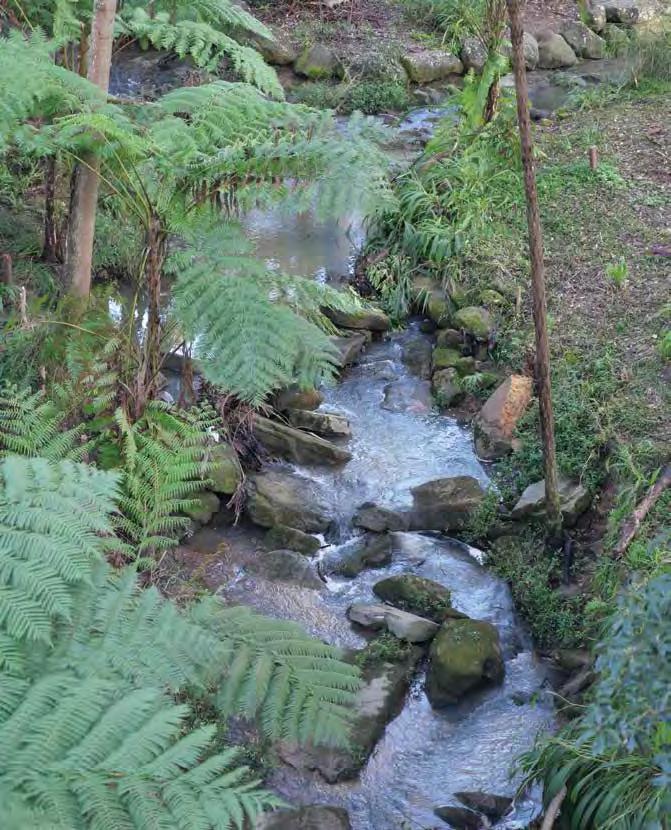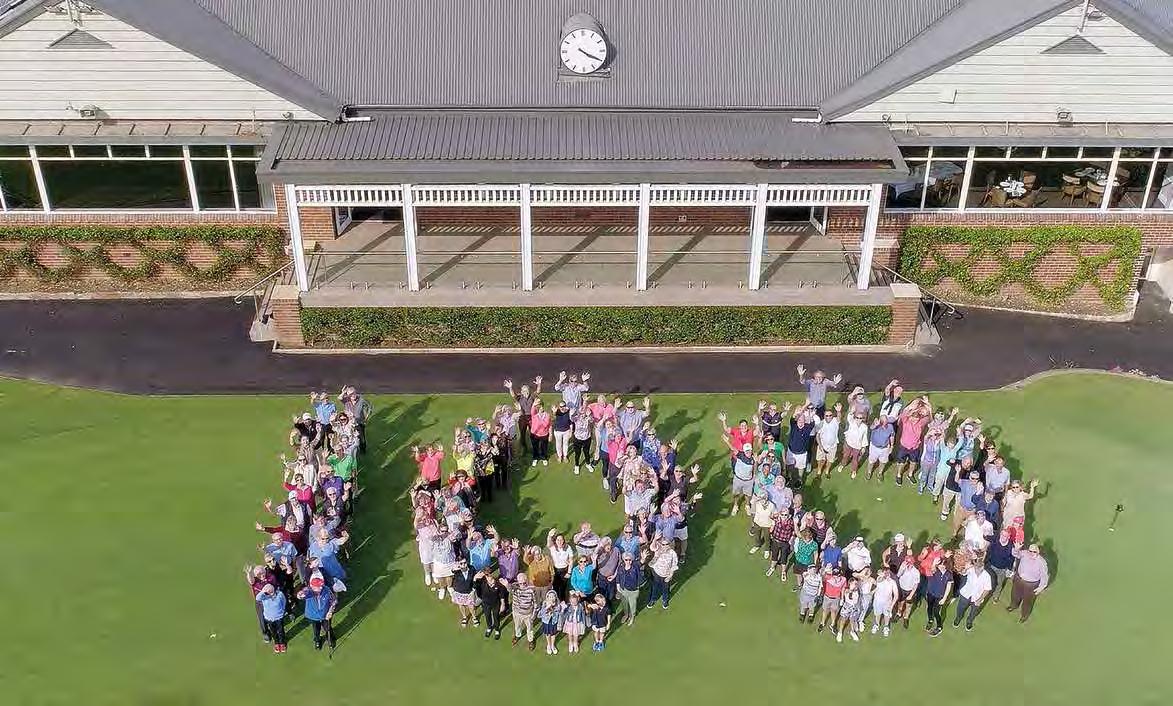




We are fortunate to belong to a golf club that celebrates its first 100 years with enthusiasm and pride. Joan Eyles has written this, the fourth publication on the development and history of Pennant Hills Golf Club. She properly cites in appreciation the first history written in 1959 by Ernie Hyde who was President from 1933 to 1953 and the second being an update of the intervening 30 years by Bob Giblin in 1988. The third history was penned by Ron Harper commemorating our Diamond Jubilee and published in 2000.
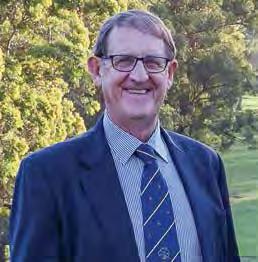
Ron Harper, Ann Crisp, Adrienne Gorme, together with the energetic Bruce Jones, deserve special mention as they are responsible for the systematic curating, classification and digitisation of our records that have provided such a reliable source for Joan to chronicle the stories and events in this book. That our history is so well preserved is due in large part that members care about their club.
We have a rich and varied history.
Our course was not the creation of a single designer, it was carved out by the members themselves. One of the strengths that emerges in the 100-year story of our Club is member involvement; members volunteering, members giving. Joan has captured this in a thoughtful way. The book takes us back through the fascinating journey of growth and development.
The legacies of camaraderie, respect, inclusiveness and integrity live on. These values challenge us to continue the culture of contributing, ensuring that in 2123 the membership at that time will reflect on the second hundred years with the same pride as we have in the builders and shapers that have fashioned the first 100 years.
We are a leading Sydney private members golf club, we own the land on which our great course and club is built, we enjoy strong bonds of friendship and take pride in our membership. It is time for a celebration. Let the next 100 years of golf and enjoyment begin.

Welcome to Pennant Hills Golf Club, established in 1923.
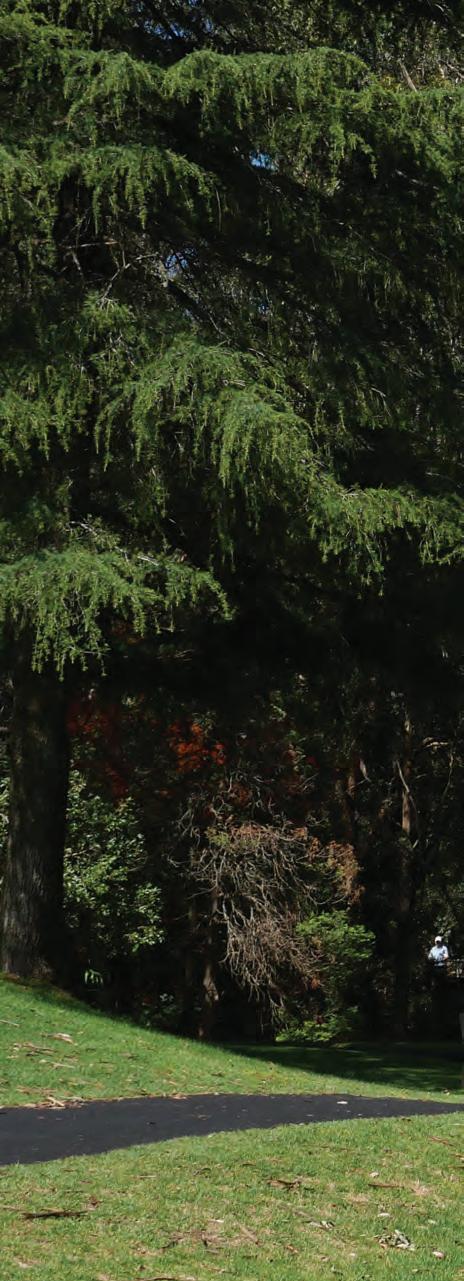
The history of our Club has been well documented over the years. The first history was written by Ernest J Hyde, a founding member and later President and Life Member, titled The Story of the Pennant Hills Golf Club 1922 to 1959. The second, by Robert N Giblin, The History of the Pennant Hills Golf Club, retraced those steps and covered the years through to 1988. The most comprehensive history, Golf in the Pennant Hills District, was compiled by Ron Harper and published in 2000. At the instigation of then Vice President Bruce Lumsden, the Historical Interest Group was formed in 2002 to catalogue Ron Harper’s working notes. Ann Crisp and Adrienne Gorme took up the challenge of collating and maintaining information and memorabilia relating to the Club’s history. Ann has been assisted by a number of members since then. More
recently, Bruce Jones has been working to digitise the entire records collection making much of the information held in the archives more readily accessible.
It is by the efforts of these members, and others who have contributed their stories, that we can now take you on a fascinating journey through a century of growth and development, highlighting some special events that shaped us into the wonderful Club we enjoy today.
In collating this history, I especially want to acknowledge Bruce Jones for his invaluable support with both research and photography.
Joan Eyles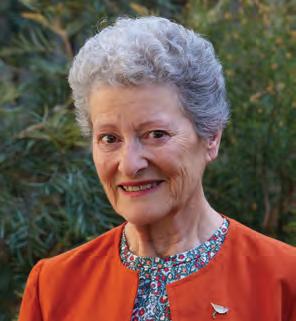
November 2022
We acknowledge the traditional custodians of the land upon which the course is located, the Wallumedegal people of the Dharug nation.


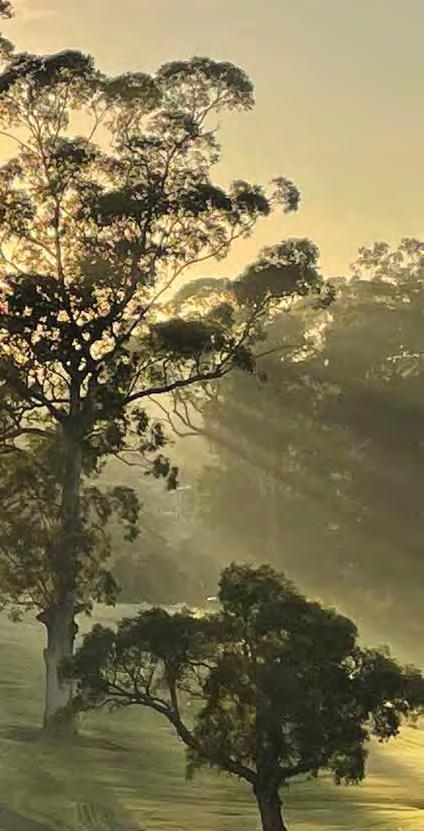
The first steps towards establishing a golf club at Beecroft were taken in April 1906.
Asmall group of enthusiasts led by Dr MC Lidwill first set out a course on a paddock on Beecroft Road, Cheltenham. By June, the new Beecroft Golf Club had secured the use of land between Copeland Road and Mahers Road, Beecroft, and a 9-hole course was soon in play. This course was on the land currently occupied by Pennant Hills Golf Club. However, by April 1910, the landowners required the land for other uses and the club, after a brief move to Normanhurst, was soon disbanded.
At the end of World War I, the BeecroftCheltenham area, previously dominated by small farms, was being subdivided into generously sized blocks with large homes and more modest villas being erected close to the railway station. Churches were built and a new School of Arts became the focus for a large range of activities.
The idea to build a new golf course at Beecroft was the brainchild of Dr Arthur C Holt who had set up a medical practice in Beecroft in 1913. He encouraged a number of prominent residents to attend a meeting in the Beecroft School of Arts on the 10th September 1922 to float the idea to the community of forming a golf club in the neighbourhood. Dr Holt was elected to the first Presidency of the new club. The meeting was chaired by Robert Vicars,

a local businessman, and at the end of the enthusiastic discussions a committee of three was formed to locate a site for a golf course. The present area of our course was inspected but the committee rejected it because of its somewhat hilly nature, great tree growth, and the considerable amount of playing area that would be lost because of the creek flowing through the eastern end.
However, Robert Vicars decided to do something bold to bring the proposed club into being. He contracted to buy the land for £4,750, equivalent to around $400,000 today, then offered it to the Club for the same price. This offer quickly brought matters to a head and the committee accepted. Robert Vicars is revered as one of the Founders of our
Club. He was made a Life Member in 1947 and the clubhouse now includes the Vicars Room as one of its lounges.
The new Club was constituted as an ordinary shareholding company with shares of £5 value. Each member joining the Club was required to take up one £5 share which was regarded as an entry fee. The newly established Board of Directors calculated that an outlay of £2,500 would be sufficient to build a 9-hole course and a clubhouse.
Pennant Hills District Golf Club Limited was registered on 26th February 1923.
The first Ladies Committee meeting was held on 22nd February 1924. Mrs Violet Vicars, wife of Robert Vicars, was elected Lady President.
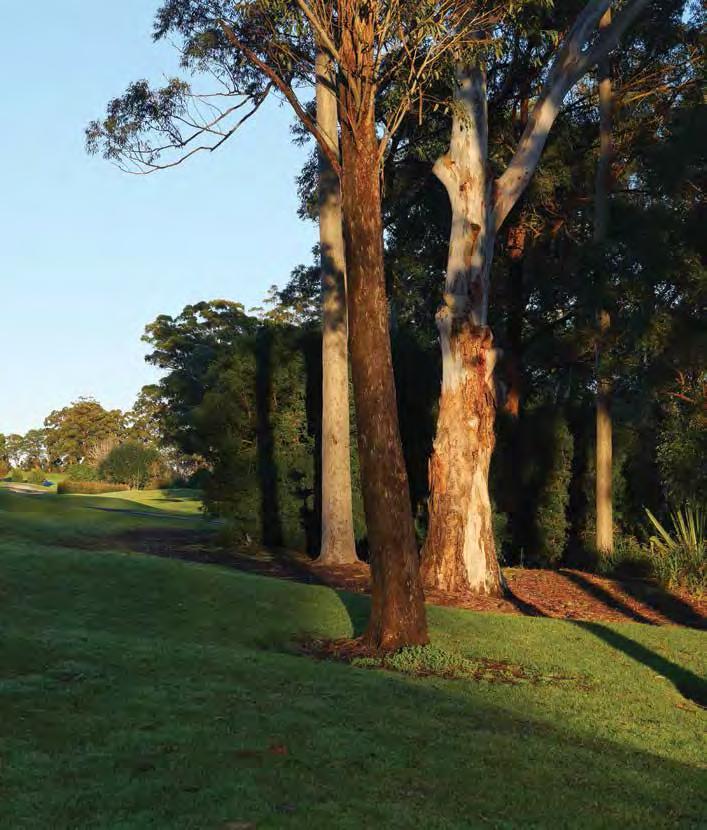
HE CONTRACTED TO BUY THE LAND FOR £4,750, EQUIVALENT TO AROUND $400,000 TODAY, THEN OFFERED IT TO THE CLUB FOR THE SAME PRICE.
the course overall remains the brainchild of the members.
The first task was to build a temporary 9-hole course so that golf could be played while plans were being made for an 18hole course.
Ernest J Hyde joined the Club in 1923 and is regarded as contributing more outstanding service to the early development of the Club than any other person. He was President from 1933 to 1954 and was also involved at both State and Federal levels of golf.

He recalled the pioneering days:
“Of the land area of about 99 acres, some 25 acres along the Pennant Hills Road from Copeland Road to Mahers Road with an average depth of 300 yards had been farmed and cultivated since the early days of the country. It was on this portion of the area that the first nine holes were played.
A farm house and a well were situated on the present third fairway and until the latter was filled in - this job took some time - this portion of the area could not be used. A sunken road ran from Pennant Hills Road to the dam and this caused a lot of inconvenience in play until it was ultimately filled in. The slight depression on the present twelfth fairway is the only indication left of its existence.
The remainder of the area was covered with hundreds of trees and stumps which had to be removed, waterholes had to be filled up and in many places shelf rock excavated. In addition, noxious weeds and pests infested the area and it was obvious that a great amount of work would have to be done before an 18-hole golf course could be constructed.
The only preparation for play was to run a lawn mower over those places selected for greens without any attempt to build up or improve them, and they provided some weird putting surfaces.“

This layout of the first 9-hole course was drawn by EJ Hyde. Play on this course commenced around the Easter of 1923. The length was 2035yds (1860m) with a par of 33.
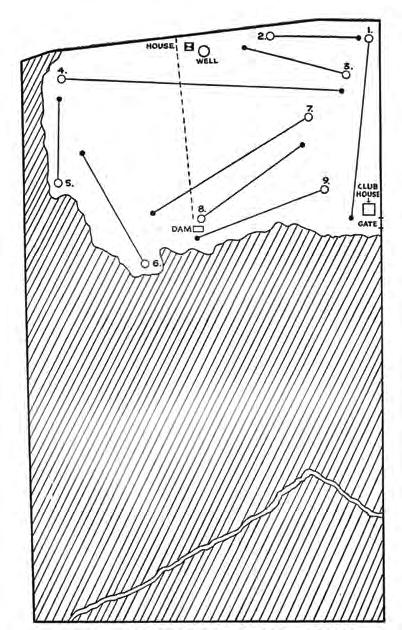
Despite the crudity of the layout it was regarded as temporary and was played for about 15 months. Hyde recalled that “members and associates seemed to enjoy the picnic atmosphere which prevailed. The important point was that they had great faith in the future of the club.”
Committee Minutes recorded that by May 1923, membership was 35 men and 8 women. The first two junior members joined in June of that year.
Women golfers played the same course as the men for the first few years. As the course was lengthened, the tees that were left behind were designated as ladies’ tees and on some holes new forward tees were constructed.
EJ Hyde’s original 9-hole course layout. Hole lengths:
“Mrs Flynn, who lived on Mahers Road, made it plain to players at the 4th green that they were welcome to come across the road to have a free drink of water from her well. Thirsty players on a hot day took advantage of her offer. Soon, crossing the road for a Devonshire tea at Mrs Flynn’s became the “thing to do”.
The first 18-hole course was laid out by committee members with the assistance of Tom Howard, a professional golfer and 1923 Australian Open Champion. He became involved in advising the Directors at a very early stage, having been paid one guinea for “professional services” in April 1923.
Tom Howard, 1923. He assisted with the layout of the first 18-hole course.
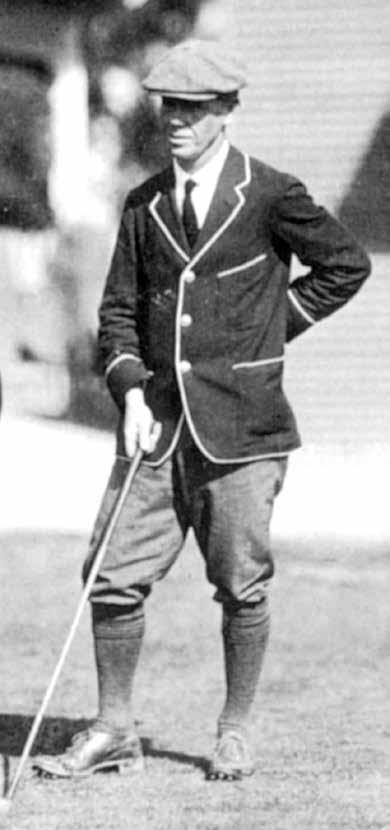
1923. Looking across the (then) first fairway to the original clubhouse.

years
As EJ Hyde remembered:
“It was decided to use the area on the northern side along Copeland Road to [Devlins] Creek... Contracts were let for clearing the present first, sixteenth and seventeenth fairways of trees and other obstructions, small couch greens were formed for the first, second, sixteenth and seventeenth holes, and the ground cut out from the eastern bank of the creek to form the eighteenth green. … Whilst this progress was being made a large amount of work was being carried out by the members in working bees, individually clearing the scrub, removing the stumps and filling in the holes and wells. The removal of stumps was a most difficult task employing the use of a forest devil and chains.”

The Forest Devil and a 12” Shanks lawn mower were purchased in October 1923. As well, a local plumber was contracted to lay town water to all 18 greens. Two months later with a bank balance of only £35/13/10, all staff were laid off. The financial situation must have recovered quickly however as by February the following year course improvements were again surging ahead aided by donations from the Ladies Committee and several founding members.
On the land that had been cleared for farming prior to 1923, the Club planted many trees. While it is not possible to determine the exact number, Club records reveal that prior to 1940 well over 600 trees had already been planted.
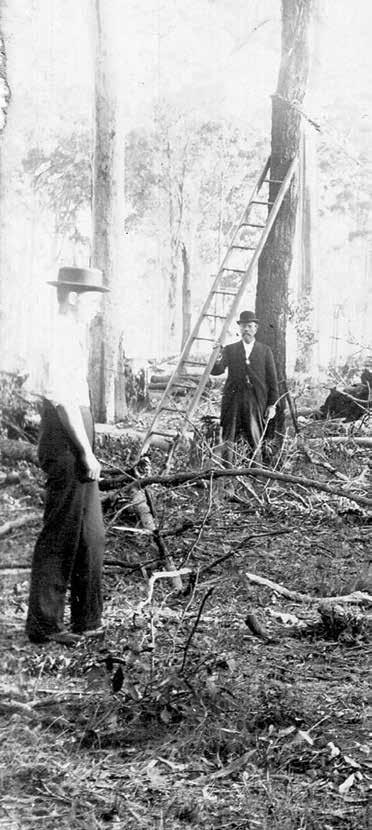
The Club’s constant commitment to preserving and improving the indigenous tree species of the area is clearly stated in Club records throughout our history.
The Forest Devil in action. Harry Hazelwood, a member, in the foreground.

An 18-hole course, with some temporary greens, was ready for play on the season opening day in March 1924, but it wasn’t until June that all the greens were completed and the first 18-hole course was officially opened for play.
The principal golfing journal of the day, Golf in Australia, in its April 1924 edition, described the new course. Perhaps it sounds familiar.
“On Saturday, March 22nd the full course of eighteen holes was opened for play. The links are, as well as being the prettiest around Sydney, also the most interesting to keen golfers. The first hole is played over a deep gully with a creek running through it, and to the novice the first shot presents all the excitement of a great adventure. Members have been known to spend the afternoon in the gully on a voyage of discovery, and it is rumoured that a treasurehunting expedition, properly equipped, would meet a rich reward. The present scribe has personally contributed largely to the buried treasure. The last hole is also played across this gully, but members appear to have profited by experience on their return, or else have developed more power in their elbows but this hole can be an easy three or a bad twenty.
The rest of the course presents its fair proportion of easy situations and difficulties, and it is noted with pleasure that the quality of play in general has much improved, although experts note a tinge of blue in the atmosphere, and corresponding warmth in the temper of players.
There is still room for new members. When residents awake to the charm of their own particular links and understand what an excellent and congenial crowd meet there, it is confidently believed that it will not be long before the “house full” notice will be necessary.
Situated on the high lands overlooking Beecroft and on the main Pennant Hills Road, the links present a most charming and delightful natural picture. With an area of 97 acres ample room is provided for a most excellent course of 18 holes.”
With the new holes in play bringing the course close to the eastern boundary, it was felt that a decent clubhouse should be erected. It was decided to build a brick clubhouse on the high ground above the east side of Devlins Creek and near the 1st tee, at a cost of about £3,000.

It was appreciated that this 18-hole course was only the first step towards the final layout. The longer-term plan for the course was to use as much of the land area available as funds and resources would allow.
IT WAS NOT LONG BEFORE THE FIRST COMPLAINT OF SLOW PLAY WAS PRESENTED TO THE COMMITTEE.
IN NOVEMBER 1924, MR CHARLES WRIGHTSON REPORTED CONGESTION ON THE COURSE ON SATURDAY AFTERNOONS. IT SHOULD BE NOTED HERE THAT ON THE PREVIOUS SATURDAY THERE HAD BEEN A FIELD OF 26 MEMBERS AND 9 ASSOCIATES.
1924. The waterhole, looking east. 1924. The 18th green from the tee.

Pennant Hills ranks as one of the oldest established golf clubs in Sydney. Only six have maintained an 18-hole course, on the same site, for longer. They are: Royal Sydney 1904
The Australian 1905
Killara 1907
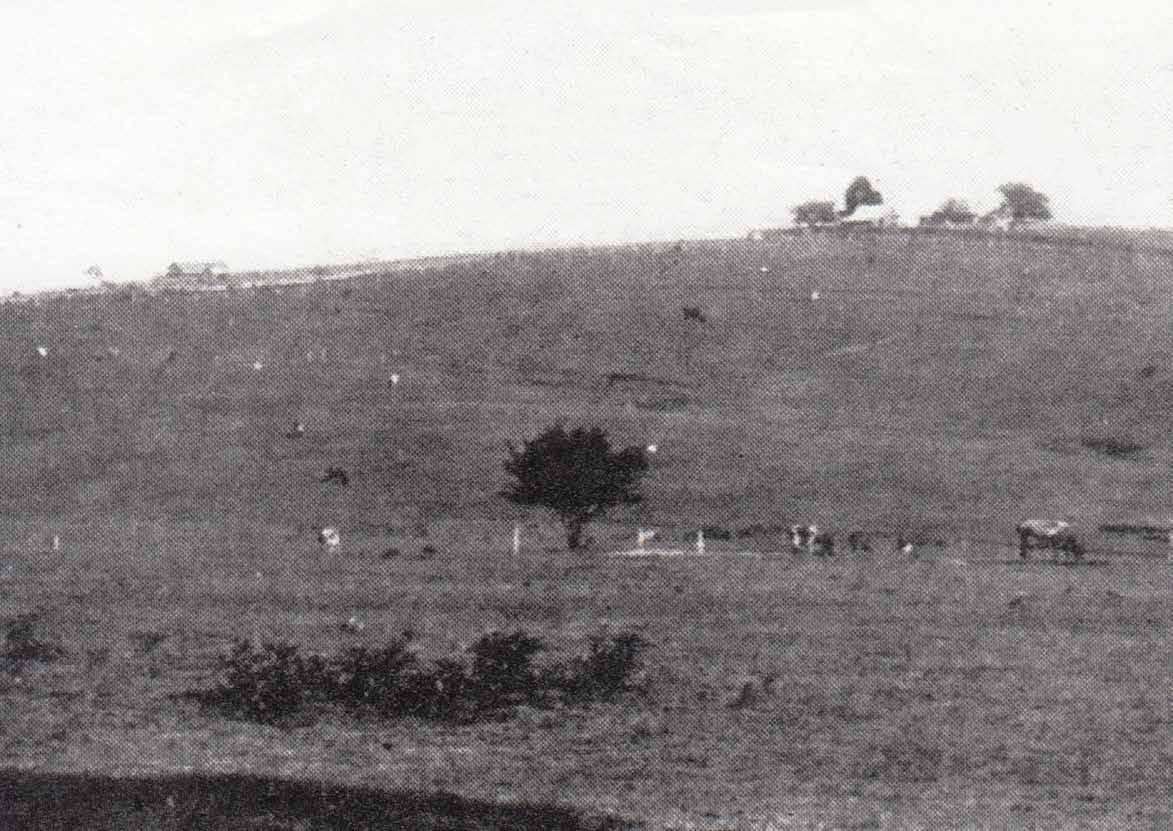
Concord 1907
Manly 1909
Moore Park 1922
This view, published in Golf in Australia April 17, 1924, looks towards the intersection of Copeland Road and Pennant Hills Road.
The picture clearly shows the nearly tree-less farmland where the first 9-hole course was laid out.
The blue gum towards the right of the photograph is beside the water hole which is close to the current 14th green.
In the photograph a dozen or so milking cows can be seen wandering around. The club obtained extra revenue from the local dairyman who paid £80 per annum for agistment. The white dots are fence posts supporting the three-strand wire fence protecting the couch greens from the cattle. In play, it was considered within the rules to allow your opponent to replay his shot should it strike one of these posts.
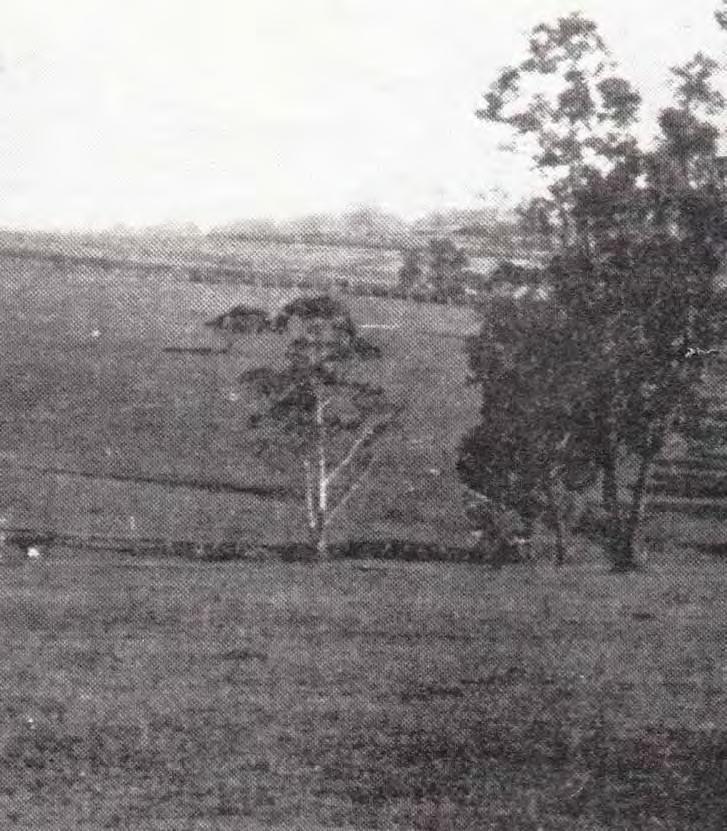



The new 18-hole layout brought with it the problem of crossing Devlins Creek on the 1st and 18th holes. The difficulties were overcome by placing four railway sleepers across a narrow section of the creek, close to the present cart crossing. This left a steep decent and climb on either side. A missed putt on the 1st green was forgiven as it was considered to be a “puffing putt”. After heavy rain the first players out were often tasked with replacing the sleepers which had washed away. We are told that many a pair of plus-fours were “baptized” in the process.
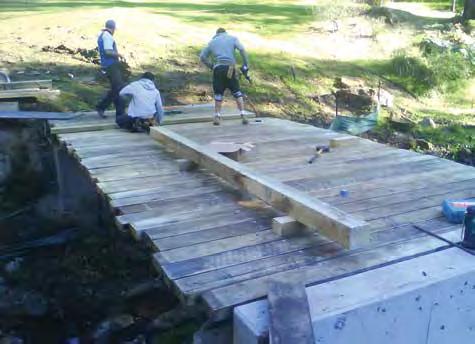
The sleepers were replaced with a lowlevel wooden bridge in 1929 and then a more substantial bridge in 1936. It was not until 1961 that a high-level steel and truss bridge for foot traffic was erected.
The old low-level bridge on the 1st fairway built in 1936. Photo taken in 2008. Replacing this low-level bridge in 2009. 2016. The new bridge.

By 1925, more land had been cleared, extending the course, and another two fairways crossed Devlins Creek, the 11th (now the 9th) and the 12th (now the 10th).
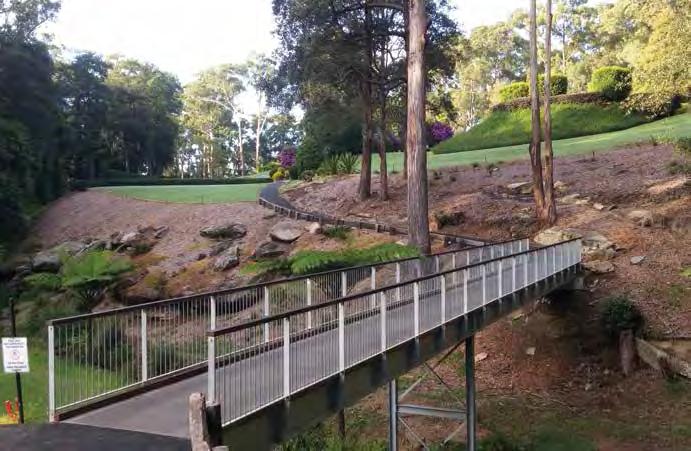
The wooden foot bridge at the 9th, pictured here, was replaced by a higherlevel bridge in 1940. That bridge was replaced in 1985 by a ‘temporary’ steel and timber bridge. It was not until 2016 that the ‘new’ bridge was finally built.
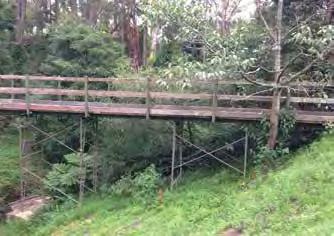

Circa 1925. Crossing Devlins Creek at the 9th. EJ Hyde and son John.
The ‘temporary’ bridge pictured here in 2014. 2016. The new bridge.
years
In 1927, a suspension bridge to cross Devlins Creek on the 10th fairway was erected.
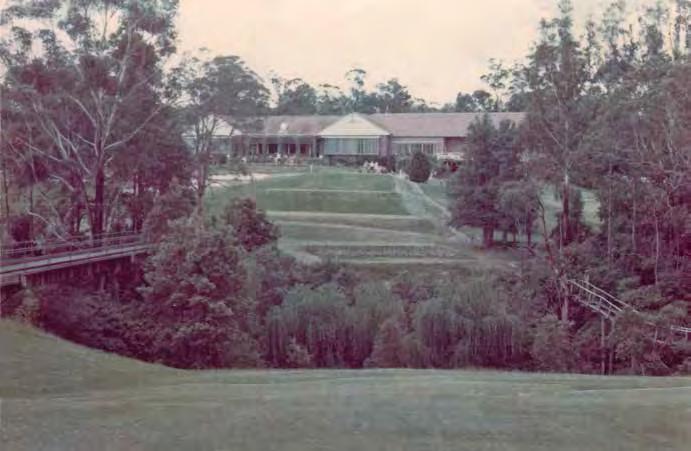
Ron Waddell, who joined in 1951, remembers, “the old suspension bridge over the 10th gully was at first supported in the centre only. Later wooden supports were added a few yards from each end, which stabilised it a little more. Nevertheless, some of the members had great fun lagging behind a little until the rest of the group were half way across, then jumping wildly up and down causing the bridge to sway and lurch in a sickening manner”.
The suspension bridge pictured here in 1955.
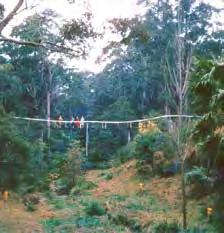
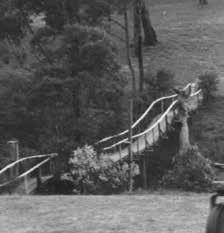
And in 1964. This bridge was finally replaced in 1965. Storm damage in December 2018. It was 12 months before the bridge was reopened.
Circa 1970. Showing both the new bridge and the suspension bridge crossing Devlins Creek.

From the Committee Minutes and AGM reports it is clear that during the 10 years after the first 9-hole layout, the course was in an almost constant state of development. Following the first 18hole layout there were essentially another three 18-hole layouts. The early versions suffered from the course being too short overall and the hole sequences had many shortcomings such as sequential par 3s. While improving the condition of the greens, teeing areas and fairways continued, the ultimate aim was to lengthen the course to a championship standard.
Circa 1929. From the 12th tee (now the 10th).
From a similar location on the 10th tee, December 2021, Rob Stevenson watched by Greg Hargreaves and Phillip Johnson.
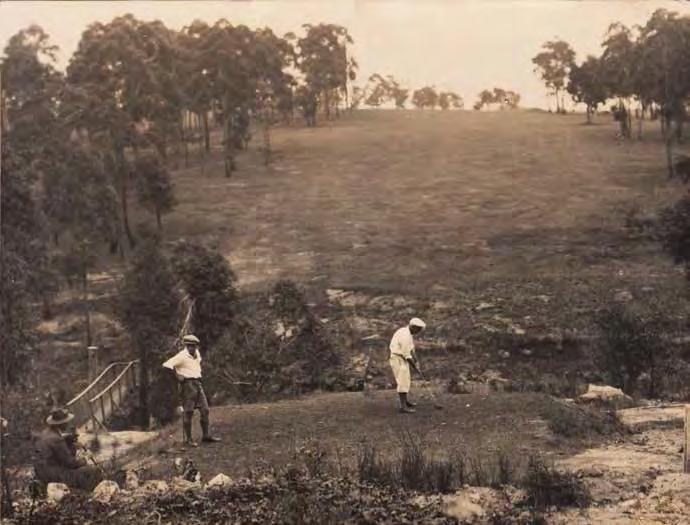

| Par 33
course with temporary greens open for play
New 6th hole opened and 1st hole lengthened 5725m | Par 71
16th hole lengthened to form a dogleg, adding 71m to length
Greens and bunkers rebuilt and more bunkers added

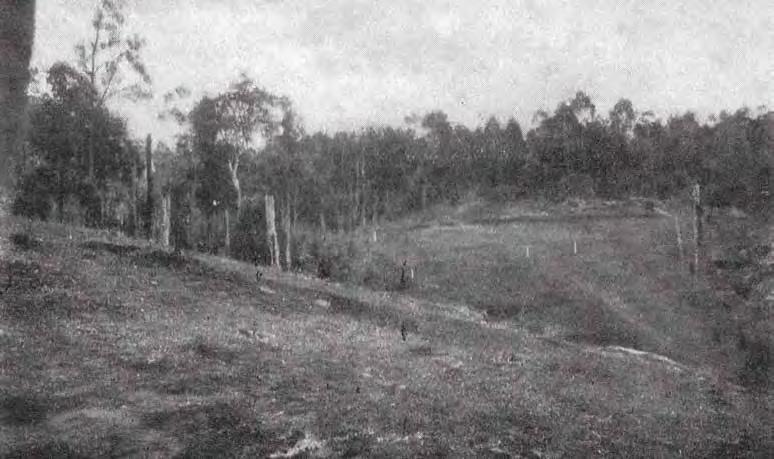
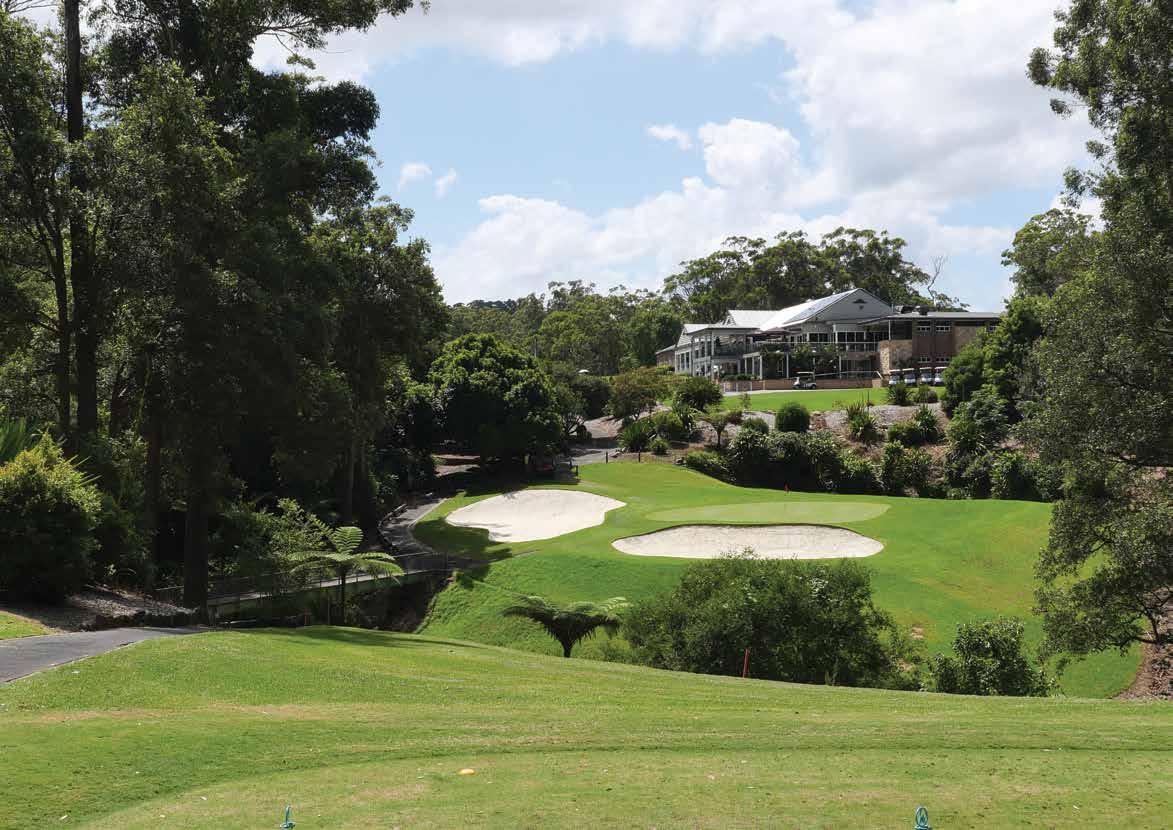
Circa 1928. The 18th tee and green. A new green, higher up the hill, was constructed in 1933, doubling the length of the hole to 175 yds (160m).
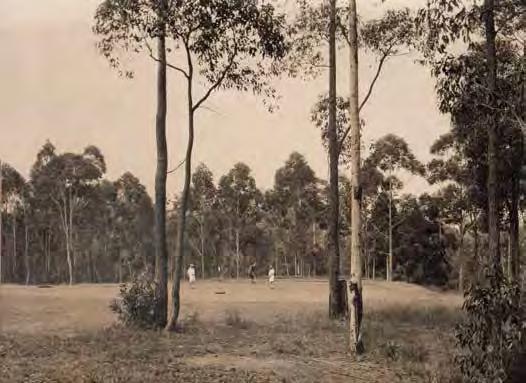
Circa 1930. Players putting on the 6th green (now the 5th).
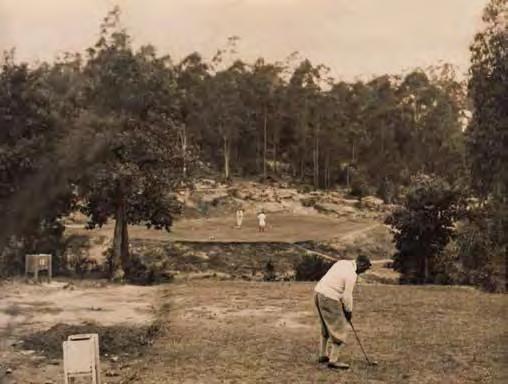
A significant milestone in 1929 was the design of the new greens at the 11th (now the 9th) and the 18th incorporating the first green-side bunkers on the course. When first introduced these traps were not popular with the majority of members who were convinced the course was hard enough already. The greatest difficulty in exiting the bunkers was that players needed to fashion a new range of shots using their existing lofting clubs. There would have been much discussion on the subject. The most commonly used club was the hickory shafted “basher”. No doubt part of the problem was that the sand wedge was not developed until 1931 by Gene Sarazen. Today there are 51 green-side and 12 fairway bunkers on the course, and they continue to be a topic of much discussion.
years

As early as 1930 a motor mower with a set of quintuple blades was used for the first time. This gave the course a well-groomed appearance - except for the rough. Paspalum was such a curse that a local rule allowed for the plucking of stalks. This was a sticky and unpleasant job and was often a task given to the young caddies. A reaper was then purchased to cut the area beyond the fairways but paspalum remained a problem for many years.
The magazine Golf in Australia reported in December 1927:
“The rough is at its very roughest just now and balls off the fairway are hard to find. But a visit to the long grass holds another terror as bad as the possibility of being “lost”.
Golfers are a bright and intelligent race, so perhaps one of them will yet discover a way of removing grass seeds from the rough other than by the medium of the stockings and person of the player”.
The Club, along with all others, felt the effects of the Great Depression. Membership fell rather seriously but despite this drawback the Committee decided that the work of improving the course was to continue. In October 1932 another scheme for increasing the length of the course was approved. This layout provided for the playing of the existing 2nd green as the 1st, significantly lengthening the 1st hole from 155yds (140m) to 500yds (450m). This change required the construction of a new hole, the current 6th. The new course was first played in March 1934. It measured 6261yds (5725m) with a par of 71.
This was just 10 years after the opening of the first 18-hole course. The layout has changed little in the following years, but major improvements to the course were still to be made.

Circa 1943, looking east with Pennant Hills Road in the foreground. The Club Minutes of June 1937 note that 285 trees
been planted.
 Circa 1931. The 10th green looking back towards the clubhouse (inset). Colourised by Bruce Jones.
Circa 1931. The 10th green looking back towards the clubhouse (inset). Colourised by Bruce Jones.


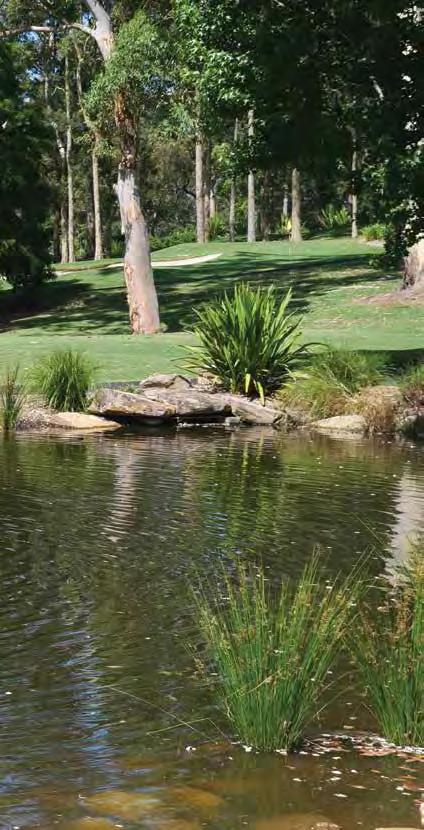
By 1939, after more than a decade of hard work, clearing and planting trees, building greens and bridges, and improving the fairways and rough, the course had evolved into one now considered to be among the prime courses in Sydney and certainly a ‘jewel’ of the northern region of Sydney.
By now the course had achieved its objective to be of championship standard and attracted many visitors.
However, the effects of the Great Depression and World War II slowed down further development. Of course, the war years had a direct impact on club membership as many went away to serve, and also on club finances. In fact, for several years George Howard was the only man looking after the course. His duties included the catering, so Howard was at this time Club professional, head
groundkeeper, caddy-master, caretaker and caterer. He worked wonders on his own but clearly it was beyond one man’s ability to properly maintain a complete golf course and consequently the course gradually deteriorated and was somewhat run-down by 1948.
In 1951, the Club was in a healthy but static condition when two very significant things happened. While EJ Hyde was still President, Alex Marks commenced duty as Club Secretary, and Vince Church was appointed Head Greenkeeper.
In his 28 years as Secretary-Manager, Alex Marks endeared himself to the members and made Pennant Hills a wonderfully warm club to belong to or to visit. He ensured the Club ran with efficiency at every level. During his time, an air of greater informality started to develop and with the encouragement of Hyde and subsequent Presidents, Marks encouraged the friendly spirit and camaraderie within the Club.
In these early post-war years, the Club saw a surge in membership.


In 1951, Vince Church was appointed as Head Greenkeeper. Vince tells of the course condition when he joined: “We had 8 or 9 temporary greens, often referred to as ‘Tipperary Greens’…. They were shockers many of them were out of reach of hoses and became mostly sand greens”. In his 27 years at the Club, he oversaw great improvements in the course and Pennant Hills gained a reputation as one of the best-groomed courses in Sydney. Such was the Club’s appreciation of his service that when he retired he was made an Honorary Member. To list some of the major developments during his tenure: two new high-level bridges were constructed over the gully, new teeing areas were constructed for seven fairways and many bunkers were added or rebuilt. Trees were planted to delineate fairways, water outlets were supplied to all fairways and a pitch and putt practice green was added at the southern end of the clubhouse. He was regarded by his peers in the industry as the doyen of turf management in Australia. He had strategies that were far in advance of other superintendents of his era and was at the forefront of the creation of new ideas and methodologies at which he was, without question, an expert.
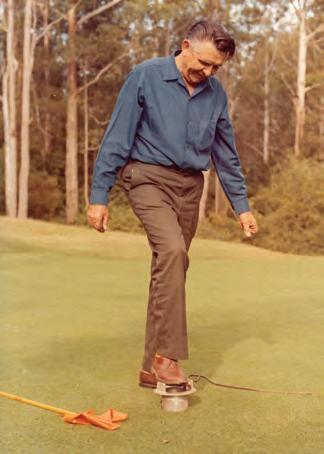
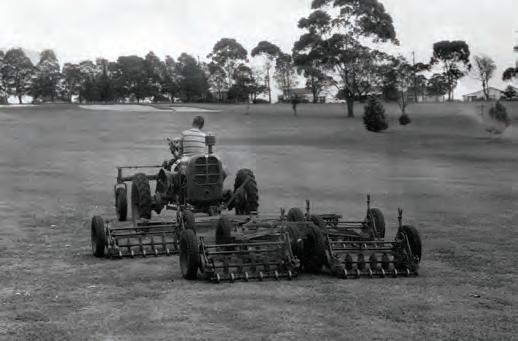
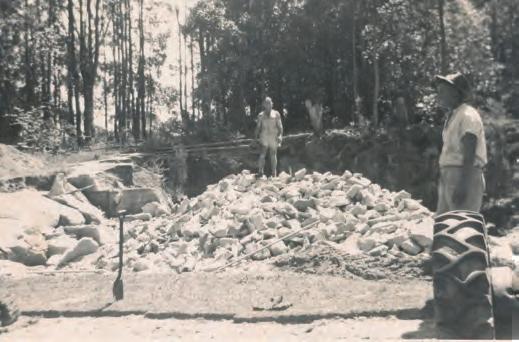

“WHAT – NO WAND! This you won’t believe. Popular Ex-Servicemen’s Hon. Sec. – Lee Chater to wit – sliced off the tenth one recent Saturday found his ball, and whilst identifying it caught with his hot little hand one perfectly good and alive rabbit. Lee would have thought nothing of it, but not so partner Clive Quinton. Presto – rabbit stew at the Chaters.”
(NEWSLETTER, JUNE 1952)
1952. Extending the 9th green. 1951. The 18HP Ferguson tractor and five-gang mower on 11th fairway. Circa 1970. 9th green from the former ladies tee.Through the 1980s, the course was again showing signs of deterioration, in part due to the unknown effects the proposed M2 Motorway would have on the course and the understandable reluctance to spend on infrastructure.
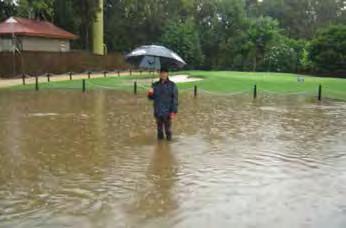
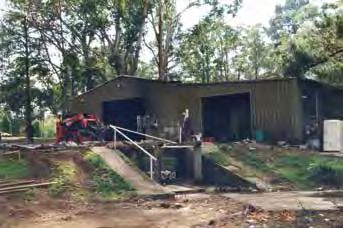
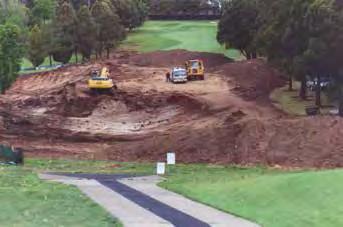
Richard Kirkby was appointed Course Manager in 1994 and was charged with the task of rejuvenating the course. His exceptional skills were evident as in a very short space of time the course was reportedly in better shape than ever. Richard retired in 2022. In his 28 years with the Club he oversaw major changes to the course including the Water Reclamation Plant and the realignment and reshaping of the 3rd and 5th fairways following the completion of the M2 Motorway. All the bunkers were rebuilt and the enormous challenges of irrigation and drainage were addressed. Richard oversaw the landscaping of the fairways and gardens to produce a truly beautiful golf course. Richard is highly regarded amongst his peers and served as the Vice President of the Australian Golf Course Superintendents’ Association for 4 years and Education Co-ordinator of that body for 7 years. He was appointed a life member of the Association in 2021.
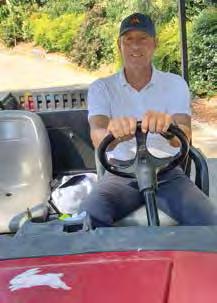 1995. The old maintenance shed.
2017. Richard Kirkby in a flooded car park.
2003. Earthworks on 3rd fairway.
1995. The old maintenance shed.
2017. Richard Kirkby in a flooded car park.
2003. Earthworks on 3rd fairway.
On a bright Sunday morning, 25th June, 1972, Peter Tressider had the honour on the 3rd tee. He was about to tee up when he observed a small plane silently flying low over the trees to the left of the fairway, it banked sharply right, heading in his direction. His playing group “chose to run across the fairway to a clump of trees…[the plane] eventually struck the ladies tee and then struck the tee we had been standing on, smashing into our golf buggies. It careened on, crashing to a stop…on Copeland Road.” The pilot and all five passengers were injured.
Another light plane landed on the 3rd fairway in 1984, coming to rest just behind the 2nd green. Fortunately there were no casualties on this occasion.


And then there was the unexpected landing of a hot-air balloon, again on the 3rd fairway, in 1986. There were no injuries. The balloon had taken off from Parramatta Park.
1972. The first plane to land on the course. 1984. The next plane crash. 1986. Hot-air balloon landing.
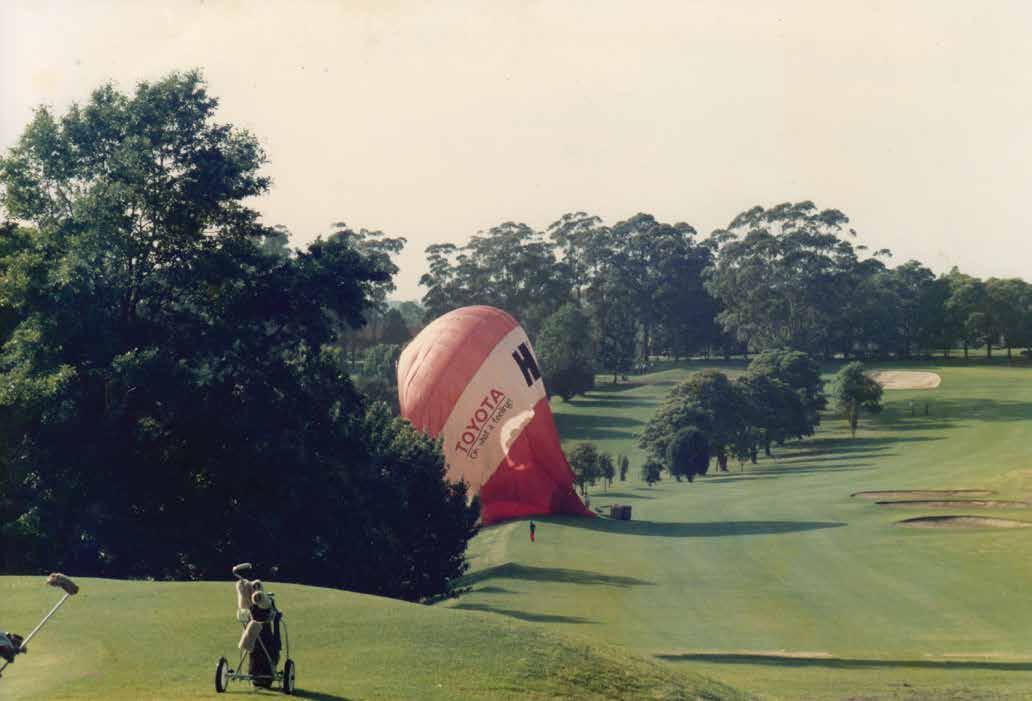

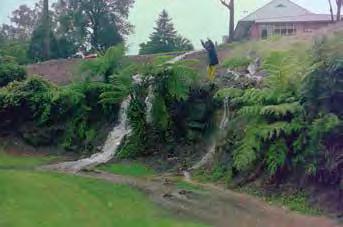
When the first golf course was laid out in 1923 town mains water was laid on to allow hand-watering of the greens and possibly the teeing grounds. There was already a small waterhole near the current 14th green and over the years, particularly during drought periods, water was pumped from there to the parched fairways.
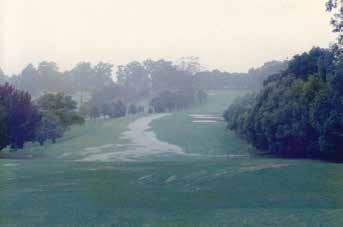
However, lack of irrigation was a major ongoing problem and so, in August 1941, a dam was constructed near the current maintenance facility.
As Ron Waddell remembers: “The dam at the side of the 17th fairway was a popular swimming hole in those days. On a hot summer day up to forty people could be seen in and about the hole. The hole would have been over eight feet deep as swimmers would dive into it from a high branch of an overhanging willow tree. The members did not object, and access by the swimmers was easy, as only a twostrand wire fence enclosed the course. We caddies could only look at the swimmers and dream, as we struggled through to the end of the round.”
1988. The 3rd fairway.
1999. Behind the 9th green.
2007. The 13th and 14th fairways.
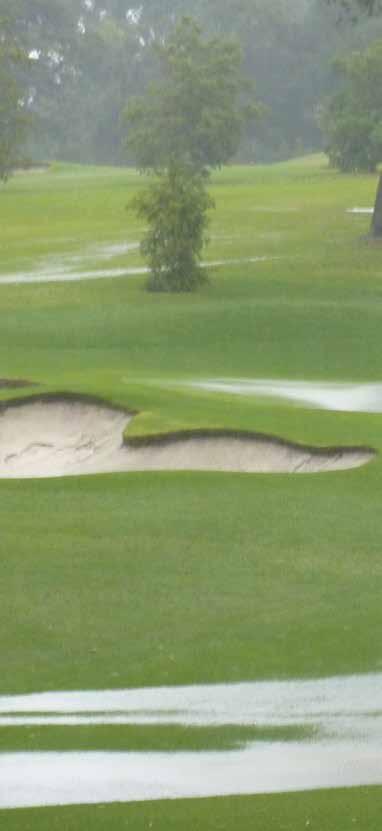
Over the years there were several attempts to secure a permanent supply of water to either replace or augment the reliance on town water. In 1942 the services of a water diviner proved unsuccessful. Later there was a proposal to dam Devlins Creek but this would have encroached on the 6th fairway and the plan was abandoned.
From 1937 to 1945, there was a severe drought state-wide. In March 1940 the Committee made a local rule that balls lodging in a crack in the ground could be lifted and dropped without penalty. In December that year, as a water saving measure, hot water was disconnected from the showers.
In the mid-1960s the need for a supply of water and its reticulation was most obvious during another prolonged drought. Jimmy Turner, a member for 50 years, recalled the fairways drying up so much that cracks appeared. He said that these were most evident on the 5th and 11th holes, where balls could disappear as deep as 15 inches (40cm) into the cracks.
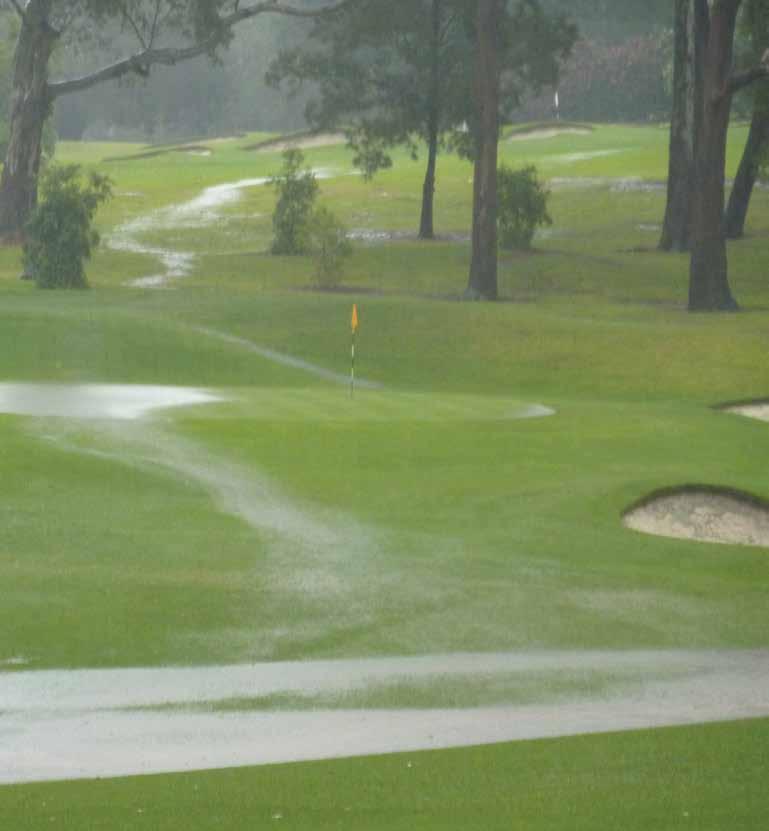
As early as 1966 there was a proposal to use water from the sewage system running through the course, however, the cost at that time was prohibitive and there were also environmental concerns about water quality. The idea was deferred indefinitely.
In 1996-7, a new automated irrigation system was installed providing water to all tees, fairways and greens. At the same time, distances to the centres of the greens were marked on the sprinkler heads. However, a secure water supply, other than town water, was at the top of the Club’s wish list in 1999.
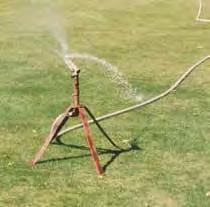
– the number of days the course was closed between February and the end of July in 2022, when an extraordinary La Niña weather pattern dumped a record amount of rain on the east coast of Australia.
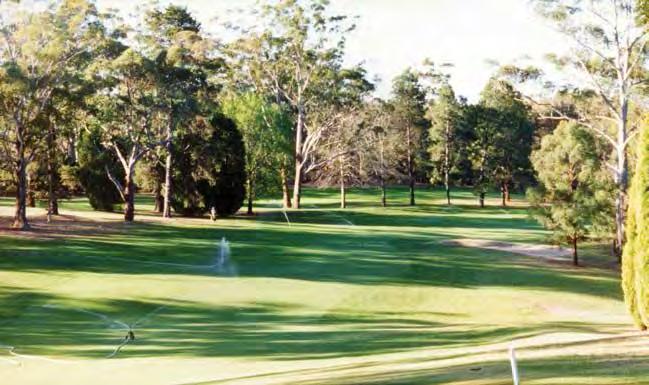 1994. Sprinkler system on the 17th fairway.
1994. Sprinkler system on the 17th fairway.
Town water piped to 18 greens.
Dam on Devlins Creek near 6th used to supply water.
Dam constructed near current maintenance shed.
Water diviner employed but not successful.
Proposal to mine sewer pipe in Devlins Creek rejected.
Search for bore water not successful.
Proposal to construct dam beside 17th fairway rejected.
In 2003 at the height of a major drought, Sydney Water informed the Club that there would be no potable water available for course irrigation in the future. Richard Kirkby managed to negotiate an extension to existing arrangements, which allowed the Club time to explore options such as to dam either Devlins Creek or the gully between the 17th fairway and 18th tee, or treatment of sewerage from the line running down Devlins Creek.
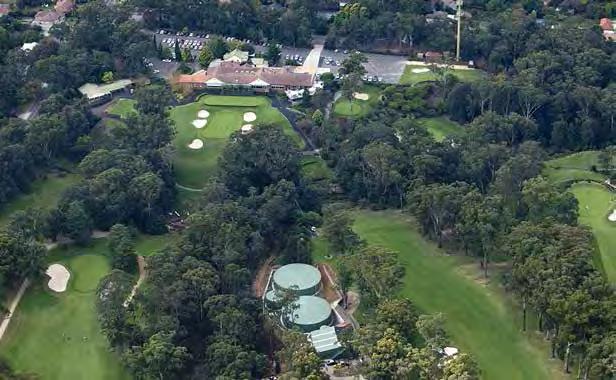
Steve Walker, then Club Vice President and later President, took on the role of chairing a planning committee tasked with finding a solution to our long-term water security. A dam had the least chance of achieving this because of the limited capacity given the topography of the site and also council objections. Together with Stuart Fenton, the General Manager, plans to mine the sewage system were revisited and proposals were prepared by Water Technology Australia. This time, with changing attitudes and improved technologies, the plans were approved.
Steve Walker was the driving force behind, and management of, this huge project. Working with Stuart Fenton, he negotiated a grant of $1.1m from the State Government Water Savings Fund and a further $60k in Federal grants to assist in financing the project.
The Water Reclamation Plant, completed on time and within budget, was officially opened on Friday 30 May, 2008. The sewer mining project was the first of its kind for a privately owned golf club in Australia. The plant produces up to 100 million litres of reclaimed water for irrigation each year. Without it we would not be enjoying the course as we know it today.
In 2016, talks commenced with NorthConnex concerning the possible use of water run-off from their tunnel running adjacent to the golf course. In 2022, good progress has been made and plans have been provided to divert the water to the Water Reclamation Plant so that the treated water can be applied to all parts of the course. Some obstacles remain but completion of this project will make the Club self-reliant for water.
In 1965 the Club was first advised that the Mahers Road and Pennant Hills Road frontages were likely to be affected by a Department of Main Roads (DMR) plan to build an expressway from Epping to Baulkham Hills. Formal advice was finally received from the DMR in 1967. For the next three decades the Club faced an uncertain future. Resumption of land along these two arterial roads was a very significant threat to the length of the course. If the course was adjusted to accommodate the proposed resumption by simply shortening and adjusting the 3rd, 5th, 6th, and 12th holes, the course would be reduced to a par 68 course and would lose its Group 1 rating, its championship capacity and its general status and reputation as one of the fine championship golf courses of Australia. A formal objection was lodged with the DMR and the Club’s prima facie case for full and adequate compensation was noted. Over the following years, spanning the offices of eight Presidents, many discussions were held with the authorities. All major expenditure on the course, such as bridges over Devlins Creek and irrigation, had to be carefully considered and sometimes postponed indefinitely.
Mr Frank Bird, a member of the Club, also happened to be the State Valuer-General from 1974 to 1980. Imagine the surprise of DMR officials when he arrived at meetings representing the Club some time after his retirement. He was heavily involved in discussions with the DMR and reportedly was instrumental in having properties on Mahers Road resumed rather than land on the golf course. The Club Newsletter of December 1989 noted that his knowledge of valuations and resumptions of land had been invaluable.
Even after construction of the M2 Motorway began in 1995 it was not clear how much of our land would be resumed. Finally, by the Club’s Annual General Meeting of 1996, the Planning Committee was able to report that the M2 had been moved entirely off the course, resolving 30 years of uncertainty over its potential impact on the Club.
Following construction of the M2 Motorway, the 3rd and 5th fairways were realigned. In 2003, the centre of the 3rd fairway was lowered by 3 metres and the left-hand side of the fairway was raised to provide a flatter rather than a sloping fairway. While the upper portion of the 5th had been levelled in 1997 to help prevent balls being hit onto the new M2 Motorway, from mid-way the fairway had a heavily sloping valley to the right that diverted balls well away from the fairway. Putting the spoil from the 3rd fairway to good use, the 5th fairway was redesigned, adding a fairway bunker on the right, filling the valley and adding knolls and swales along the right-hand side making the hole more easily playable.
1996. Tree removal by the DMR for the widening of Pennant Hills Road.
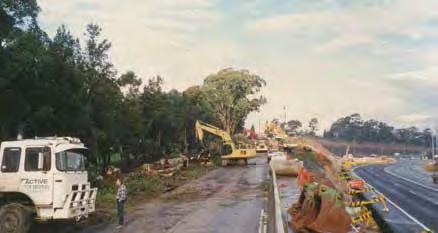
1958. 3rd fairway from behind the 2nd green.

2022. 3rd fairway from the same position.
1995. The 5th fairway.

2005. The 5th fairway after realignment.
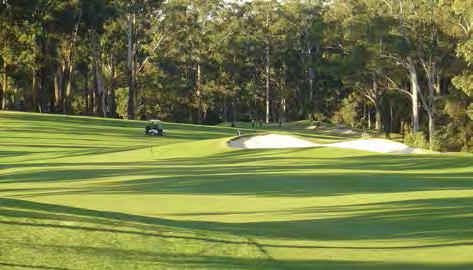
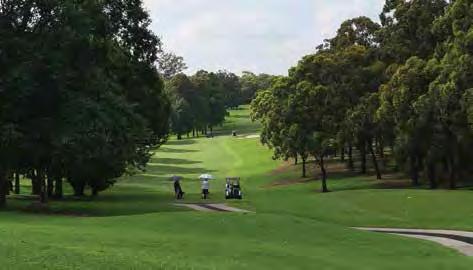
Some advice for ladies playing in the Mixed Foursomes who do not fancy their chances of hitting over the gully from the men’s championship tee: Overheard [at start of play on the first hole] ... “If you go out of bounds, I’ll have an air swing” said Mollie as husband Jim Sutherland teed up on the men’s championship tee.

(NEWSLETTER, DECEMBER 1977)
The Club has purchased three motorised buggies. These are now available to all Club members, however preference in allocation will be given to those, who from disability or age, would otherwise not be able to play. These units are petrol driven and thus may be used twice per day.
(NEWSLETTER, NOVEMBER 1975)
Circa 1990. The 13th fairway showing the young trees planted to create the dogleg.
2022. The 13th fairway showing the same dogleg.
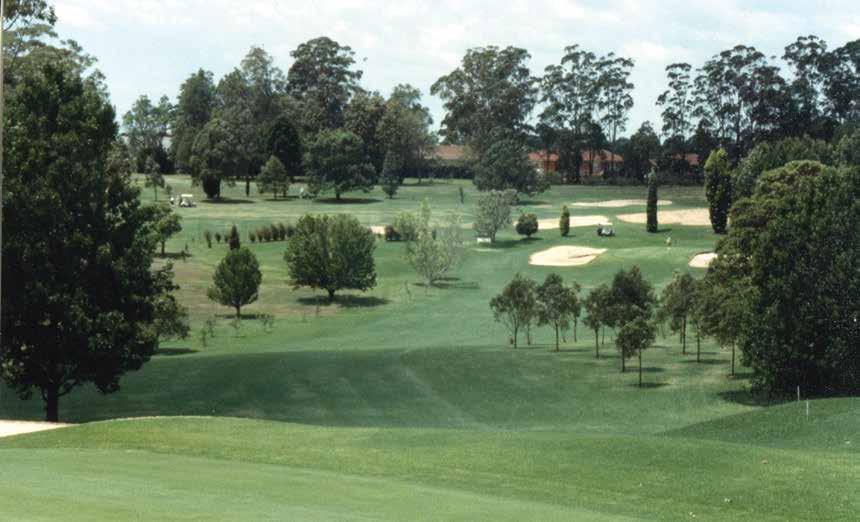
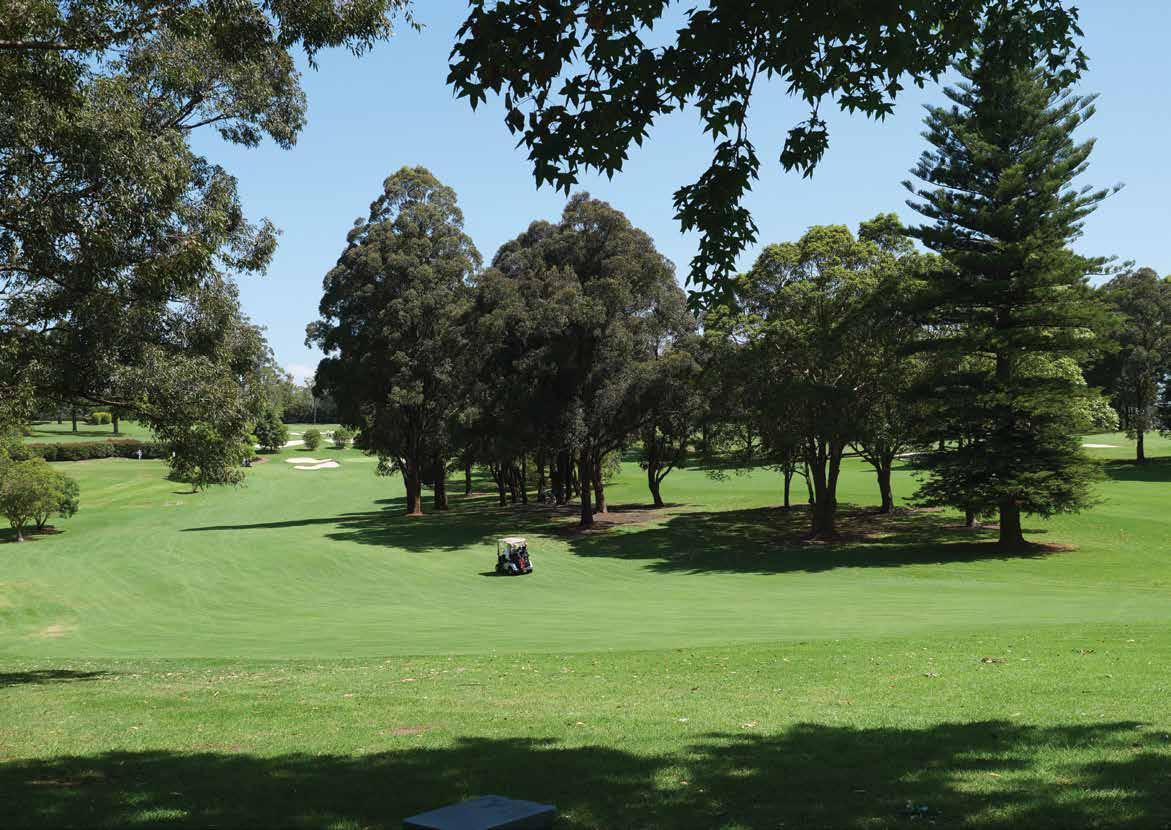
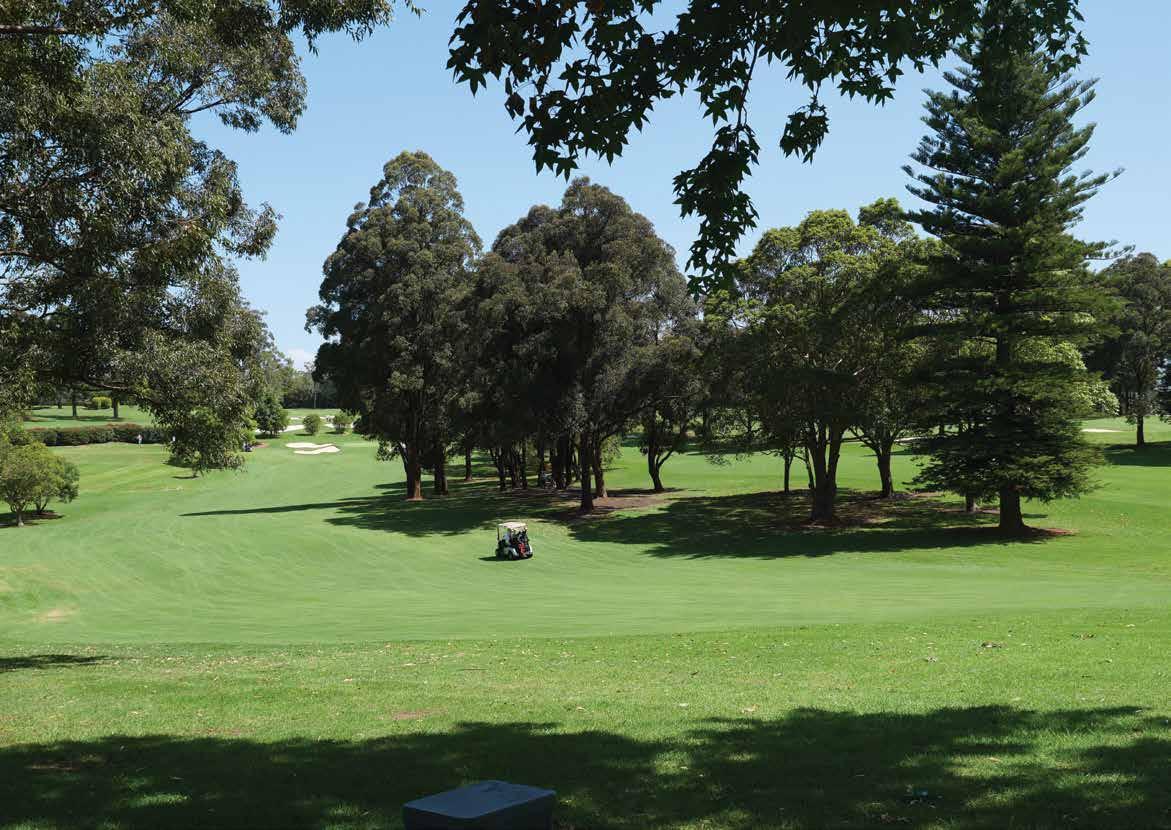
In 1923, the area where the first 9 holes of the 18-hole course were laid out was almost bare of trees as the land had been used for farming. On the remainder of the land purchased by the Club the dominant tree species were Blue gum (Eucalyptus saligna) and Blackbutt (E. pilularis) with native undergrowth. As much of this bushland as possible was retained during clearing for the golf course. Members were, and are, justifiably proud of the course and while a visitor might complain about our very steep hills and gullies and the absence of ‘flat lies’, they are invariably impressed with its natural beauty.

Members have always taken a keen interest in the landscaping of the course. Photographs of the original clubhouse in 1924 show that it was surrounded by a small, carefully planted garden.
In 1929, landscaping around the newly extended clubhouse was well underway.
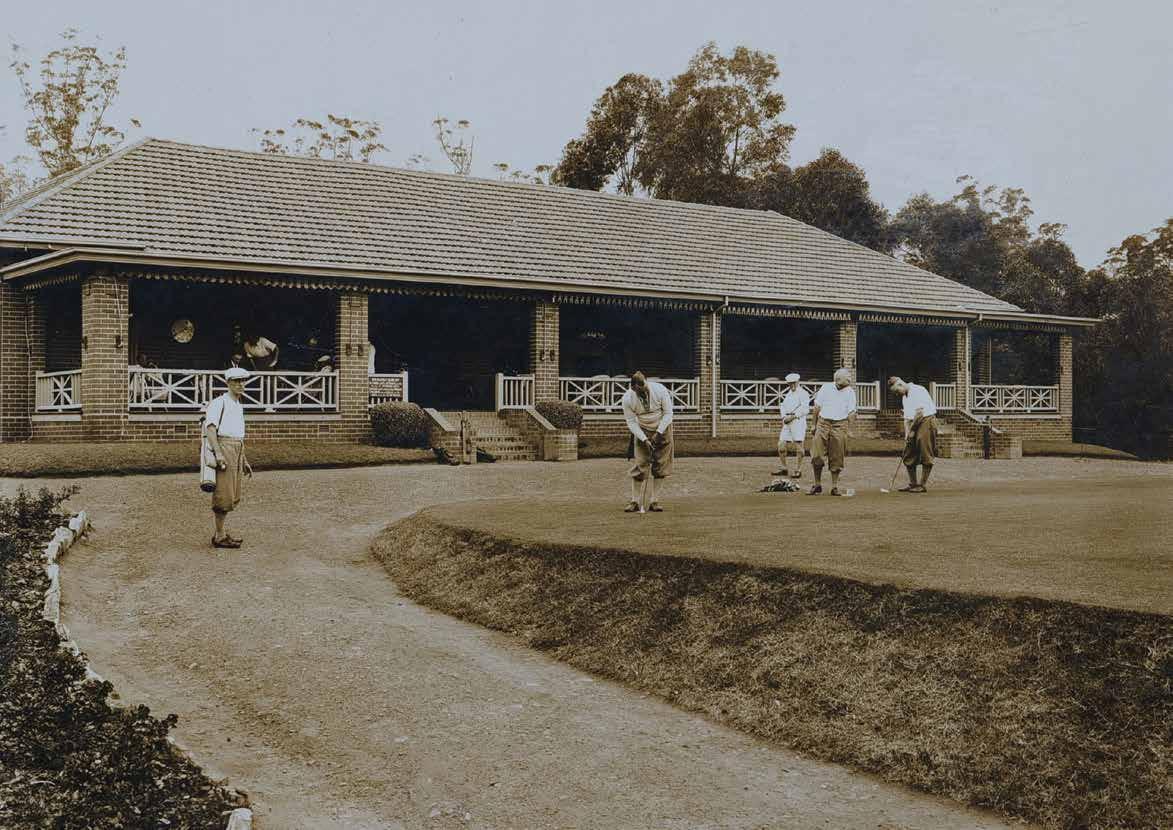
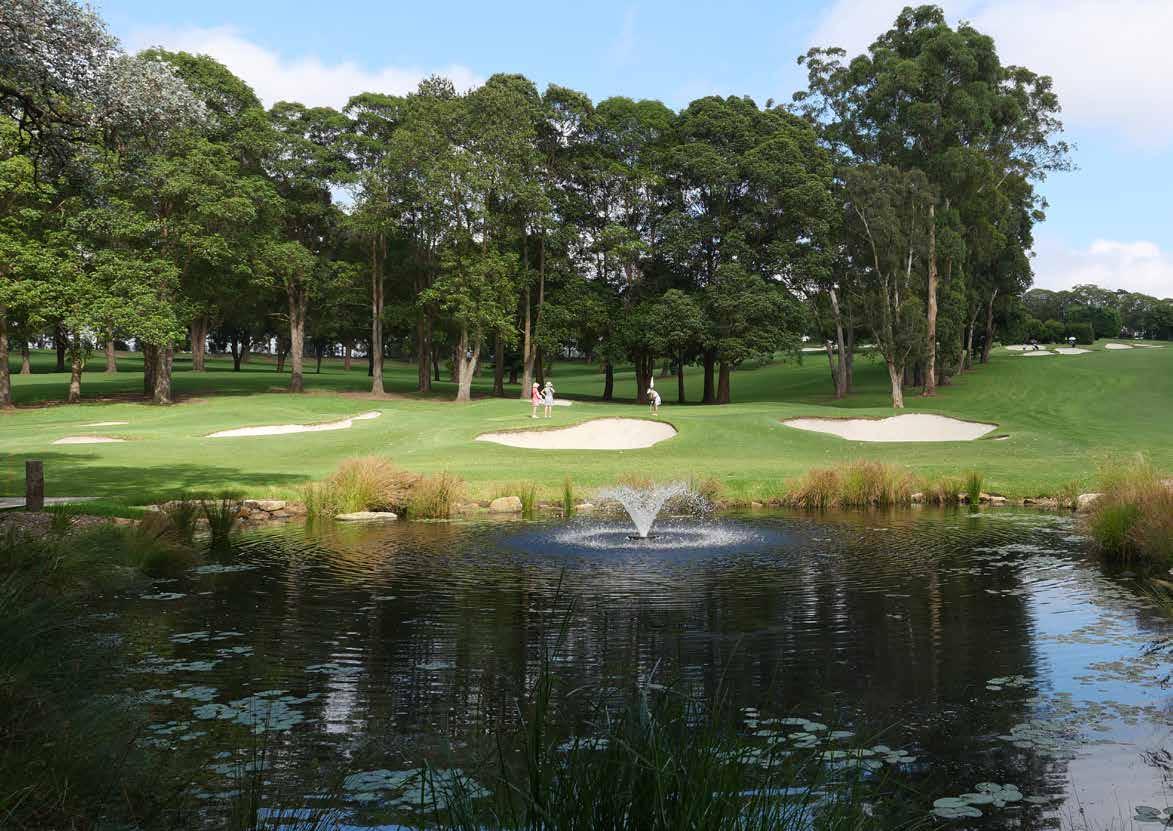
On the bare areas of the course, the first major tree-planting scheme was begun in 1923. Work continued in 1927 with the planting of Lophostemon trees along the Copeland and Pennant Hills Road boundaries to act as a wind break. These trees were also a very effective barrier to balls exiting the course. The first record of a car on Pennant Hills Road being hit by a golf ball was in September 1930, and of a ball breaking a car windscreen on Copeland Road was in April 1931.
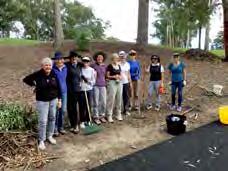
However, in the early years, the focus on the golf course itself was to build and maintain the fairways, tees and greens in the best possible condition. With the arrival of Richard Kirkby more attention was given to the surrounds of the tees
and greens and with the services of dedicated horticulturists, garden beds and plantings have added much variety and beauty to the course.
The long history of members being actively involved in planting trees and establishing and maintaining garden beds continues. The ladies began an “Adopt a Garden Program” in 2015 and ladies’ and men’s groups meet regularly to help out with special projects.
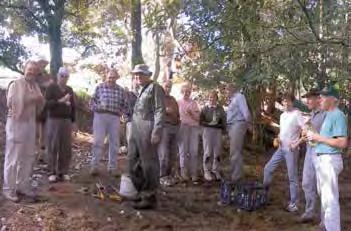
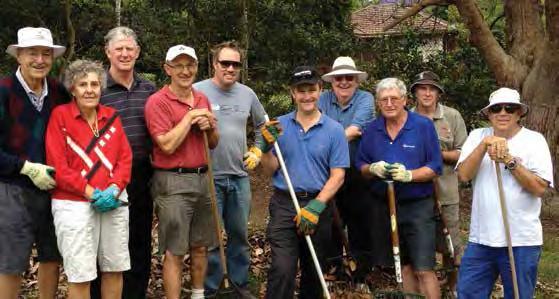
The Board of Directors’ Strategic Plan 2022-2025 outlines their vision for our Club as “A Leading Sydney Private Members’ Golf Club”. A key part of achieving this vision is the implementation of the Course Master Plan. This involves the re-building of our greens, greens surrounds and bunkers, as well as addressing the out-of-bounds issues we have on the holes that border main roads on the course. This re-build will see the greens constructed to USGA standards that will significantly improve their drainage and playability. In addition, the grass will be replaced resulting in a weather-tolerant and more consistent putting surface.
A design brief has been written and issued to two reputable course architects, with concept designs being received during the first half of 2022. Once reviewed and approved by Members, we anticipate the commencement of the project following the completion of the Centenary Year celebrations late in 2023, with completion taking approximately 3 years.
The aim of the Foundation is to look to the medium- and long-term future and provide facilities and activities that will keep our Club at the forefront of the community for years to come. Managed by a Board of Trustees, the Foundation, through donations, will support and fund important projects in line with the aims and objectives of the Club that will generate significant member benefit. These projects are generally large capital expenditure undertakings.
The first major project is a Golf Academy and planning is well underway. Given the Club’s inability to offer an outdoor driving range due to the lack of suitable land on the course, together with the absence of all-weather lesson facilities, the Foundation identified the need for an integrated, state-of-the-art training and development centre. Thanks to members, as well as a NSW Government grant, there are now sufficient resources to complete the design stage through to DA approval. The Academy will provide the following services:
• A virtual driving range, virtual golf course and virtual swing analysis and club fitting. Trackman Australia has been appointed to provide this technology.
• An open foyer and lounge area as well as a meeting room for up to 20 people that can also be a facility for junior golfers to socialise and relax. One aim is to attract more school-aged children to the Club which will drive future membership.
• The potential for the Pro Shop to move into the new facility, which will be larger than the current area, and will allow for a greater range of merchandise to be available.
• Significantly increase the storage area for carts, clubs and buggies. The construction remains under consideration as it is dependent to a large extent on member generosity.
Another major project undertaken by the Foundation was the Second Memorial Gates Project. This has now been expanded to include several gates that give access to the course and management has now been transferred to the Club’s Board of Directors to deliver.
2022. The 6th green looking towards the 7th tee.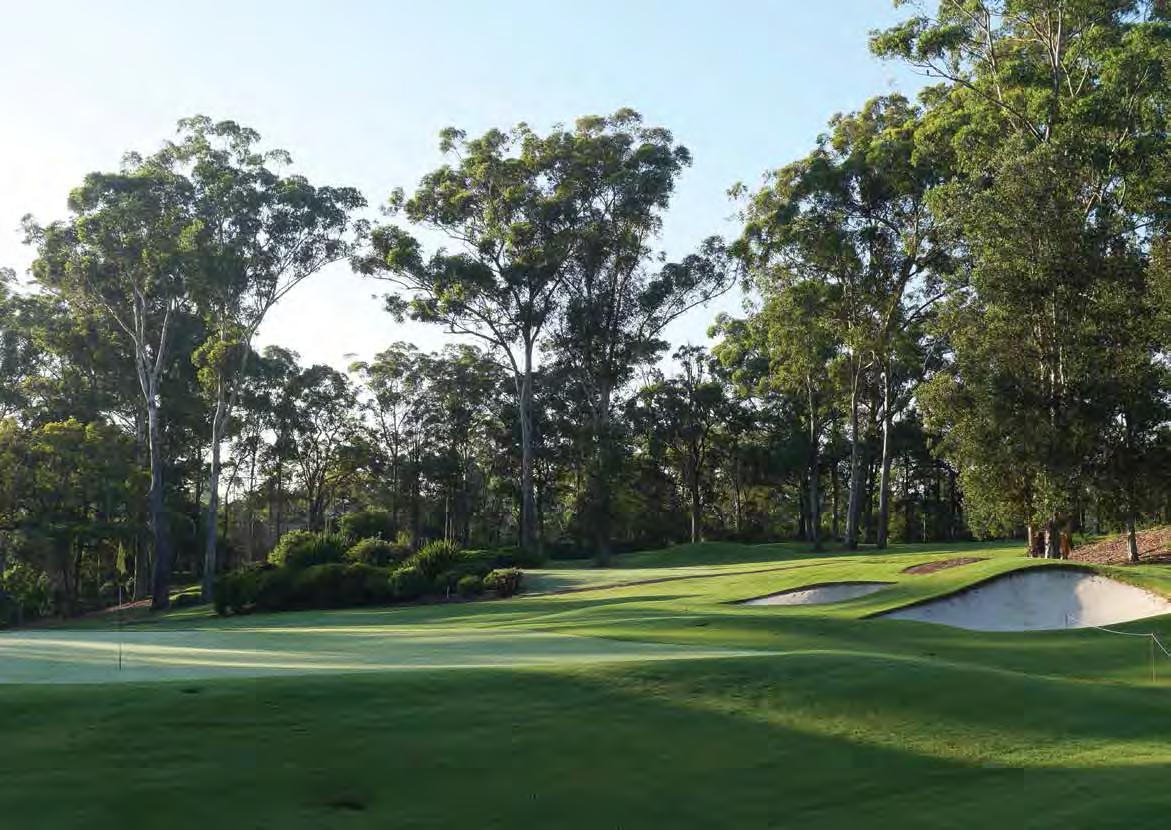
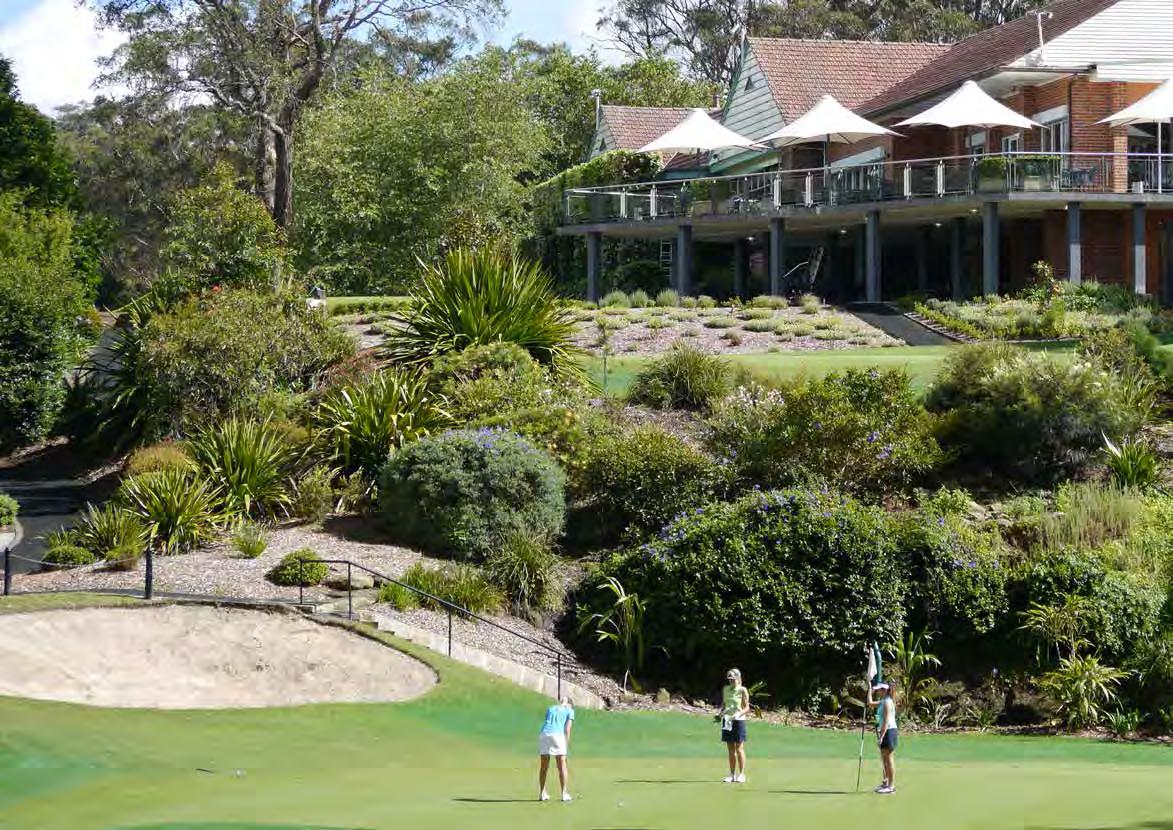
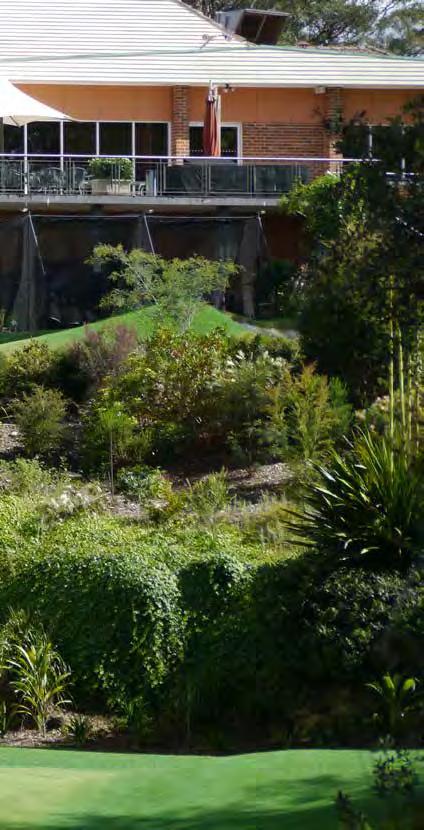
The original clubhouse, built in 1923, was a timber structure measuring just 20 x 12 feet (3.5 x 6m) divided into two rooms, the smaller room being used by the Associates.
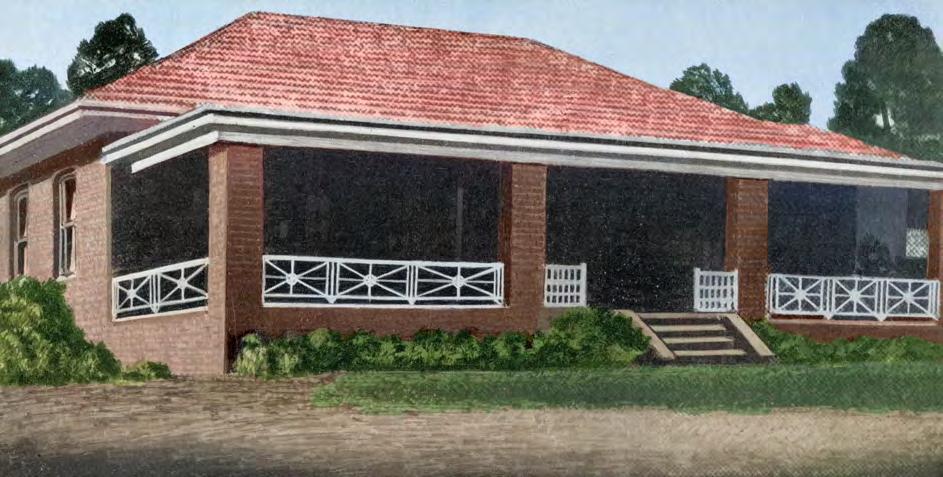
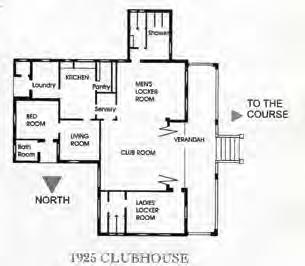
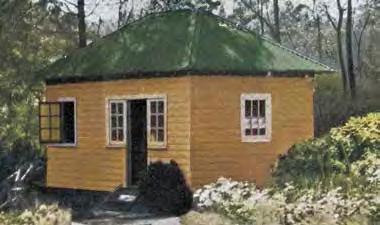
It was originally located near the current women’s 2nd tee. It was moved from there to near the new 1st tee in March 1924 for the opening of the 18hole course.

However, with membership increasing and limited accommodation, there was a real need for a more spacious clubhouse to be built.
The first permanent clubhouse was designed by a member, architect Thomas Pollard Sampson. It was opened in July 1925. During construction of the new building, good use was made of the excavation spoil to form the putting green in front of the clubhouse. The original clubhouse was repurposed as the pro shop until 1953.
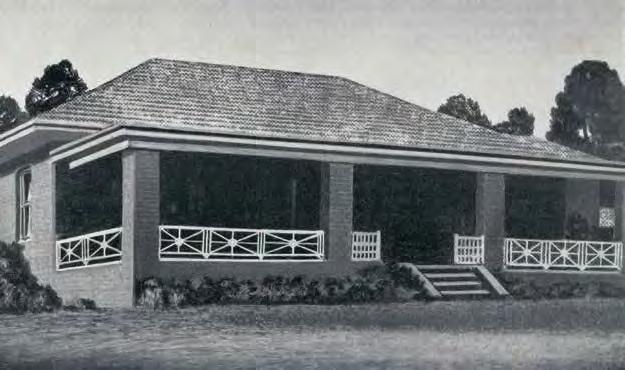
1924. The first clubhouse. Colourised by Bruce Jones.
1925. The new clubhouse with practice putting green in foreground.
By 1928 the membership had nearly doubled so plans were made to increase the size of the building. Sampson was again asked to draw the plans.
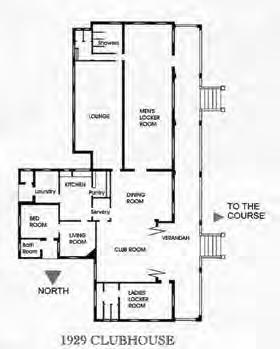
Building progress was slow, as all available funds were being allocated to course development and maintenance. The cost for the clubhouse was largely funded by an extension on the mortgage.

The official opening took place on 23rd October 1929.
 The clubhouse in 1929.
The clubhouse in 1929.
In 1938, Sampson was once again asked to draw up plans for a substantial addition to the clubhouse. The three function rooms, now named the Vicars, Beecroft and Devlins Rooms, were created at this time. The caretaker accommodation was removed to a separate cottage behind the clubhouse allowing the kitchen facilities to be greatly expanded and for the Associates to gain a lounge room.
The expanded clubhouse opened officially on 27th May 1939 with much fanfare and celebration, including a dance held on Saturday, 3rd June, with attendance registering a remarkable 315.
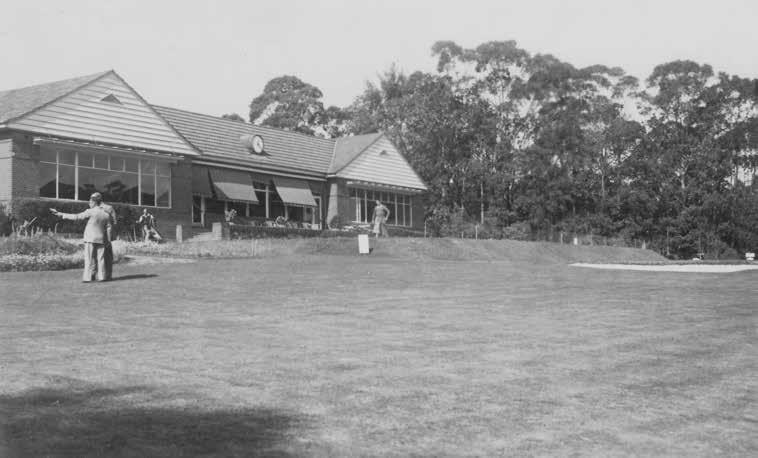
For the previous five years, the Club had held a “black tie” ball at Hordern Bros Florentine Room in the city. But in August 1939 the new facilities allowed it to be held in the clubhouse and 260 people turned out for a great occasion. Eleven days later, news came that Australia was at war.
No major social event was held at the clubhouse for the next 8 years.
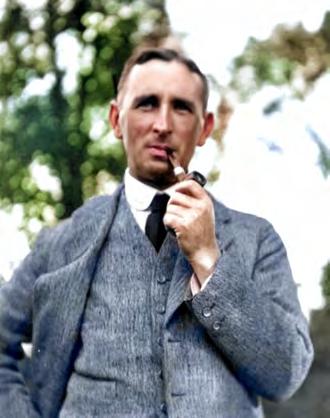 The 1939 extension. Alex Marks has his back to the camera. Photo taken circa 1951.
Thomas Pollard Sampson who designed the original clubhouse.
The large clock, installed over the balcony at this time, was donated by AG (Gilbert) Tomlinson.
The 1939 extension. Alex Marks has his back to the camera. Photo taken circa 1951.
Thomas Pollard Sampson who designed the original clubhouse.
The large clock, installed over the balcony at this time, was donated by AG (Gilbert) Tomlinson.
A little-known fact is that in 1942, from April to December, Australia’s military authorities took over more than half the clubhouse. It was at first prepared as a casualty clearing station and later the space was converted into a convalescent home for soldiers. While the invasion scare lasted, about 250 men and their equipment were encamped among the trees on the course.
An aerial view of the clubhouse taken in 1945. Note the original clubhouse situated next to the 1st tee (bottom left) in use as the pro shop.
Also, at the top of the photo, the caretaker’s cottage can be seen, with the chimney used for the army mess nearby.

Celebrating 100 years
1945. Aerial view of the clubhouse.
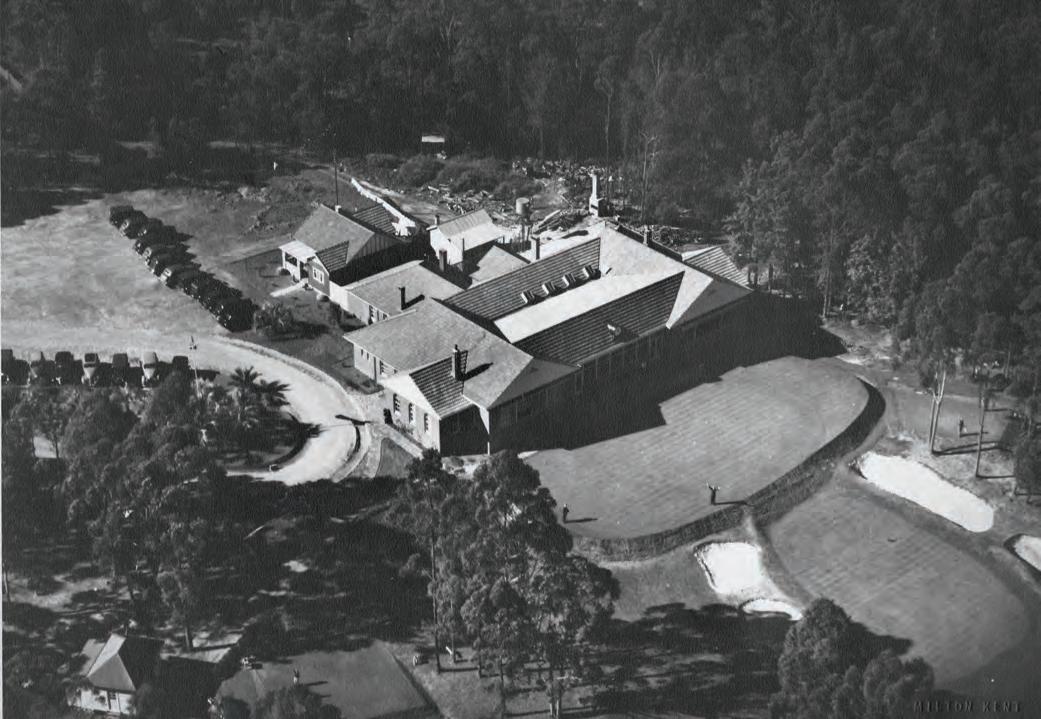
In the early years the Club had no liquor licence although several attempts were made to get one. After a round of golf, the drinks consumed were usually tea or soft drinks. The liquor laws were terribly restrictive as reported by EJ Hyde:
“Of course at this time the Club had no liquor licence and this imposed hardships on the members. Each was supposed to bring his own bottle and it is doubtful if camaraderie in the Club ever reached a higher peak than during this period. Difficulty was also created for the Committee when our Club teams played matches against other clubs that had licences, and Pennant Hills players could not reciprocate in the same manner. Eventually the Club decided to provide two bottles of whisky and half a dozen lager for team matches played at the Club”.
Members were allowed to have personal supplies of liquor, properly labelled, held by the Club on their behalf. There is some indication that the boundaries of this arrangement were somewhat stretched.
In the late 1930s the House Committee minutes announced “profits” from the sale of liquor. Committee minutes from April 1940 reported “an impending increase of 15/- per gallon on whiskey and Mr. Trotter moved that we purchase a quarter cask (30/34 gallons) at present prices”.
Following changes to the NSW Government’s Liquor Act of 1946, the Club was granted a liquor licence in 1947.
In 1930, the Club purchased an ‘automatic fruit machine’, with profits from the machine allocated to a special fund for “improvements”. In 1940, the Club purchased a poker machine and by 1946 owned five machines.
For the year ending July 2000, profits from the poker machines amounted to $12k. With the machines becoming obsolete in January 2001, they were put into storage but the Club retained three gaming licences. With Club finances running below budget in 2009, these licences were sold.
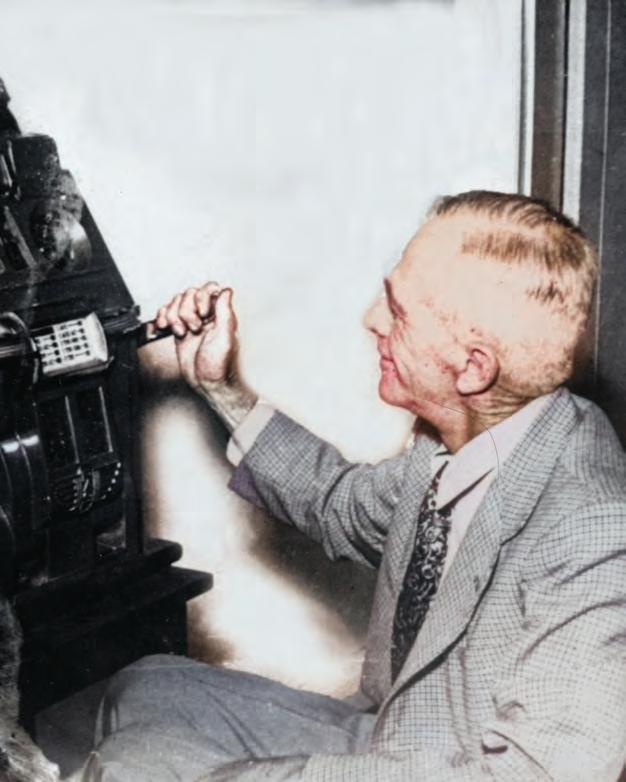 Circa 1955. Hector (Reg) Austin playing a machine.
Circa 1955. The clubhouse viewed from the 10th fairway.
Circa 1956. Shirley Baker (pictured) joined the Club in 1953.
The clubhouse in 1956.
Circa 1955. Hector (Reg) Austin playing a machine.
Circa 1955. The clubhouse viewed from the 10th fairway.
Circa 1956. Shirley Baker (pictured) joined the Club in 1953.
The clubhouse in 1956.

The first work carried out after the war was to improve the Associates’ facilities and by 1953 the ladies enjoyed a new lounge and locker room.

There were regular discussions about expansion, and eventually in 1962, finances allowed for substantial extensions. The changes included a new bar, offices, squash court, billiards room and a small terrace on the southwestern end of the building with a spike bar below.
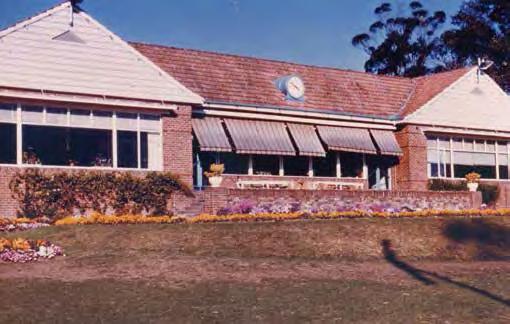
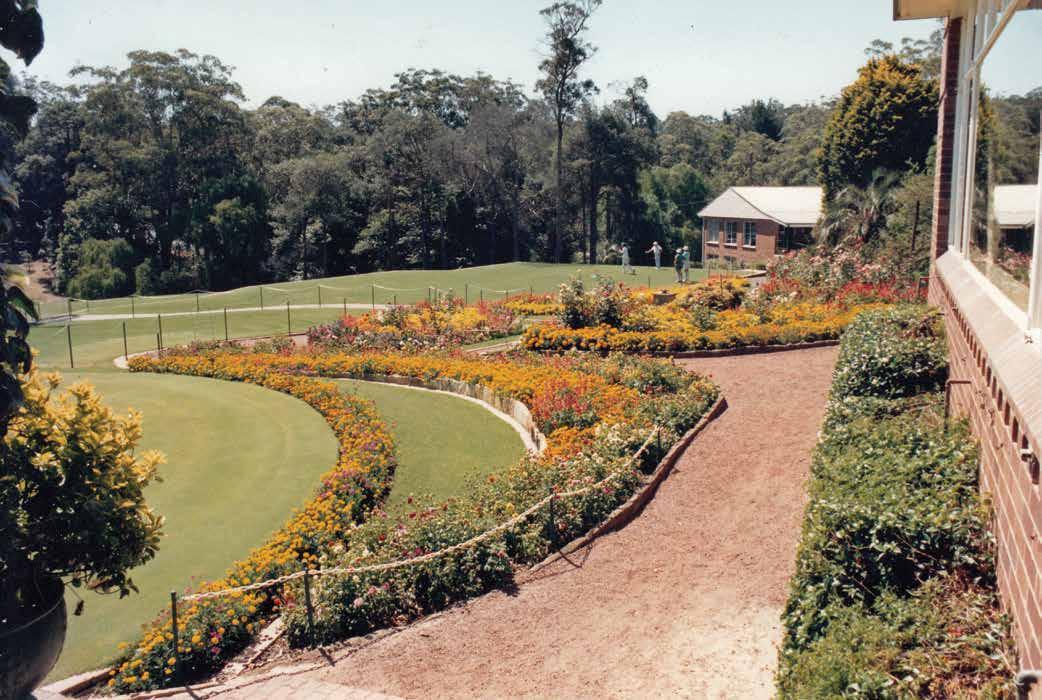
The clubhouse in 1987.
The clubhouse in 1988.

Circa 1988. The ivy pergola on the terrace was added in 1967. The ivy was a very popular feature of the facade. By 2015, the pergola was in a very poor state of repair and it was dismantled during renovations in 2019.
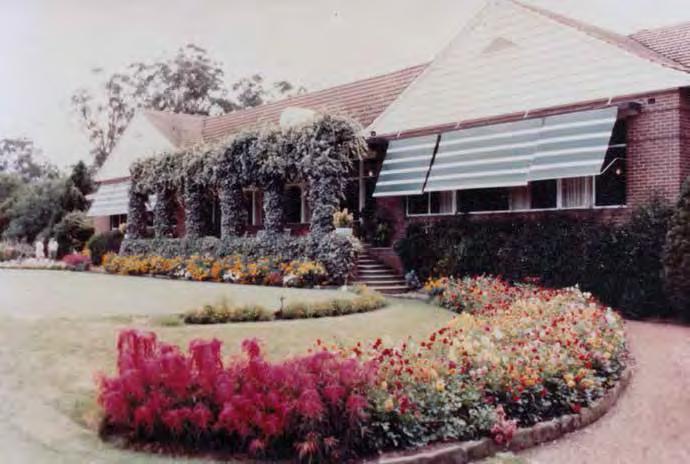
In 1990 a major refurbishment of the function and lounge areas was undertaken and included the installation of attractive new ceilings with recessed lighting throughout.
Then in 2001 the clubhouse saw another major upgrade and extension. Changes included the addition of a hallway to separate the changerooms from the function rooms. The changerooms were upgraded, and the bar and casual dining area, offices, reception and boardroom were enlarged. The terrace on the southwestern corner was extended.

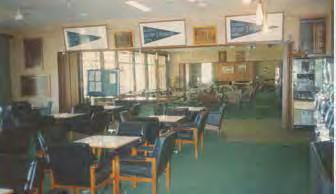
While there are several mentions in the late 1990s of the lack of air conditioning making it difficult to maintain dress standards, the clubhouse lounge rooms had to wait until this major refurbishment when the ceilings were remodelled. Members first enjoyed the luxury of air conditioning at a dinner on Friday 24th February 2001.
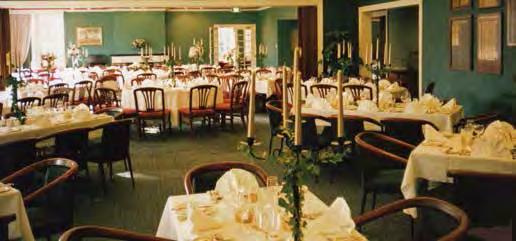 The function rooms in 1987.
The function rooms in 1987.
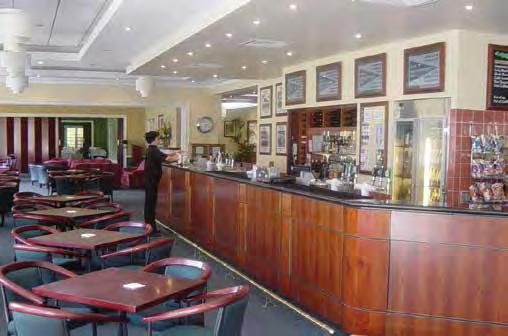
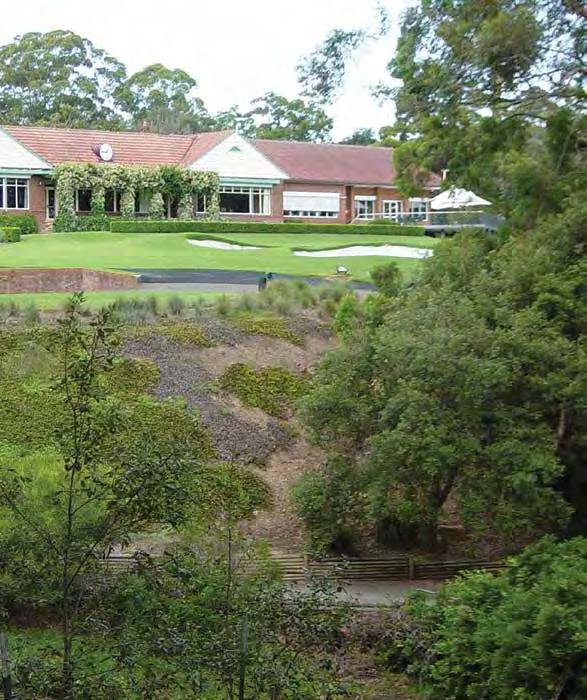
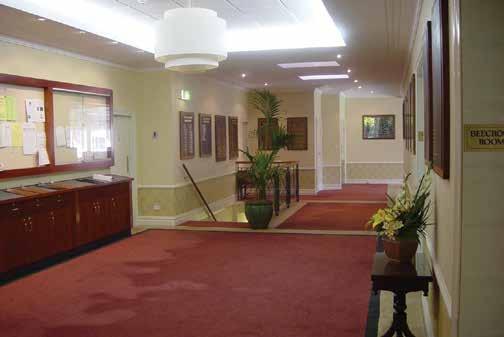
The next major move to upgrade and extend the clubhouse began in mid2007 when a planning committee was established. However, the Global Financial Crisis (2007-2009) quickly put the brakes on plans. Members were reluctant to add to the debt of the Water Reclamation Plant in a time of much financial insecurity.
The focus was on course improvements while the much-loved clubhouse was considered to still meet member needs.
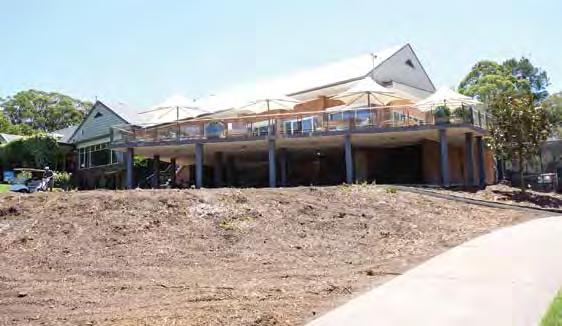
The idea of extensions to the clubhouse was revisited in 2015. This time, a much more conservative plan would leave most of the original building, designed by TP Sampson, intact.
The Clubhouse Committee took on the enormous task of managing the extensions. The generosity and expertise of a number of members was invaluable in driving the project forward.
Work began in January 2018. For the next 18 months, outstanding efforts by the Board, Clubhouse Committee and our catering staff ensured that there were minimal interruptions to members’ preand post-golf refreshments and other services.
Perhaps the most notable achievement of the many dedicated members who have contributed to the several extensions and renovations of the clubhouse over the years, is that the clubhouse has maintained the attractive and cohesive feel of TP Sampson’s first design in 1925.
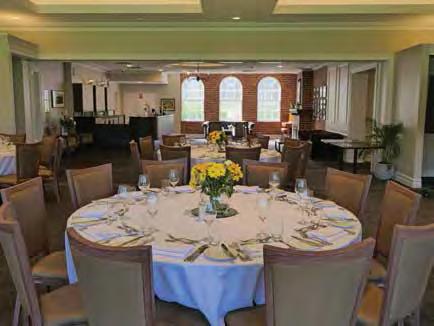
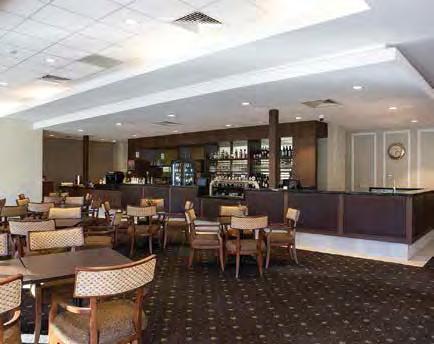

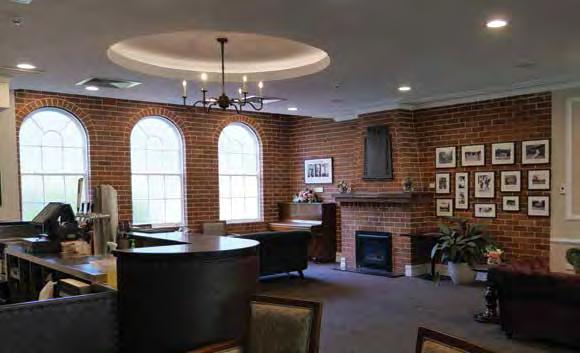



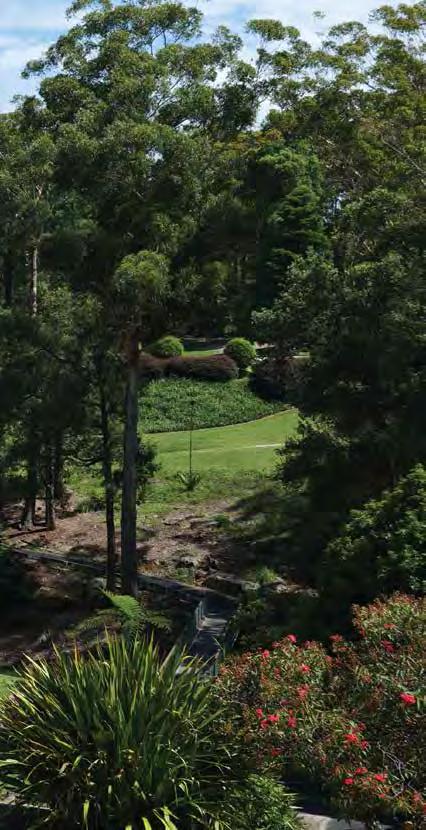
With a 9-hole golf course laid out in a matter of weeks, the first game of golf was played about April 1923.
APlaying Committee had been established to determine bogey (par) for each hole, arrange the golfing programme, apply handicaps, determine local rules and to establish competition fees.
Two official handicappers were appointed and handicaps were adjusted regularly. There is no record of the method used. It appears that the adjustment was in part a matter of judgement by the handicappers. When past President Jack Thomson joined
the Club in 1949 he was given a handicap, sight unseen, of 24. Beginning his first round, he hit off the 1st tee sending his ball into the distance, straight as an arrow. The handicapper, who observed the shot, said “better make that 20”. Surely the quickest handicap reduction in the Club’s history.
The first recorded competition was stroke, under handicap conditions, played on the 15th of September 1923. Men and women played the same course and there were 24 entrants. The event was won by Mrs Mabel Morgan who received the prize of an open order for 10 shillings. Mabel Morgan was an outstanding golfer who won five Club Championships. She also won a number of Ladies Golf Union events and was widely acknowledged as a formidable opponent in matchplay.
The season opening event on 22 March
1924, a mixed fourball, was played on the newly available 18-hole course. The event was won by Mabel Morgan and James Heane.The first Club Championships were played in 1924 and were won by Mabel Morgan and Herbert Reed. Reed won another two Club Championships in 1936 and 1937.
Apart from matchplay, all competitions were either stroke, bogey (now called par) or mixed foursomes. The first stableford competition at Pennant Hills was played in December 1935 and proved very popular with the members.
Early members of Pennant Hills Golf Club would have used the Haskell golf ball. Patented in 1899, the ball had a solid core wrapped tightly with rubber thread and covered with gutta-percha, and later, belata. Initially having an outside pattern of brambles this soon changed to dimples
THE FIRST RECORDED COMPETITION WAS STROKE, UNDER HANDICAP CONDITIONS, PLAYED ON 15 SEPTEMBER 1923
which provided better length and spin. The ball was used until the 1960s when solid-core balls were developed.
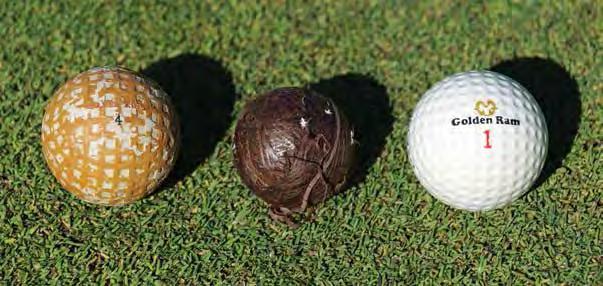
Did you know?
Dr Frank Stableford said: “I was practicing on the second fairway at Wallasey Golf Club [Cheshire, UK] one day in the latter part of 1931 when the thought ran through my mind that many players in competitions got very little fun since they tore up their cards after playing only a few holes and I wondered if anything could be done about it”. The first Stableford competition was held at Wallasey on May 16, 1932 and it was a hit with golfers.
GOLF DIGEST 20 APRIL 2020.
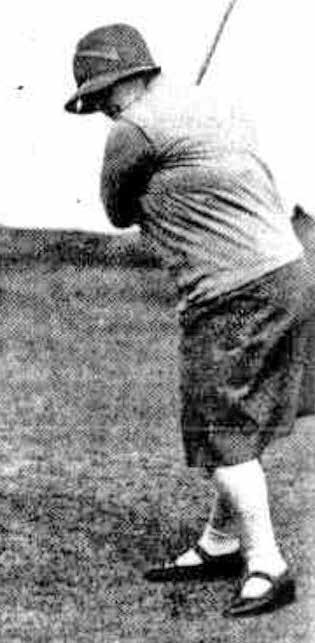
While there have been many outstanding performances and records associated with the Club, a few are worthy of special mention.
Men: Two men hold the course record of 63:
Kel Nagle during the 2nd round of the PGA Championships on 22 November 1952. He went on to win the Championship.
Tony Gresham equalled the record during a Silver Button (medal) round on 13 July 1968.
Women: Julia Boland achieved a course record of 66 on 23 September 2004 during the 2nd qualifying round of the Club Championships. She went on to win the Championship.




Men: Andrew Scott (HC 25) scored 54 points in December 1998.
Women: Susie Wales (HC 31) scored 52 points in December 1999.
Juniors: Wenxin Wang (HC 33) holds the record with 54 points. She achieved this on 15 February 2021.
Club Championships –most wins
Men: Tony Gresham won 25 Championships between 1962 and 1990.
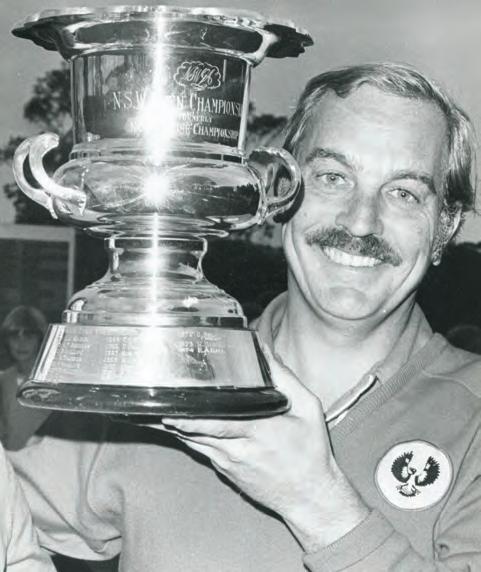
Women: Lavene Taylor won 11 Championships between 1955 and 1968.
35
Tony Gresham, winner of the 1975 NSW Open. Regarded as the greatest amateur golfer of his generation, his record in Australia is unsurpassed.
Tony Gresham: 35 for 18 holes. All were eagles except for the 6th (a mere birdie) and an albatross on the 12th.
Unfortunately, similar records have not been kept for the women.
Celebrating 100 years
“In his last four rounds at PH Tony Gresham shot scores of 66, 67, 69 and 68. Truly remarkable! We bestowed upon him the honour of playing on + 1 - and believe he is the only one in the State on a plus handicap.”
“Playing off scratch, Greg Wicks recorded 12 birdies to win this year’s eclectic event. In view of the fact that Greg played only 3 rounds the score is most meritorious.”
Since the early days of the Club, many members have served the wider golf community on Councils and Boards of State and National golfing associations. Their contributions have been recognised in several cases by their being awarded Life Membership of those bodies. The list is extensive and we are proud of our club members who have taken on these important roles. Their stories are well documented in Ron Harper’s history book from 2000. (See Introduction).
More recently, from 2010 to 2015, Chris Allen and Sue Fabian served as the inaugural Chair and Deputy Chair, respectively, of GolfNSW, the governing body of golf in NSW. Both have been elected Life Members of GolfNSW. Chris is also a member of Golf Australia Handicapping, Amateur Status and Rules Policy Committee, a State Selector and was a Member of the Jack Newton Junior Golf Foundation from 2005 to 2015.
Both Chris and Sue have also enjoyed National Referee Accreditation and, encouraged by them, Pennant Hills has for many years had the most NSW based State Rules Accredited individuals of any club.
First hole-in-one
W Mabel Morgan
1923-2023
M TP (Phillip) Nossiter
On the 2nd hole (140m) in March 1924 on the 9-hole layout
On the 18th hole (73m) in July 1924
Most holes-in-one
W Beverley Archer
Susie Wales
M Tony Gresham
4 holes-in-one (4, 9 and 14th holes)
4 holes-in-one (6, 9, 14 and 18th holes)
Bill
played
for the Club for 28 consecutive years – an outstanding achievement.
Being invited to represent the Club in pennants competitions is a special honour. In 1926 the Club entered a men’s team in C Grade and added a B Grade team the next year. They won their first pennant in B Grade in 1936 followed by a number of wins in other grades in subsequent years. Then in 1971 they won the top prize in the Metropolitan Major Pennant becoming Division 1 Champions. The men dominated this competition, again winning the top division in 1978, 1980 and 1987. As well, the men play in the Metropolitan Masters Pennant, an interclub event for men over 50, now also open to women, and the Eric Apperly Shield, a competition run by Golf NSW for men under 22, and since 2020, also open to women.
The women began playing pennants in 1927. They won their first pennant in C Grade in 1933. After a number of pennant wins in other grades in subsequent years, the women won the top division, the NSW Women’s Grade Division 1 Championship, in 2012 and 2013, and then again in 2015 when the top division became the Metropolitan Pennant.
The 1971 team. The first to win the major pennant: (Back) Laurie Sparks, Ross Buddle, Bob Wickens (Club Cpt), John Jones (Pres), Alex Marks (Sec Mgr), Neil Handley, Keith Hayes, John Ferris. (Front) Mal Bray, Bill Wright, Tony Gresham (Team Captain), Dennis Goodman, Ian Mackie. Absent: J W Burke and Greg Wicks.

The 2012 team. The first to win the major pennant: (Back) Kim Bourke, Deb Bennett (Team Captain). (Front) Tess MacDonald, Lauren Hibbert, Aliza Huff, Paige Stubbs, Michelle McGrath. Inset L: Isabella Chan, R: Ashley Cramond.
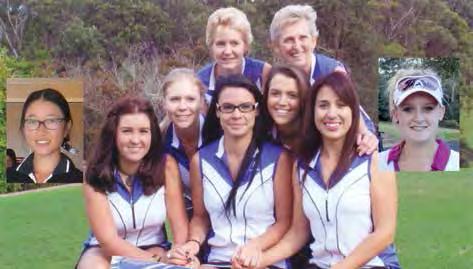
The women play in another five interclub pennant competitions as well as a Sunday Women’s Interclub.
The Club also has a team in the Metropolitan Mixed Pennant.
While photos of our early members are few, and often of poor quality, here is one exception. This famous photo was taken on Championship Day, June 1931. Gathering in the clubhouse following the day’s competition has long been a great tradition for the Pennant Hills men. Although members enjoy their golfing experience, a highlight for many has been the Wednesday and Saturday presentations – usually conducted by the Captain and President, respectively. Presentations have become a feature not practised by other clubs, but are warmly embraced by our members and their guests. After the Club news is updated, competition winners and runners-up are acknowledged and winners are expected to give a short speech. Over the years, presentations have tended to be humorous. Great moments are of course noted, but no matter how badly one has played, any misfortunes during a round are rarely overlooked, and are often very entertaining.

Members compete for upwards of 24 trophies each year, many of which have been generously donated by fellow members.
Keenly contested major events include the Club Championship contested since 1924; Seniors Championship for members aged 55 and over contested since 1973; Junior
June 1931. Only some of the members can be identified but in the front row L-R: R Vicars Jr, EJ Hyde, E Doran, J Heane and F Scales. The first Club Professional, George Howard, is on the far right and behind him is Dr HM (Greg) Cutler who was Champion that day. Colourised by Bruce Jones.
Championship contested since 1967; Foursomes Championship contested since 1933; the Pennant Hills Cup, open to all-comers and contested since 1933; and the AE Marks Cup, formerly the Hislop Cup, contested since 1927.
Given the dominance of Tony Gresham’s record as the Club Champion (25 times between 1962 and 1990) the conversation in that era typically revolved around who he would play in the final, coupled with a plethora of fellow competitors’ hard luck
stories from their encounters. To this end, Greg Wicks met Tony on many occasions (unsuccessfully by his own admission) with a memorable situation occurring on hole 15 that Greg drove in the morning and afternoon rounds of a final contest –but walked away with a half in one round when Tony managed a one putt birdie, and a loss in the other when Tony holed out with his approach shot for an eagle 2.
Tony and Greg subsequently won the Club Foursomes Championship. Greg’s acceptance speech highlighted the fact that people could be excused for assuming Tony played well, but the reality was that all he had to do all day was to chip out sideways – which was usually met with applause and cries of “shot Gresh”.
In terms of member participation and popularity, the AE Marks Cup ranks very highly. The event is a handicap Fourball matchplay knockout, attracting large fields and contested over a number of months each year.
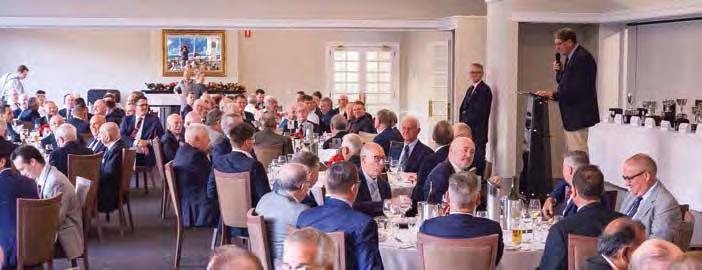
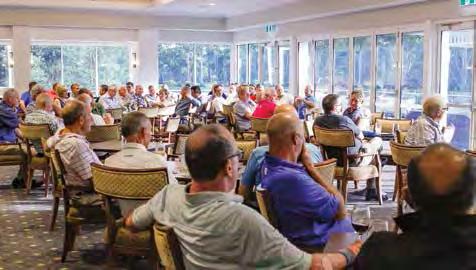
Amongst other longstanding events is Silver Buttons, played since 1946, which is a medal round contested usually 8 times each year, with winners of each grade playing off for a Gold Button in November.
Prior to 2004 stroke events were only contested on weekends, but it was decided (principally to provide an opportunity for members who did not play on weekends) to introduce two Wednesday stroke rounds per year. The number was increased to four rounds in 2013, with a Wednesday Medal final played in November. The inaugural Wednesday Gold Button was contested in 2016 when the event format was modified to allow 12 winners to play for a Gold Button.
2019. Members gathering for the presentation after the competition. 2020. Men’s annual dinner.Another recent innovation was the introduction of the Super Pin, whereby players in Wednesday and Saturday competitions have the option to participate for a set amount (typically $3), with the nearest to the pin on hole 14 winning the total pool. Participation for this novelty event is not compulsory, which became abundantly clear when the late Commodore Geoff Lumsden had a hole-in-one, but was not entered in the competition. Determined never to be denied again he entered the competition the next time he played and, unbelievably not only did he have the nearest to the pin, but another hole-in-one. A search of the Guinness Book of Records failed to find anything remotely comparable.
As well as Pennant and Grade matches, the Club has been an active participant in interclub events. In November 1924 players from Parramatta Club were invited to play at the Club and a very pleasant day was reported. The following May, 26 members were invited to play at the Parramatta Club in a fourball match and were roundly defeated by the home team 11-2.
Interclubs in recent times include the Pack Cup, contested between Pennant Hills, Avondale, Concord, Killara and Pymble clubs since 1999; and the Masters Pennants which commenced with two teams in 1980 and now numbers over 100 participant clubs. In season 2021 this competition, for the first time, allowed women participants.
The Club has proudly hosted the NSW Amateur Championship on three occasions – 1964, 1972, when it was won by Tony Gresham, and 1998. The Club will host this Championship once again in 2023.
2021 Club member Andrew Richards won the NSW Amateur Championship and the prestigious Riversdale Cup (contested since 1896) being the first player, ever, to win both events in the same calendar year.
 2001. Pack Cup Team. L-R: E Truscott, G Lane, A Goodwin, T Gilchrist, D Cluff, J Whiteford, M Bray, G Lumsden, H Goodwin.
2001. Pack Cup Team. L-R: E Truscott, G Lane, A Goodwin, T Gilchrist, D Cluff, J Whiteford, M Bray, G Lumsden, H Goodwin.
The women have always managed their own competitions and the organisation of the busy and engaging golfing calendar is the responsibility of the Women’s Committee.
In the beginning, all golf competitions were held on Saturdays, then in 1925 Thursday was adopted as Ladies Day. As the membership grew, restrictions on Saturday play were soon imposed and from July 1927 ladies were not permitted to play on Saturday afternoons or public holidays.
Since 1964, the Thursday competition has been organised as a drawn ballot. This very popular arrangement ensures that the women will have many different playing partners over the season and doubtless adds greatly to the wonderful camaraderie enjoyed by our women members.
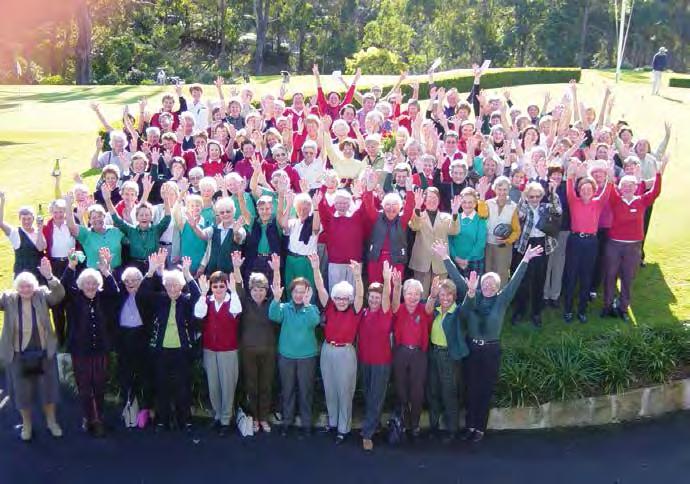 1935. Associates putting out on a rough green.
2004. Presidents vs Captains Day.
1935. Associates putting out on a rough green.
2004. Presidents vs Captains Day.
The first Women’s Club Championship was contested in 1924 and was won by Mabel Morgan. She was a formidable golfer and went on to win the next four Championships. Lavene Taylor was another remarkable golfer, winning the Club Championships eleven times.

The Women’s Championships are conducted through two stroke qualifying rounds, followed by quarter- and semifinal matchplay rounds. The Championship concludes on “Finals Day” with matchplay over 36 holes. The finals of the Bronze and Bronze II Championships and the Silver and Bronze Matchplay Championships are also contested on this day. A large crowd follows these events and, since 1937, this very special day finishes with trophy presentations and afternoon tea in the clubhouse.
An enduring highlight of the calendar at PHGC is Presidents vs Captains Day, when the green Presidents team is pitted against the red Captains team in competition for golfing glory. Golf is followed by a special lunch celebration to acknowledge past Presidents and Captains, enduring Club memberships, 80th and 90th birthdays and golfing victories in the past and on the day. Club spirit is at an all-time high at this enjoyable annual event.
In any one year there are many coveted trophies to contest. The golfing year includes the President’s and Captain’s Cups, Foursomes Championships, the Fourball and Singles Knockouts, Pennant Hills Cup and Bronze Salver and Veterans’ trophies. The women also participate in externally organised golf events such as the Lexus of Parramatta Cup and Golf NSW Medal Competitions and events, with the highest scores in these competitions going on to represent the Club at the next level against other participating clubs.Team events are always well supported by the women and include Silver Summer Matchplay for handicaps up to 25, Cheltenham Teams for handicaps 26+ and the eagerly contested Devlins Creek Challenge which has a format of fourball, foursomes and stableford, played over 3 days.
As well, interclub matches are played annually against Oatlands Golf Club, since 1955, Avondale, since 1957 and Castle Hill, since 1967. These events are very popular and the women catch up on friendships forged over many years.
In 1939, the Associates Committee ruled that stockings must be worn during competition golf. In May 1971, the committee ruled that short pants or slacks were not permitted on the course, or in the clubhouse, but slacks could be worn on the course in inclement weather, if permission was given.
One member (name supplied) suggested that “on days when mixed events are held that the men’s lounge be open to Associates. The suggestion was opposed.”
FROM THE MINUTES OF THE AGM, 30 SEPTEMBER 1946.
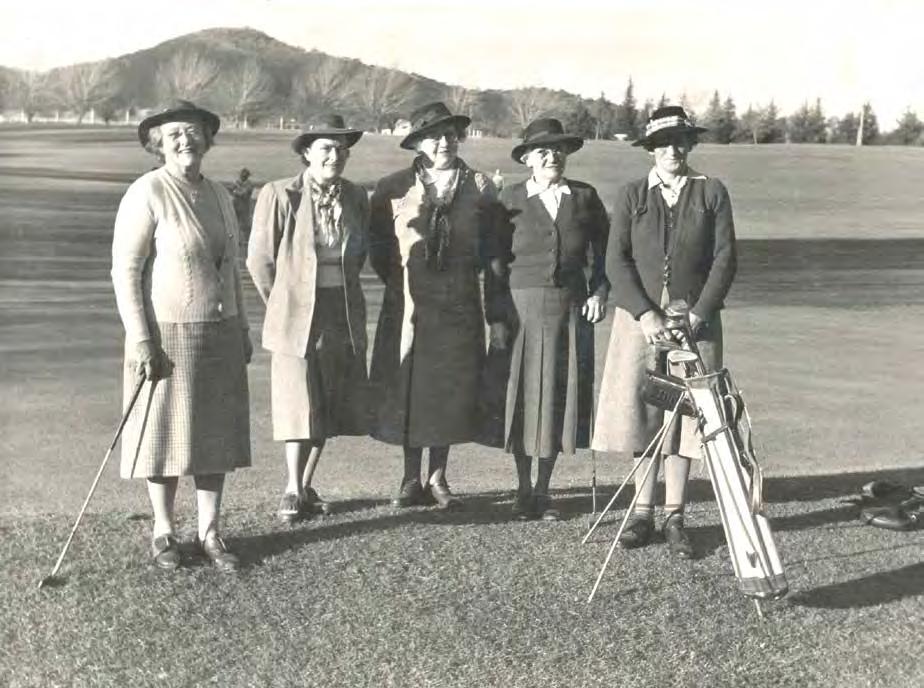
In addition to the serious golf challenges, the Women’s Committee organises many fun events including an annual Mystery Day Trip to a secret destination and a multi-day trip away during Greens Renovations.
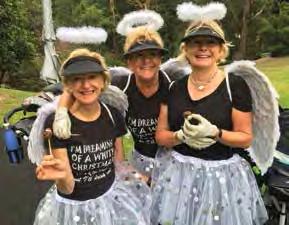
The women have a lot of fun combining a party with their golf and during the year they enjoy various events which are characterised by coloured apparel, trivia contests, and a chance to compete for themed merchandise. A Monday in early December is set aside for the fun and games of the Christmas 3 Ball Shamble, a more than 25-year tradition that witnesses the transformation of women golfers into a creative array of yuletide characters,

from the Three Wise Men to Plum Puddings and many more. Golf challenges such as putting with oven mitts and driving with a cricket bat are an integral component of this festive tradition.
The High Tee Classic, held in February, is a very popular open invitation event. It is the ultimate fusion of golf, delicious food and bubbles, the day concluding with a golf fashion parade. Then there is Green Day which celebrates St Patrick’s Day and Beany Day which marks the winter solstice.
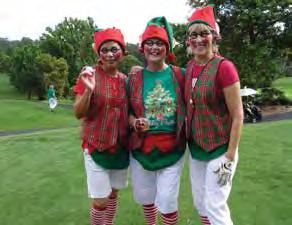 Ladies dressed up for the occasion.
1950. Associates at the Southern Highlands, Jessie LeClerk, Myrle Travis, Gwen Barmby, Annie Banner, Majorie Beck.
Ladies dressed up for the occasion.
1950. Associates at the Southern Highlands, Jessie LeClerk, Myrle Travis, Gwen Barmby, Annie Banner, Majorie Beck.
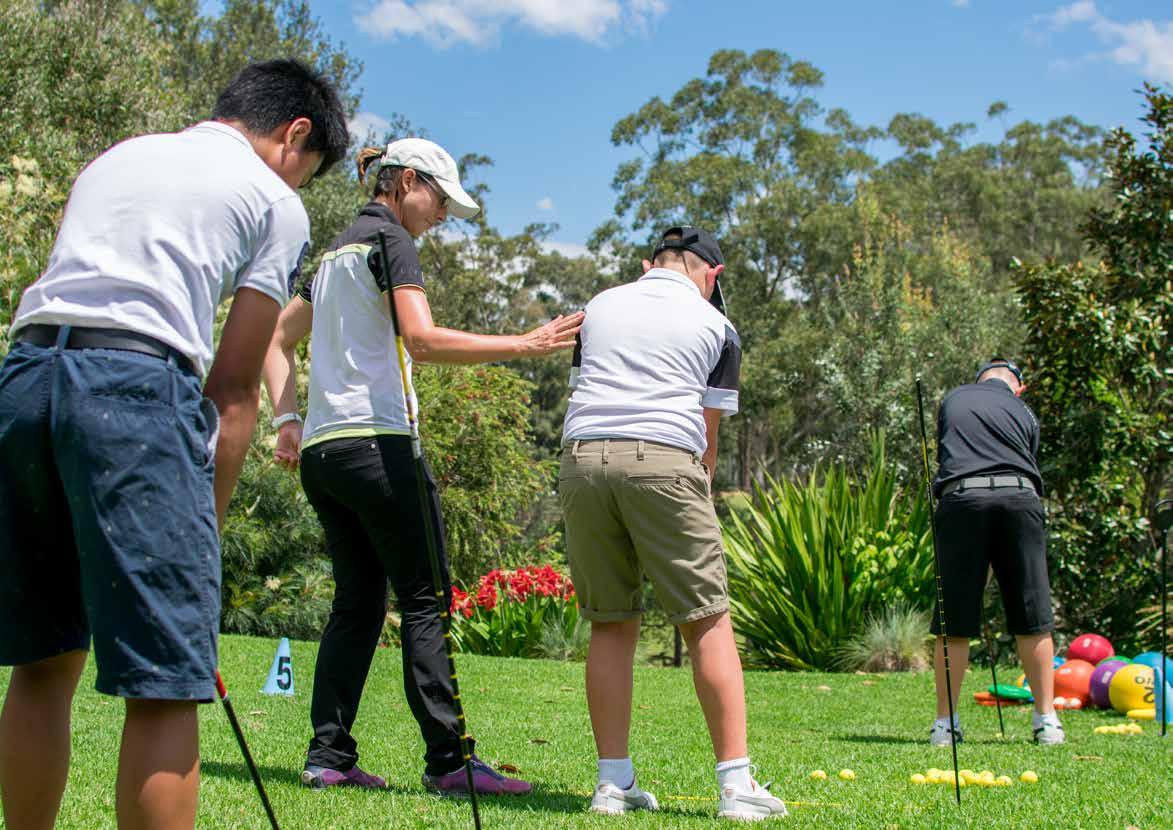
In 1996, Helen Lowe, Associates Captain at the time, suggested to the Board that a program should be initiated to promote junior golfers with the aim of introducing young people into the membership ranks. The Board readily accepted the proposition that they should do what they could to encourage the youth of the community to take up golf.

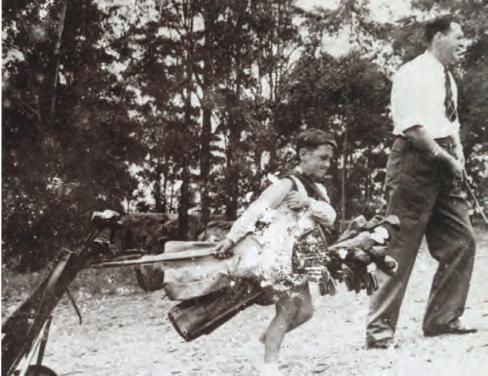
The Junior Golf Program began in 1999 and has since developed into a full Academy that offers a variety of programs to young people aged up to 21 years.
The Pennant Hills Junior Golf Academy is subsidised in part by the Kendal Binns Junior Development Fund which is funded by members. Kendal Binns’ contribution to junior development saw him awarded Life Membership of the Club in 2021.
The aim of the Academy is to provide programs for all levels of junior golfers from beginners wanting to try a new sport to advanced juniors wanting to play tournament golf. Juniors are able to participate in the Jack Newton Junior Golf (JNJG), Golf NSW junior events and the US Kids events.
When highly qualified coach Rachel Bailey joined the Club in 2015, there were just 10 juniors. Now the Academy boasts over 70 juniors coming to train and to learn. Rachel was recently appointed coach of the Australian Junior Womens Team.
The Encourage Shield is an interclub competition run by JNJG for children aged 6 to 12 years. Our girls first played in 1996 and our boys in 1997. In 2020, our team won the Sydney Metropolitan series then finished 3rd in the state event.
Many of our members started golf as caddies, as seen here in 1955 with four sets of clubs.
The winning Encourage Shield Team, 2020. L-R: James Dailly, Brian Wu, Riley Lam, Matthew Nathan, Wenxin Wang, Agatha Hui.
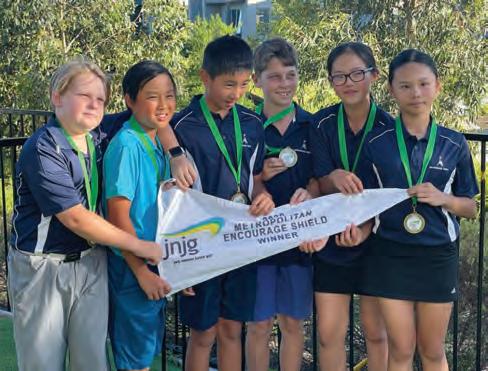 Kendal Binns 1923–2022.
Kendal Binns 1923–2022.
2021. Juniors and families enjoying a fun event. Smoke from summer bushfires colours the sky.



Every game begins and ends in the pro shop and so the role of the club professional in engaging with members cannot be overstated. The pro shop was run as a private business by the club professional until 2010, when the Club took over management. The Club has enjoyed the services of several professionals who remained with the Club for many years. George Howard was our first club professional, in the role from 1924 to 1932, but then changing roles to be Head Greenkeeper and staying until 1948. Bill Davidson was with the club from 1939 to 1966 and Ian Alexander from 1966 to 1996.
In the early days, besides coaching, much of the professional’s work was in making and repairing golf clubs. Roles have gradually changed. While still devoting much of their time to coaching and to advising on and selling all manner of golfing equipment, the professional now oversees timesheets and competitions.
Our current club professional, Director of Golf Neil Rolfe, joined the Club in 2018 and quickly built a strong team of enthusiastic and knowledgeable staff. It is great to start your round of golf with a friendly welcome, assistance with equipment and sometimes, a very useful coaching tip. The professionals can always be counted on to help out with the women’s Annual Charity Day where, for a small donation, they will drive a ball over the gully or attempt a hole-in-one on the 14th hole.
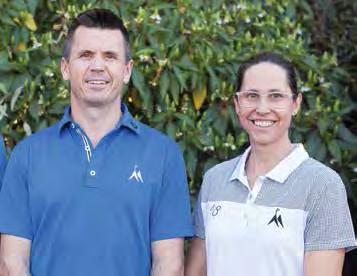
Soon after the worldwide Covid 19 pandemic began in January 2020, the Royal and Ancient Golf Club of St Andrews (the R&A is the governing body of golf in our part of the world) announced modified “Model Local Rules” in order for clubs to operate in a Covid-safe environment. Such rules, most of which were adopted by our Club, included:
• Flagsticks: Requires that players leave flagsticks in at all times.

• Scorecards: Players must enter their own score on scorecards.
• Bunkers: No rakes in bunkers and preferred lies.
Unlike some other States, NSW golf courses were only closed for a matter of days when Government restrictions were first introduced. Subsequent changes to restrictions led to changes in the day-today operations of the Club including the closure of clubhouse facilities, limitations on playing group size and, perhaps the most challenging, travel restrictions that denied many members the ability to visit the Club at all. In some cases members
were subjected to time limits which prevented them from playing a full round.
Nowhere has the emphasis on member benefits been more evident than in the absolute determination of our Board and staff to keep members playing during the ever-changing regulations in lockdown periods. During the tightest lockdown in mid-2021, around 30% of our membership was unable to play at the Club because of travel restrictions. Following an initiative by our Club, an agreement was organised with a number of private golf clubs around Sydney to allow members from other clubs to play. While about 160 of our members were able to take advantage of this arrangement, our Club was able to host more than 100 golfers from other clubs.
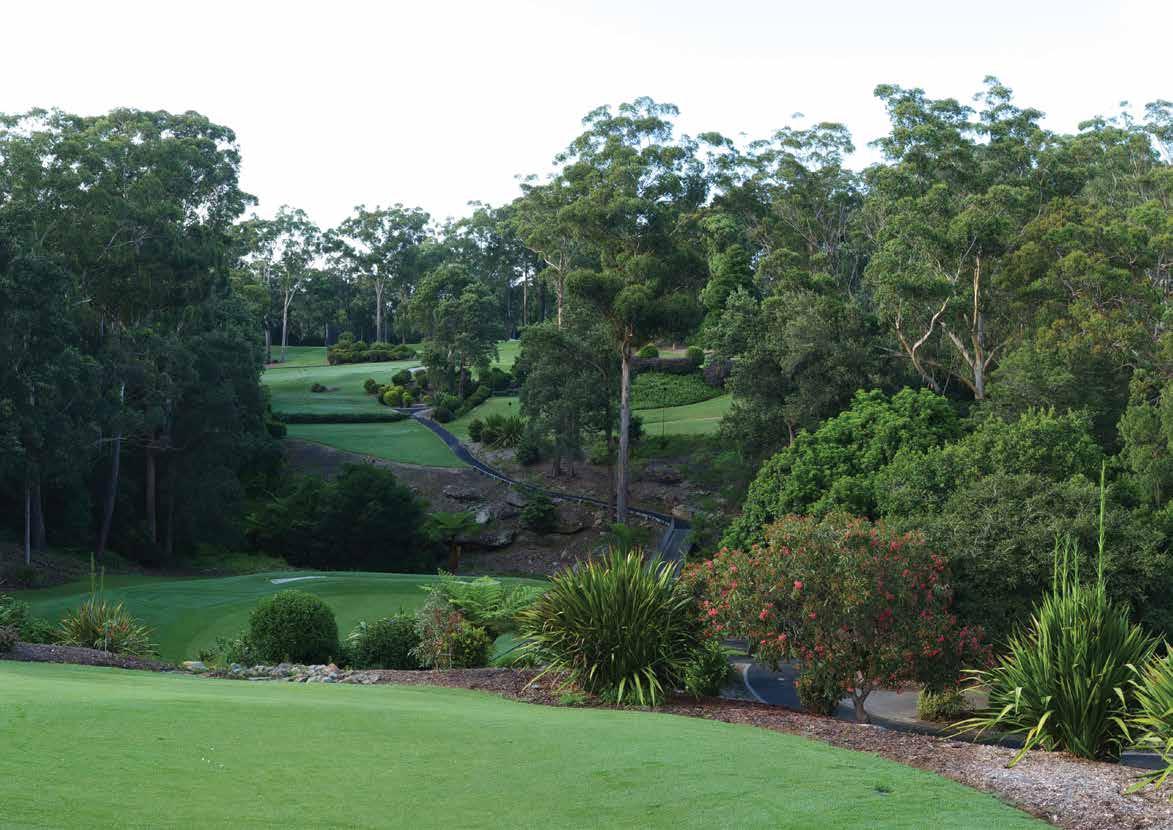
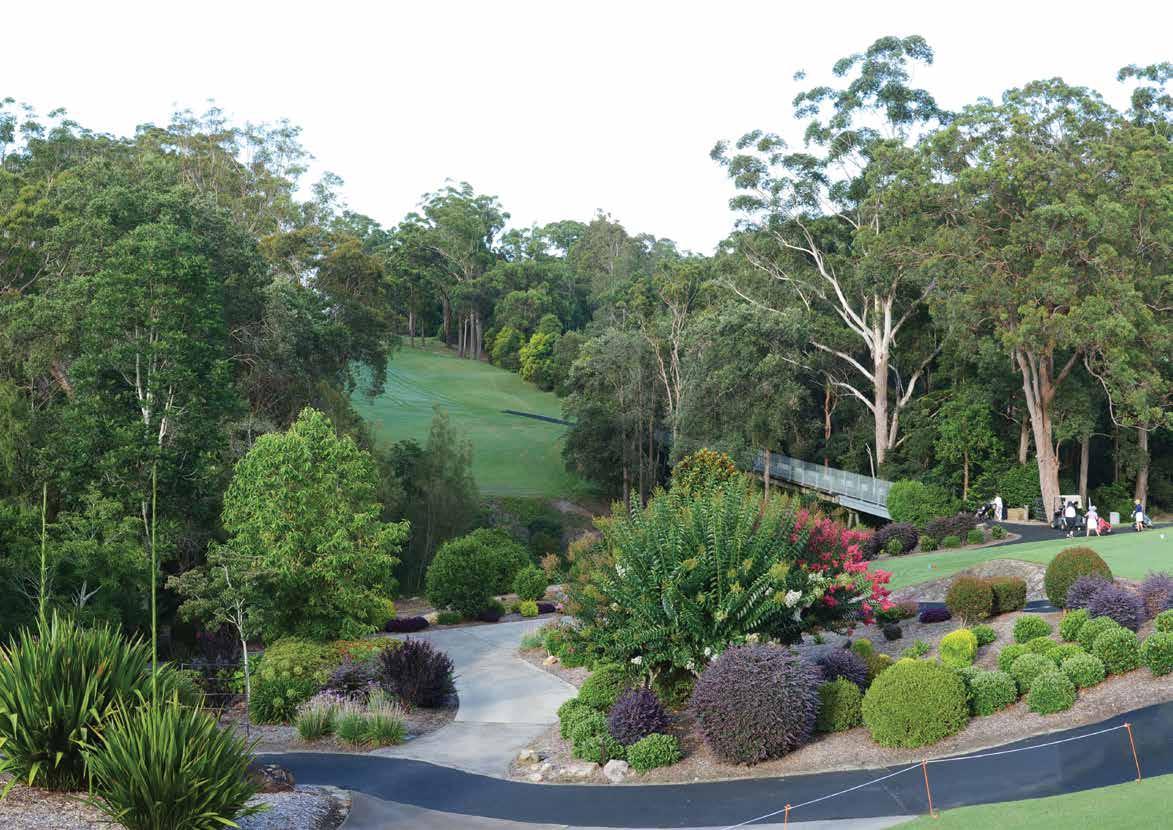
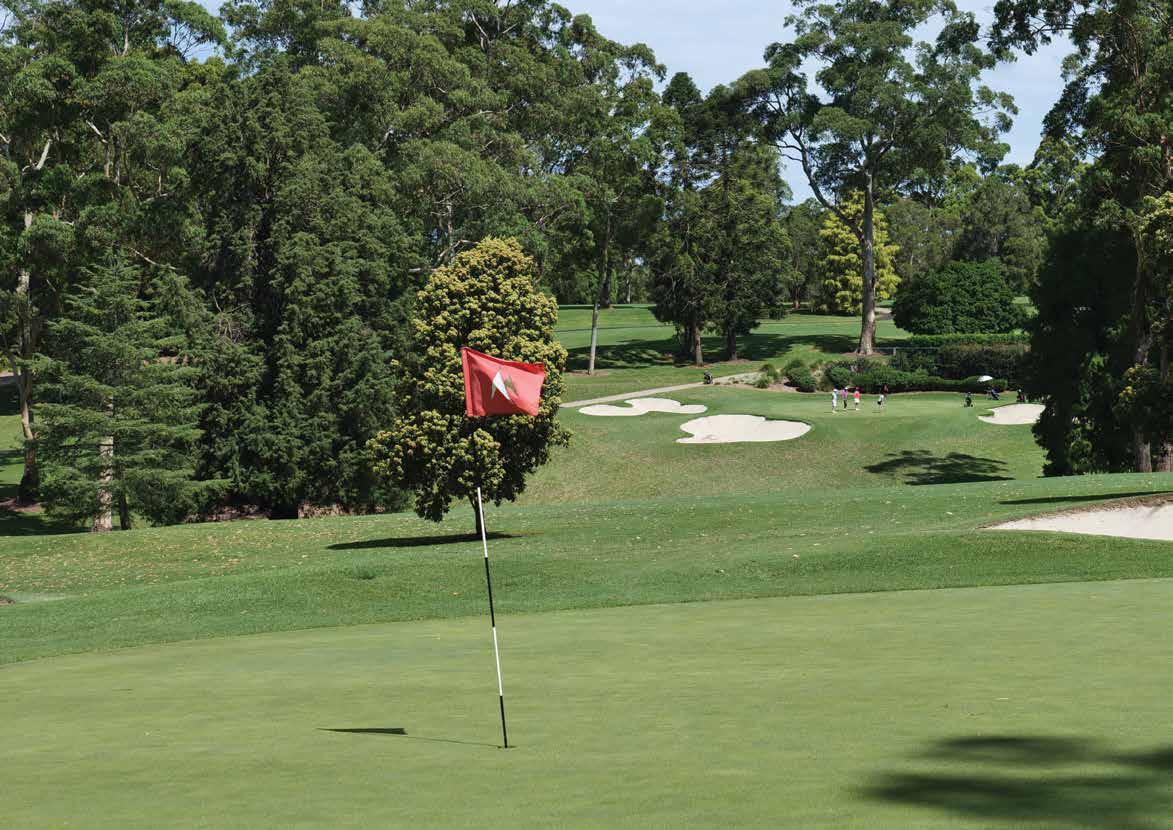
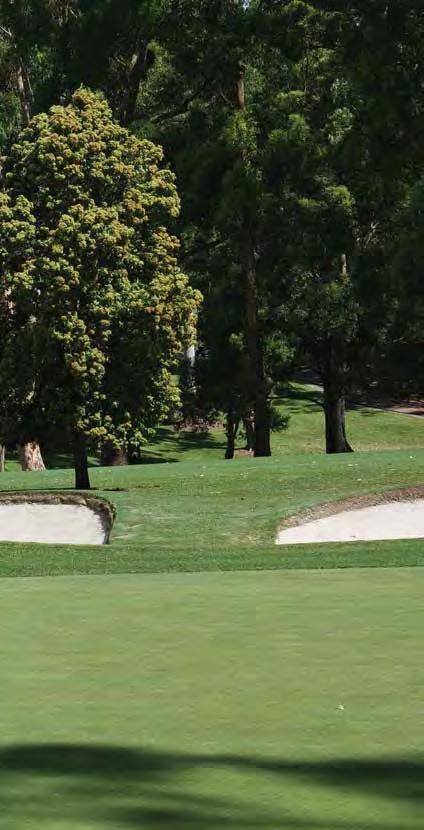
From the early days when a group of Beecroft residents gathered to discuss the genesis of the golf club, and throughout its 100year history, the great joy of the Club has been the story of its enthusiastic and dedicated members.
Our founding members, Arthur C Holt who instigated the formation of the Club, Robert Vicars who championed the land deal for the golf course, Thomas B Nossiter, our first president, John A North our first captain and Ernest J Hyde, president from 1933 to 1950, would surely be pleased with their legacy.
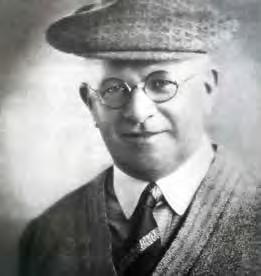

The Club has had the benefit through the years of the experience and determined hard work of its excellent Directors. At the AGM of 2000, women members
were given voting rights in elections for the Board of Directors for the first time, and in 2003 they were given the right to nominate for the Board. It was another 6 years before our first Lady Director, Beverley Archer, was elected to the Board.
The first Ladies Committee meeting was held in February 1924. After electing their office bearers, they straight away set up a social sub-committee. The first entertainment organised was a bridge night held on 21 March. Information is sparse but it appears that dances held in
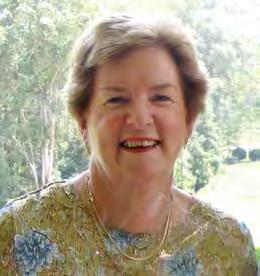 John A North Thomas B Nossiter
Beverley Archer
John A North Thomas B Nossiter
Beverley Archer
the Beecroft School of Arts were popular and bridge parties were held in private homes, all with the aim of raising funds to benefit the Club and charities. The women have continued to drive the social life of the Club.
What truly makes a great club are the people who come together to enjoy it.
A study of member statistics since 1923 shows that the average length of membership is nearly 25 years. This number alone speaks volumes for the
warm and friendly Club atmosphere created by our members.
Enjoying the longest memberships are John Duckworth who joined in 1948 (75 years) and Shirley Baker who joined in 1953 (70 years).
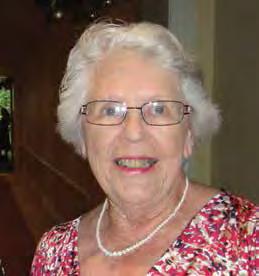
 John Duckworth
Shirley Baker
John Duckworth
Shirley Baker
STATISTICS
1923 SHOWS THAT THE AVERAGE LENGTH OF MEMBERSHIP IS NEARLY 25 YEARS.
The sport of golf is, of course, wellknown for its 19th hole celebrations and debriefings but our members are always ready to enjoy a variety of social events. With an extensive range of organised activities and with our excellent catering staff there are many reasons to come to the Club. While major events include Annual Dinners, Sportsmen’s Night, Mother’s Day and Father’s Day luncheons and Family Christmas Day, almost any excuse to enjoy the Club’s facilities is taken advantage of, creating an environment where lifelong friendships are forged and nurtured.
The first Club ball was held at the Beecroft School of Arts on Friday 2 July 1926. By 1934, a larger venue was needed and the annual ball was held at the Wentworth Hotel Ballroom. Completion of the clubhouse extensions in 1939 meant future events could be held there.
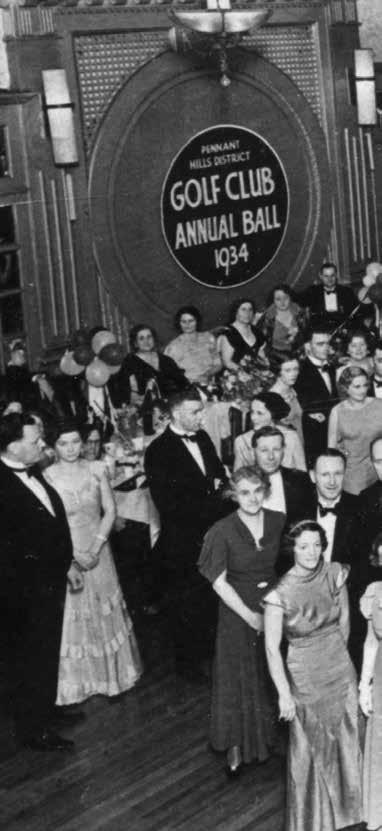
TO CELEBRATE THE END OF THE WAR YEARS:
“A dance will be held at the Club House on New Year’s Eve. Dancing will be from 10pm to 4am, and breakfast will be served.
Tickets are 15/- per person and the number will be limited to 200. Tickets may be obtained from the Secretary only. Dress informal.
FROM A NOTICE TO MEMBERS, DECEMBER 1945.
1934. Pennant Hills District Golf Club Annual Ball.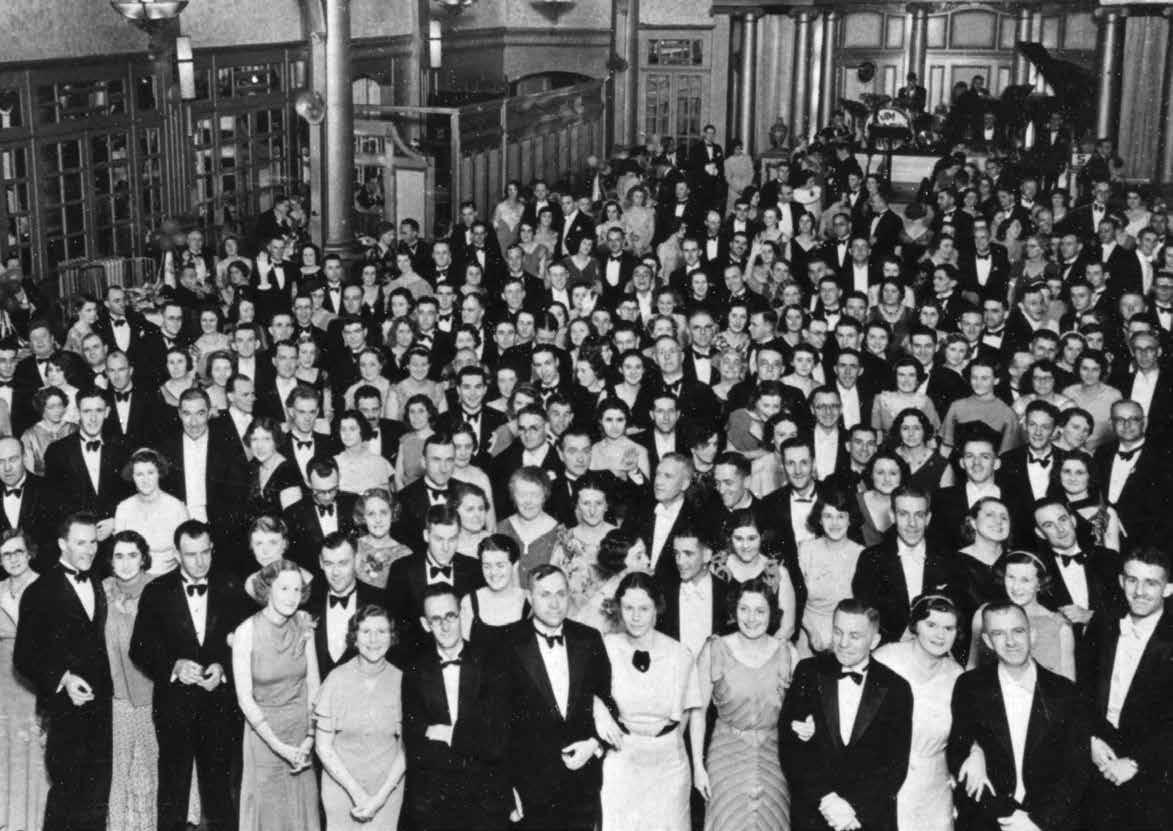

To celebrate the Club’s 50th anniversary, an attempt was made on the world’s speed golf record. Organised by John Ferris, the idea was to have a number of members scattered around the course who would attempt to set a fast time for one ball to be hit from the 1st tee to the 18th hole.
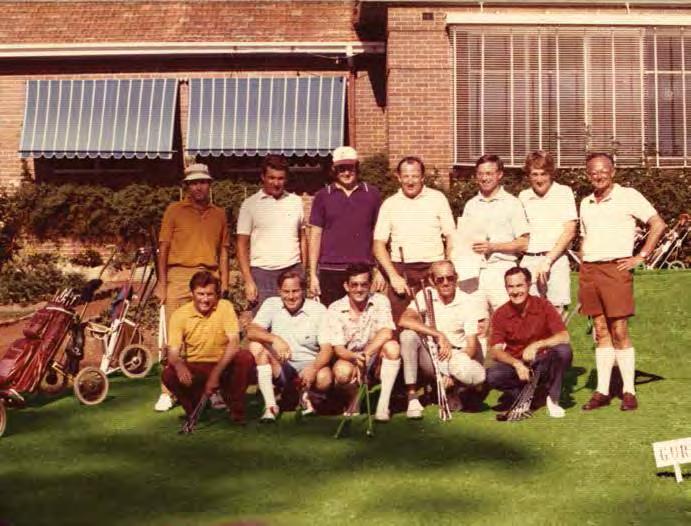
As reported in the Hills Newsletter;
“Proving one of the most popular events of the year, the ‘World’s Fastest Game’ attempt was a game full of fun and entertainment and good club spirit. Two teams attempted the event. The first team completed the course in 18 minutes 17 seconds, while the second team took 20 minutes 53 seconds. The first team, at their second attempt .… took only 15 minutes 43 seconds, completing the second nine in 6 minutes. There have been faster games recorded with larger teams but the Club was attempting to have this time recognised as the world’s fastest for a team of 20 players on a course over 6000 yards long.”
Some of the highlights included Tony Gresham’s drive on the first, which ended adjacent to the 2nd tee, Greg Wicks threw from the 9th to the 10th tee after putting out and John Heffernan chased a ball on the 10th, fell over and, without regaining balance, pitched it 3 feet from the pin.
1972 Fastest team. PHGC 50th Anniversary fun event.In September 1973 the publishers of the Guinness Book of Records wrote to advise that this “fastest round” had been recognised.
On the 75th anniversary, another attempt was made on the speed record, this time with a mixed team of 40 players. The ball was propelled around the course at a lightning speed of 15 min 23 sec. On the second attempt, the team achieved the amazing time of 14 min 15 sec, clearly bettering the time recorded 25 years before.
For the 9-hole competition which followed, quite a number of players recalled the early days by dressing in plusfours, plus-twos and neckties.
Being strong on tradition and, of course, celebrating good times, another speed golf event is planned for our Club’s 100th anniversary. Some members of the 75th anniversary team will again be involved.

From the beginning, Club members have been very active when it comes to raising funds, whether it is for a charity or for special projects around the clubhouse. The biggest charitable event supported by the Club each year is the ASX Refinitiv Foundation Golf Day. The Foundation aims to help Australian-based children’s disability and medical research charities. The ASX Golf Day has been held at Pennant Hills every year since the inception of the Foundation in 1999. The event runs over two days but many members of the Club volunteer their time over 4 days to help organise, set up and run proceedings. Everyone works very hard to make sure that all participants enjoy a wonderful time and that the Foundation receives maximum support.
The MonSTar Foundation hosts an annual golf day at the club and this too is generously supported by members who also volunteer with course set-up. The Foundation raises funds for Motor Neurone Disease as well as supporting educational programmes for children with disabilities and special learning needs.
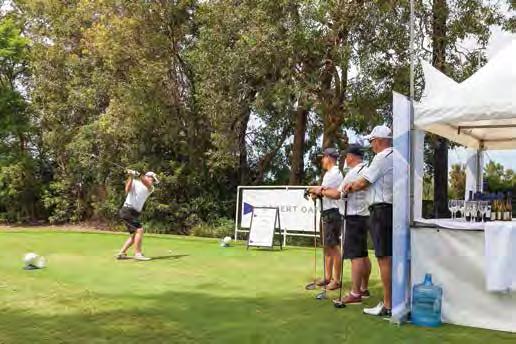
Since 2008, the women have dedicated one Thursday, usually in October, to raising money specifically for cancer research. This Annual Charity Day and
accompanying raffle receives generous donations from across our membership as well as the pro shop and house staff. Initially the funds raised were used to support breast cancer research. Now, however, the focus has broadened to include all cancers. The day also provides an opportunity for our retired women golfers to join in a very competitive putting competition and to mingle over morning tea and lunch.
Every year in August, the men play for the Remembrance Trophy in conjunction with the Ex-Servicemen’s Trophy. The Remembrance Trophy has been played since 1947 and the Ex-servicemen’s Trophy since 1946. The event is held to recognise those of our members who have served their country. Beginning with a hearty barbeque and including a shoot-out on the 14th hole, very generous amounts are raised for Legacy.
2019. ASX participants on the 5th tee.One of the outstanding events in the Ladies’ calendar is the Annual Dinner which was first held in 1954. The dinner celebrates the end of the busy year, and traditionally features an address by the Club Champion, a delicious Christmas
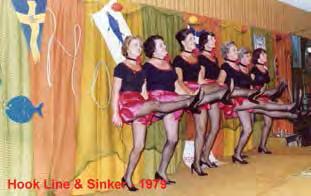
years
dinner and the opportunity to catch up with old and new friends. Since 1964 the formalities have been followed by the now famous Christmas Concert. Life Member Betty Musgrove initiated the concert tradition and set the standard
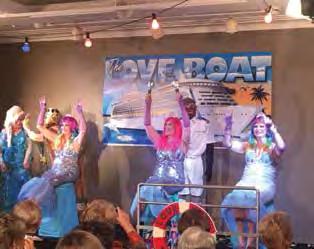
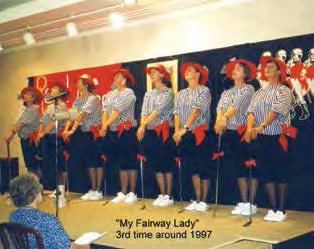
very high indeed. Secret women’s business characterises the many months of planning for the concert, with a night of hilarity and hijinks always on the cards. These concerts are much anticipated, with an extraordinary contribution made by the team of volunteers who produce, direct, take to the stage and organise props and costumes, all to the delight of the captive audience. The night is also a major fundraising activity for a chosen charity.
Unfortunately, the men are not invited to this marvellous night but in recent years they have been invited to a preview event one day prior.

CLUB MEMBERS HAVE BEEN VERY ACTIVE WHEN IT COMES TO RAISING FUNDS, WHETHER IT IS FOR A CHARITY OR FOR SPECIAL PROJECTS AROUND THE CLUBHOUSE.
Bridge remains a very popular pastime. The monthly Friday Card Day and Ladies Tuesday morning bridge are enjoyed by many members, especially those who have retired from playing golf but want to maintain strong links with their golfing friends and with the Club.
Gwen Symons, daughter of George Howard (our first professional 1924-1932), pictured here enjoying a game of bridge with friends at the Club in December 2021. Gwen lived her early days in the caretaker’s lodgings attached to the clubhouse. She joined the Club in 1962 and was an accomplished golfer. Sadly, Gwen left us before her centenary was achieved.
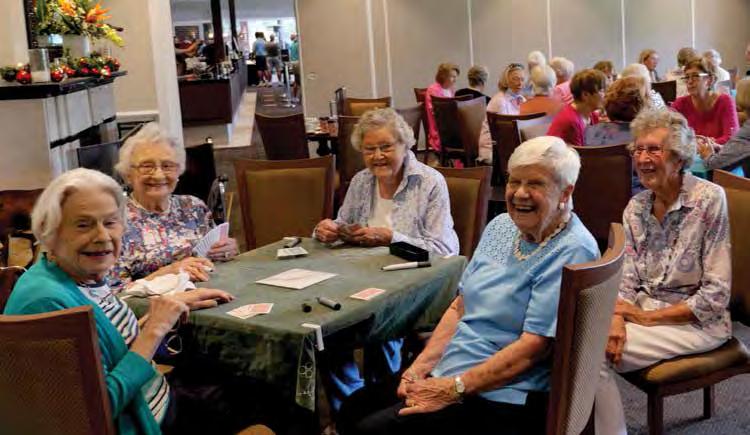
As noted by President Michael Rowan at the Foundation relaunch in June 2021, where John Eales was guest speaker:
“John [Eales] described perfectly what leads people to select their ‘Club of choice’ and how a Club is only as good as the selfless acts of members who give generously to advance its aims, culture and capacity. How each member might act to make it a better Club.”
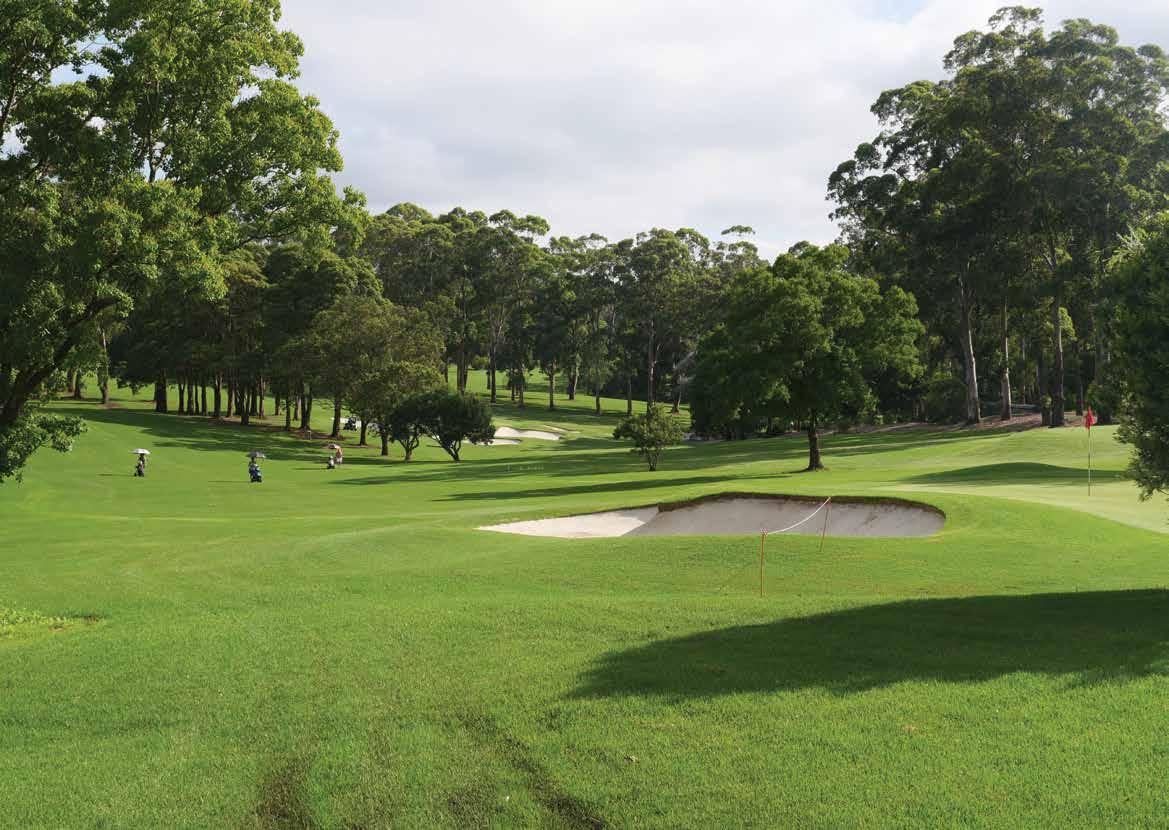
Tom NOSSITER
EJ HYDE
1923-1933
1934-1953
Harry SMALL 1954-1957
Bill NORTHEY 1957-1963
Bill SHORTLAND 1963-1968
John JONES 1968-1972
Jack THOMSON
1972-1976
Bill SCOTT 1976-1979
Geoff WILLIAMS 1979-1982
Paul HENRICKS 1982-1991
Jack MULVANEY 1991-1994
John OAKLEY 1994-1998
Tony CURRY
Dick WEBB
Bruce LUMSDEN
Steve WALKER
Ian BLAIR
Chris PRAGNELL
1998-2000
2000-2003
2003-2005
2005-2009, 2018-2020
2011-2014
2009-2011
Alan WATSON 2014-2018
Michael ROWAN 2020-
John North 1924-1926, 1927-1928
Gordon VERNON
1926-1927, 1928-1929
Terry DALY 1928-1929
Robert VICARS Jnr 1929-1930
Ernie DORAN
1930-1932
Bert THEW 1932-1938
Tom DENCE
1938-1941
Harry SMALL 1941-1942, 1944-1945
Joe GRAHAM
Frank PARKER
John GRANT
Tom CARRUTHERS
Jim HINES
Eric THEW
Vic KENDALL
Bob WICKENS
Trevor MANSER
Harry STOYLES
Ken PURCELL
1942-1944
1945-1947
1947-1949
1949-1952
1952-1958
1958-1963
1963-1969
1969-1978
1978-1984
1984-1990
1990-1994
Dennis CLARK 1994-1997,2000-2001
Tony GRESHAM
Chris ALLEN
Darcy CLUFF
Rob STEVENSON
John BUCHANAN
Chris PRAGNELL
Damian MAGUIRE
1997-2000
2001-2006
2006-2010
2010-2015
2015-2018
2018-2021
2021-
Violet VICARS
1924-1932
Helen NOSSITER 1933
Mabs LYON 1934
Mary HYDE
Vera DAVIS
Celebrating 100 years
Ethel HOLT 1924-1925
Mabel MORGAN 1926
Mollie VICARS
1935-1937
1938-1950
Thelma WHIPP 1951-1955
Gwen BARMBY
Margaret CALLOW
Joy HALLORAN
Dixie LOVELL
1956-1960
1961-1964
1965-1968
1969-1972
Mollie SUTIJERLAND 1973-1976
Betty MUSGROVE
Meg HORNBROOK
Pat JONES
Isabel MORTLOCK
Eilene HENRICKS
1977-1980
1981-1984
1985-1987
1988-1990
1991-1992
Ann HELY 1993-1996
Betty HUGHES 1997-1999
Sue FABIAN 2000-2003
Helen LOWE 2003-2006
Lucie GABB
Chrissie GRIER
Margie DEARLOVE
Susie NICHOLAS
1923-2023
1927-1930
Jean DERRIN 1931-1933, 1938-1947
Constance ATWILL 1934
Agnes DENCE 1935
Lillian BALL 1936
Marj BECK
1937-1938
Peggy SEALE 1948-1949
Margaret CALLOW 1950-1952, 1956-1957
Gwen LILLYCROP 1953-1956
Gwen OXLEY 1958
Fran STRATFORD 1959-1961
Dixie LOVELL 1962-1965
Betty QUAYLE 1966
Gai JACOBSEN 1967-1970
Mollie SUTHERLAND 1971-1972
Margaret KENDALL
1973-1974
Norma ALLEN 1975-1977
Eilene HENRICKS
Pat JONES
2006-2009
2009-2012
2012-2016
2016-2019
Judy TRICKETT 2019-2022
Susie WALES 2022-
1978-1980, 1989-1990
1981-1984
Pat DANIELS 1985-1988
Helen LOWE 1989-1994
Val BRADLEY 1995-1998
Gail CARPENTER 1999-2002
Bev ARCHER 2003-2006
Rhonda PARKINSON 2007-2010
Judy DEAN 2010-2014
Lesley ROBERTS 2014-2017
Sally MOFFAT 2017-2020
1924, 1936-1937Bert REED
1925Jack RIDDELL
1926-1927, 1929-1931Greg (Bert) CUTLER
1928, 1938Ernie DORAN
1932George SOMERVILLE
1933 Fred HOOTON
1934 Charles WEBSTER
1935Tom DENCE
1939Charlie BROWN
1940-1945 Not played
1946Joe GRAHAM
1947, 1949Sandy RICHIE
1948, 1950, 1953-1954, 1957Charlie CARRUTHERS
1951-1952Ewan LEAN
1955-1956Jack SPARROW
1958Abbie BENTLEY
1959-1960, 1963 Bill WRIGHT
1961Barry RATCLIFFE
1962, 1964-1980, 1982-1983, 1985-1986, 1988-1990 Tony GRESHAM
1981Malcolm JONES
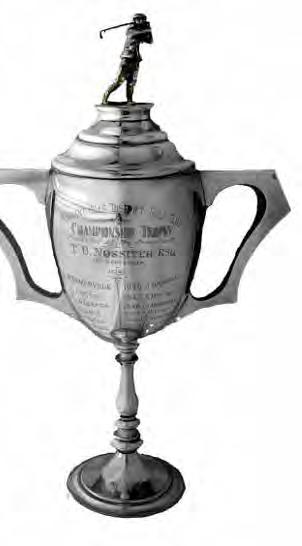




















1984Brad ANDREWS
1987Gerry POWER
1991Brett RICHARDSON
1992-1995, 2001Mark STRONG
1996Phil BUSH
1997, 1999, 2000Grant NAYLOR
1998 Andrew STREATFIELD
2002Stuart EDWARDS
2003-2004David GRANT
2005-2009Murray FOGARTY
2010Jerram CHUDLEIGH
2011 Alex TRAN
2012Beau McDonald
2013, 2018Ben CLAPHAM
2014Luke FERRIER
2015Matt DAVIDSON
2016, 2019, 2020Andrew RICHARDS
2017Damian MAGUIRE
2021Jared DRIES
2022Ryan RICHARDS
1924-1928Mabel MORGAN
1929, 1930Lilie LOWE
1931Nancy HARROP
1932Marj BECK
1933Irene MORGAN
1934, 1935H. ATWILL
1936Lillian BALL
1937Irene MORGAN
1938Annette BROWN
1939Agnes DENCE
1940-1945 Not played
1946-1952Jean SMITH
1953, 1954June RABB
1955, 1957-1964, 1966, 1968 Lavene TAYLOR
1956Marjorie RINGROSE
1965, 1967,1971Barbara HENNESSY
1969, 1970, 1972, 1975,1983, 1984Eileen HENRICKS
1973Jo DOWNES
1974, 1989, 1991, 1995 Jan WILSON
1976, 1978-1980, 1982Jenny SWADLING
1977 Julie WOODS
1981, 1987Christine DEAN
1985Jenny ABRAHAMS
1986Sue SERHAN
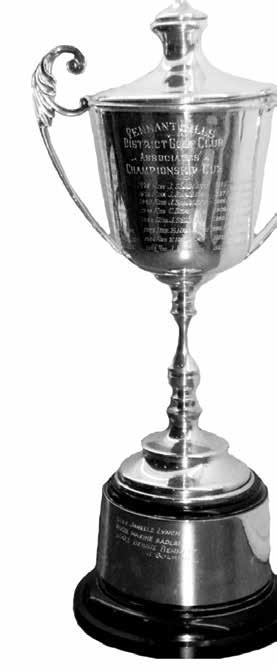




















1988Beth BLACK
1990, 1993Jeanie DOOLAN
1992Sally SMITH
1994, 1996-1998 Margaret REDWARD
1999-2000Sandy LONERGAN
2001Janelle LYNCH
2002Maxine SADLER
2003, 2005-2007, 2010Deb BENNETT
2004Julia BOLAND
2008 Laura VAN BAALE
2009Candice NERTNEY
2011, 2013Lauren HIBBERT
2012Ashley CRAMOND
2014Paige STUBBS
2015, 2017 Liz VAN HOOVEN
2016Kathy ELDRIDGE
2018, 2020Hannah SNEATH
2019Mary-Jo USHER
2021Monique HERMAN de GROOT
2022Anne ELDRIDGE
Name Year
ABRAHAM, Peter 1993
ABRAHAMS, Wayne 2010
ADCOCK, Geoff 1974
AGGAR, Brent 1994
AI, George 2020
AINSLIE, Evan 2021
AKDOGAN, Bill 2021
ALEXANDER, Ron 1994
ALFAFARA, Josh 2021
ALLEN, Chris 1984
ALLUM, Don 1964
ALY, Abbas 2012
ALY, Hayder 2017
AMEEN, Ahmadul 2017
AMOS, Anne 2013
AMOS, Deborah 2010
AN, Michael 2021
ANDERSON, David 1988
ANDERSON, Edward 2021
ANDERSON, Gail 2021
ANDERSON, Ian 1996
ANDERSON, Jim 1964
ANDERSON, John 1974
ANDERSON, Matt 1987
ANDREWS, David 2013
ANTONAS, George 2022
ANTONENAS, James 2006
ANTONINI, Simon 2021
ARAVANDIYA PILLAI, Mohan2019
ARCHER, Beverley 1988
ARTHUR, John 1995
ARTHUR, Mark 1985
ARTINDALE, Don 1974
ARTLETT, Rosemary 2012
ARTLETT, Stephen 2012
ASHTON, Geoff 2019
ASHTON, Norma 1992
ATKINSON, Hugh 1981
AXFORD, Jacqui 1963
AYNSLEY, Mike 2020
BAGLIN, Zachary 2022
BAILEY, David 2013
BAILEY, Scott 2013
BAIN, Robert 2015
BAIN, Suzanne 2021
BAKARICH, Richard 1980
BAKER, Shirley 1953
BALE, Trevelyan 2020
BAMPTON, Michael 2022
Name Year
BANKS, Laurie 1995
BARBER, Duncan 1994
BARBER, Jan 1994
BARBER, Maureen 2010
BARBER, Peter 1994
BARDWELL, Cath 2003
BARDWELL, Steve 2009
BARKER, Ian 2011
BARNES, Peter 2017
BARRAKET, Jonathan 1993
BARRATT, Jackie 2012
BARRATT, Steve 2001
BARRETT, Paul 2022
BARROWMAN, Andrew 2022
BARTLETT, Robin 1996
BARTSCH, Ron 2012
BASTOCK, Lynne 2016
BATTERSON, Josh 2015
BAXTER, Harry 2022
BAYFIELD, Matthew 2010
BELL, Bill 1999
BELL, Jenny 2013
BELL, Joshua 2021
BELL, Nick 2020
BENAD, Daniel 2022
BENAD, Sophia 2022
BENNETT, Dave 2016
BENNIE, Alex 1966
BENNIE, Andrew 1998
BENNIE, Marc 1998
BENTIVOGLIO, Marcus 2021
BERNE, John 1986
BERNE, Noelene 2010
BERRY, Neil 1995
BEVEN, Carlie 2016
BEVEN, Errol 1967
BEVEN, Riley 2020
BEVEN, Tony 2002
BEZETT, Simon 2016
BIASUCCI, Andrea 2021
BINNS, Kendal 1958
BINNS, Ruth 1997
BIRTLES, Jeffrey 2011
BISHOP, Ben 2020
BISHOP, Richard 2016
BLACKET, Hugh 1988
BLACKSHAW, David 2019
BLACKSHAW, Kian 2020
BLAIR, Coral 1999
Name Year
BLAIR, Ian 1991
BLAKER, Lorna 2002
BLEAKLEY, Paul 2021
BLYTON, Will 2022
BOARD, Martin 2016
BOARD, Meg 2016
BOLADERAS, Kirk 2021
BOLLOM, Bruce 1983
BOLLOM, Geoff 2009
BONNICHSEN, David 2011
BOOKER, Annie 1998
BOOKER, Don 1981
BORHAM, Tim 2022
BORLAND, Evan 1992
BORLAND, Neal 2002
BORROMEO, Max 2014
BOULT, Jacquie 2017
BOULTON, Rhonda 1987
BOURKE, Geoff 2020
BOURKE, Lynne 2021
BOWDEN, Cathy 2014
BOWDEN, Liam 2021
BOWDEN, Michael 2019
BOWYER, Marg 2010
BOYDEN, Peter 2015
BOYS, Daniel 2016
BOYS, John 1987
BOYS, Mark 1999
BOYS, Paul 2000
BRADBURY, Chris 2015
BRADBURY, Julie 2015
BRADBURY, Mark 2015
BRADBURY, Nick 2016
BRADLEY, Scott 1992
BRADY, Geoff 2007
BRAGG, Arthur 1985
BRAMSTON, Adam 2021
BRAMSTON, Robert 2019
BRAY, Greg 2022
BRAZIER, David 1974
BRENNAN, Damian 2021
BRENNAN, Trent 2005
BRERETON, Carolyn 1998
BREW, Arthur 2021
BREW, Berenice 2022
BRICE, Gordon 2017
BRIGGS, Mike 2001
BRILLANTES, Karlo 2020
BRINGOLF, Daniel 2022
BRISTOW, Daniel 2018
BRISTOW, Tony 2018
BROOKS, Frank 2007
BROWN, Bruce 2015
BROWN,
CHAPMAN, Henry 1988
Name Year
CHAPPLE, Annelie 2015
CHARLES, Bev 2009
CHEADLE, Jo 1991
CHEADLE, John 1975
CHEADLE, Peter 2010
CHEATHAM, James 1992
CHEHADE, Joe 2015
CHEN, Adam 2021
CHEN, Nicole 2016
CHEN, Ted 2014
CHO, Michael 2021
CHOI, Jonathan 2021
CHOPRA, Naseem 2009
CHOPRA, Uday 2008
CHRISTIANSEN, Brian 2016
CHUDLEIGH, David 1996
CLARK, David 1999
CLARK, John 1991
CLARK, Peter 1991
CLARKE, Paul 2022
CLISDELL, Kerrie 2007
CLISDELL, Michael 2019
CLUFF, Darcy 1976
COBLE, Keith 1967
COCKS, Cilla 1998
COETZEE, Matt 2014
COFFEY, Simon 2001
COFFEY, Will 2022
COLEMAN, Judith 1977
COLLESS, Christine 1993
COLYER, John 1977
CONROY, Gordon 2003
COOK, Peter 1955
COOPER, Jan 1999
COOPER, Jill 2015
COOPER, John 2000
COOPER, Scott 2012
CORBETT, Ken 1991
CORBETT, Lachlan 2009
CORBY, Darren 1998
CORDEROY, Bryce 2010
CORDONY, Adam 1995
CORDONY, Chris 1991
CORMACK, Bill 1997
CORNISH, Rob 1993
COTE, Charles 2016
COUGHLAN, Chris 2014
COULTON, Allan 1995
COULTON, Chris 1988
Name Year
COULTON, Dave 2013
COULTON, Margaret 2014
COULTON, Nicholas 2020
COUPER, Derek 1996
COUSINS, Ian 2019
COVER, Jennifer 1983
COVER, John 1988
CRAIG, Warren 1993
CRANE, Belinda 2010
CRAWFORD, Leslie 2018
CRAWFORD, Robert 1956
CRAWLEY, Gary 2010
CRESSWELL, Simon 2022
CRIBB, Peter 1997
CRIDLAND, Andrew 2008
CRISP, Ann 1983
CRISS, Martin 2020
CROCKER, Matt 2021
CROFT, Colin 2004
CROOKSHANK, Rory 2020
CROSBY, Bill 1983
CROSBY, Jan 2010
CROSS, Jenny 2004
CROSS, Rob 2003
CUDA, David 2007
CULLY, Ben 2010
CUNNEEN, Andrew 2010
CUNNEEN, David 2007
CUNNEEN, Pam 2006
CUNNINGHAM, Corey 2004
CUTLER, Malcolm 2009
CUTLER, Norelle 2009
DA SILVA, Christian 2019
DAILLY, Elena 2020
DAILLY, James 2017
DAILLY, Kirk 2017
DAILLY, Scarlett 2021
DALTON, James 2016
DALTON, John 1983
D’ANDRETI, Joe 2006
DARGAN, Michael 2016
DAVEY, Andrew 2003
DAVEY, Brent 2020
DAVEY, Tom 2016
DAVIDSON, Andrew 1985
DAVIDSON, Matthew 2011
DAVIE, Kieren 2021
DAVIES, Colin 2021
DAVIES, John 2019
Name Year
DAVIS, Gordon 1970
DAVISON, Judith 2017
DAVISON, Warren 2012
DAWSON, Graham 2014
DAY, Andrew 2001
DAY, Michael 2001
DAY, Todd 2011
DAYHEW, Matthew 2022
DE CARVALHO, Ann 1997
DE CARVALHO, Vasco 1984
DE VRIES, Antony 2009
DEADMAN, Garry 2000
DEADMAN, Louise 2010
DEALL, Linda 2015
DEANE, Alexander 2002
DEANE, Hilton 2018
DEARLOVE, Kevin 2007
DEARLOVE, Margie 2002
DEARLOVE, Ray 1991
DEED, Jo 2010
DEEGALLA, Krishan 2021
DENBY, Alan 2015
DENNIS, Christine 2017
DENNY, Cyril 1980
DEVALIA, Pradip 2004
DICKSON, Stuart 2007
DINCEL, Bora 2015
DINH, Anh Huan 2021
DINH, Linh Lan 2022
DINH, Nguyen Khoi 2022
DITZELL, Peter 2015
DIXON, Bob 1993
DIXON, James 2022
DOCHERTY, Derrick 1977
DOHERTY, Geoff 1992
DOHERTY, John 1986
DONOVAN, George 1991
DOWNES, Derek 2011
DOYLE, Fergus 2007
DOYLE, James 2018
DOYLE, Pam 2010
DRAGICEVICH, Dan 2016
DRAGICEVICH, Tony 1997
DRIES, Jared 2011
DUCKWORTH, Jan 1973
DUCKWORTH, John 1948
DUDLEY, Geoff 2022
DUNCAN, Neil 2022
DUNCOMBE, Rod 2019
Name Year
DUNN, Robert 1993
DURHAM, Helen 2000
DWYER, Garrett 1994
EBERT, Bruce 2013
EDGE, Rod 2013
EDSTROM, Staffan 2010
EDWARDS, David 1981
EDWARDS, Joshua 2018
EDWARDS, Ken 2015
EDWARDS, Stuart 1999
EDWARDS, Thomas 2019
EINBERG, Clas 1981
EINBERG, Judy 1981
EKERT, Anthony 2015
EKERT, Archie 2021
ELDRIDGE, Anne 2005
ELDRIDGE, John 1985
ELKOJJE, Wally 2012
ELLOY, Keith 2015
ELSLEY, Ann 2015
ELSLEY, Brett 2013
ENGLAND, Robert 1991
EVANS, Richard 2012
EYLES, Joan 2002
EZZY, Fiona 2022
FABIAN, Dan 2022
FABIAN, David 1988
FABIAN, Miranda 2007
FABIAN, Paul 1994
FABIAN, Sue 1985
FAGG, Gordon 1992
FAIRBAIRN, Tim 2013
FAIRFAX, Margie 2003
FAJOU, Lauren 2020
FAN, Abbygail 2021
FAN, Darson 2015
FAN, Emma 2021
FARHART, Maurice 2022
FAZZONE, Pat 1989
FEARNSIDE, David 2007
FELIZZI, Maurice 2021
FELLOWS, Peter 2007
FELLOWS, Ron 1985
FENNELL, Richard 2021
FERDINANDS, Douglas 1985
FERGUSON, Kell 2013
FERNANDO, Ash 2022
FERRARI, Rob 2016
FINDLAY, Deborah 2021
Name Year
FINNIGAN, Bob 2012
FITZALAN, Kel 1997
FITZGERALD, Michael 2004
FITZGERALD, Veronica 2010
FITZGIBBON, Gerrard 2006
FLICK, Penny 1995
FLICK, Stephen 2015
FLYNN, Hilary 2013
FLYNN, Robert 1996
FLYNN, Stephanie 2014
FOGARTY, Murray 2005
FOTHERGILL, Mark 2015
FOWLER, Terry 2022
FOX, Alan 2022
FOX, Chris 2022
FOX, John 2022
FRANCIS, John 2018
FRASER, Clare 1997
FRASER, Peter 2000
FRAZER, Rod 2001
FREELANDER, Andrew 1999
FRERE, Trish 2003
FREY, Lucas 2014
FROST, Geoff 2021
FROST, Glen 2007
FROST, Jonathan 2008
FROST, Renee 2022
FRY, Ian 2013
FRYER, Robert 2017
FU, Bill 2022
FUNKE, Mark 2020
GABB, Lucie 1990
GABILA, Carlos 2022
GABRIEL, Peter 1961
GAGE, Charlie 2017
GAGE, Kelvin 2012
GALLAGHER, Anthony 1991
GALLAGHER, Sarndra 1976
GAMMIE, Jill 2020
GAMMIE, Paul 2018
GAMMIE, Tom 2021
GARCIA, Grant 2021
GARDINER, Isabel 2005
GARNSEY, David 2010
GARNSEY, Noi 2015
GARRIGAN, Susan 1995
GEEKIE, Ron 2020
GELDENHUYS, Jahn 2021
GENTLE, Scott 2020
Name Year
GERDES, Hugh 1993
GERDES, Mitchell 2005
GIBSON, Ken 1989
GILBERT, Michael 1984
GILBERT, Phil 1992
GILCHRIST, Sam 2010
GILCHRIST, Terry 1980
GILLAM, Harry 2016
GOETZ, Guenther 1993
GOGGIN, John 2021
GOLDBERG, Terry 1980
GOLDING, Cass 2016
GOLDING, Cheryl 2001
GOLDING, Jono 2005
GOLDING, Lauren 2017
GOLDING, Mark 1988
GOLDSMITH, John 2006
GOLSBY-SMITH, Tony 2001
GOODACRE, Stan 1961
GOODALL, Jill 1997
GOODALL, Leanne 2002
GOODING, Peter 2021
GOODRICK, Anne 2005
GOODRICK, Mark 2004
GOODRICK, Paul 1991
GOODWIN, Garry 2009
GOOLEY, Sally 1982
GORDON, Neil 2008
GORDON, Tony 2016
GORME, Adrienne 2001
GOTHAM, Chris 1987
GOUGH, Bernie 1999
GOURAV 2022
GRACE, Bobby 2000
GRACE, Meryll 2000
GRACIE, Art 2022
GRAHAM, Jeffrey 1986
GRAHAM, Kerrie 2012
GRAHAM, Peter 2003
GRAHAM, Philip 2006
GRANT, Judith 1990
GRANT, Pam 1983
GRANT, Peter 1977
GRANT, Shirley 2017
GRAY, Hazel 1995
GREEN, Ruth 2021
GREEN, Steven 2001
GREENHALGH, Rodney 2022
GREENWOOD, Norman1962
Name Year
GRESHAM, Tony 1956
GRESHAM, Wendy 1972
GRIER, Angus 2002
GRIER, Cameron 2001
GRIER, Chrissie 1999
GRIFFIIN, Jack 2020
GRIFFIN, Andrew 1987
GRIFFIN, Richard 1991
GRIGSON, Simon 1999
GULCZYNSKI, Andrew 2019
GULCZYNSKI, John 2019
HACKER, Angela 2004
HACKER, Rob 2003
HACKER, Sebastian 2022
HAIGH, Andy 1997
HALMARICK, Andrew 1983
HALVORSEN, Toby 2015
HAMER, Lisa 2007
HAMER, Steve 2009
HAMILTON, Brian 1983
HAN, Heidi 2021
HANDCOCK, Paul 1999
HANDEL, Peter 1998
HANN, Delma 2017
HANNON, Sue 2003
HAO, David 2021
HARDING, Graeme 1997
HARGREAVES, Dan 2009
HARGREAVES, Greg 1995
HARGREAVES, Kim 2007
HARGREAVES, Luke 2011
HARGREAVES, Matthew2005
HARGREAVES, Mick 2003
HARGREAVES, Tony 2008
HARPER, Ron 1993
HARRIS, Greg 2012
HARRIS, Luke 2011
HARRIS, Mitch 2009
HARRISON, Mark 2005
HARRISON, Pamela 1976
HARRISON, Stephen 2001
HARRISS, Luke 2016
HART, Glen 2003
HARTLEY, David 1999
HARVEY, Jenny 2000
HASLEHUST-SMITH, Hugh2022
HATGIS, Tony 2016
HAUGERUD, Oscar 2016
HAWACH, John 2022
HAWORTH, Anthony 2022
HAWORTH, Barbara 1989
HAWORTH, Jane 2004
HAY, Ron 1996
HAYWARD, Margaret 2015
HEANLY, Paul 2001
HEFFERNAN, Bob 1959
HEFFERNAN, Mark 1988
HELLMAN, Anne 2009
HELLSTERN, Robert 2021
HENRICKS, David 1970
HENRICKS, Matt 2000
HENRY, Karl 2008
HENRY, Kirk 2001
HENRY, Peter 2009
HENSLEY, John 2022
HERDEN, Desiree 2021
HERMAN DE GROOT, Monique2017
HERRIOTT, Gordon 1990
HICKEY, Richard 1992
HIGGINS, Rohan 2022
HILL, Charlie 2018
HILL, Peter 2006
HING, Al 2022
HIPKIN, Stephen 2022
HODGE, Brad 1988
HODGE, David 1975
HODGE, Warwick 1971
HODGE, Wendie
Coralie
HUGHES, Joe 2020
Celebrating 100 years
Name Year
HUGO, John 1983
HUI, Agatha 2018
HUI, Danielle 2020
HUNTER, Jeff 2007
HUNTER, Michele 2010
HUNTER, Scott 2010
HUTCHINS, David 1974
HUTT, Ron 2007
HUXLEY, Julian 2021
HUXLEY, Simon 2021
ILLIDGE, Bruce 1998
ILLINGWORTH, Isabel 2013
ILLINGWORTH, Peter 2010
INGRAM, Evan 2021
INGRAM, John 1981
INGRAM, Margaret 1987
INGRAM, Paul 1983
JACK, Craig 2007
JACKSON, Dennis 2013
JACKSON, Jan 2002
JACKSON, Lionel 2015
JACKSON, Paul 2017
JACKSON, Pete 2018
JACKSON, Rod 2003
JACKSON, Ross 1987
JACKSON, Steve 1987
JACKSON, Thomas 2004
JACKSON, Yvonne 2000
JAMIESON, Jo 2003
JARVIS, Matt 2022
JENSEN, Alex 2018
JENSEN, David 1983
JIANG, Joanna 2021
JIN, Huan 2021
JODER, Heike 2021
JODER, Roland 2021
JOHNSON, Phillip 2001
JOHNSON, Rick 2004
JOHNSON, Trish 1997
JOHNSTON, Charlie 2019
JOHNSTON, Peter 1990
JONES, Andrew 2000
JONES, Brian 2007
JONES, Bruce 1992
JONES, Cheryl 2004
JONES, Colin 1984
JONES, Craig 2001
JONES, Greg 2005
JONES, Marian 2017
Name Year
JONES, Mick 2017
JONES, Pam 2010
JONES, Phillip 2020
JONES, Ross 2004
JORDAN, Brendan 2020
JORGENSEN, Di 2003
JOSEPH, Isabella 2020
JOSEPH, Jacob 2020
JOSEPH, Shirley 2020
JUNG, Ji Chul 2022
KAARS, Jonno 2020
KALYANAKUMAR, Selliah2011
KARATSIOLIS, Chris 2021
KARATSIOLIS, Lucas 2021
KAROLL, Trent 1991
KASMARIK, Andrew 2010
KASMARIK, Sandra 2000
KATARIA, Nitin 2008
KEARNEY-JACKSON, Max2017
KEARNEY-JACKSON, Sam2022
KEARNS, Paul 2014
KEENAN, John 2015
KEETELS, Jason 2016
KENCH, Marian 1972
KENNAWAY, Glenn 2015
KENNEDY, Scott 2007
KENNY, Michael 2001
KENNY, Patrick 2005
KERAMEAS, Michael 2022
KERR, Jacob 2017
KERR, Olivia 2014
KERR, Peter 2016
KEVIN, Chris 1989
KEVIN, Daniel 1999
KEVIN, Michael 1989
KHAN, Mamoon 2021
KHATRI, Sundeep 2010
KIDD, Diana 1968
KIDD, Peter 1981
KIM, William 2022
KIRKBY, Christopher 2001
KITTO, Darren 2021
KIVELL, Alastair 2011
KIVELL, David 1990
KLEIN, Brenden 2015
KLUGER, Peter 1971
KO, Cecilia 2022
KRAUS, Max 2015
KWONG, Pauline 2001
LACEY, Mark 2012
LAM, Andrew 2017
LAM, Douglas 2014
LAM, Philip 2016
LAM, Riley 2017
LAMBERT, Hamish 2022
LANCASTER, James 2010
LANCASTER, Kai 2020
LANE, Gary 1983
LANGER, Rob 2020
LAWLER, Finley 2020
LAWLER, Julie 2022
LAWLER, Mark 2020
LAWN, Craig 2004
LAWRENCE, Coral 1977
LAWSON, John 2008
LEACH, David 2006
LEAROYD, Janet 1974
LEE, Adrian 2021
LEE, Gerard 2021
LEE, Greg 2017
LEE, Kay 2013
LEE, Raymond 2018
LEE, Tina 2009
LEIGH, Penny 1993
LEITHHEAD, Barry 2022
LEITL, Leo 2020
LENNOX, Andrew 1991
LENNOX, Richard 1983
LENNOX, Sandra 1983
LENZ, David 2007
LESTER, Kevin 2015
LESTER, Simone 2019
LEWIS, Brad 2007
LEWIS, Geoff 2002
LI, Lucas 2020
LI, Ying jun 2021
LICHAA, John 2021
LILLY, Chris 1982
LILLY, David 1976
LIMBERGER, Walter 1997
LINGARD, Garry 2015
LISSNER, Colin 1987
LITTLE, David 2000
LIU, Kevin 2021
LLOYD, Leonard 1992
LOATS, Jarrod 2010
LOGAN, Stuart 1995
LOK, Wing 2014
Name Year
LOMAX, Matt 2022
LONERAGAN, Fred 1989
LONERGAN, Sandy 1998
LONG, Gavin 1991
LONG, Karen 2010
LONG, Nigel 1995
LOOBY, Phillip 1985
LOSCO, Chris 2012
LOTTER, Jacques 2021
LOVE, Mary 2004
LOVE, Peter 2003
LOW, Justin 2012
LOWE, Debbie 2021
LUCAS, Max 1989
LUMBY, Janice 2015
LUMSDEN, Barbara 1988
LUMSDEN, Bruce 1985
LUMSDEN, David 1987
LUNDBERG, Steve 1996
LUNDY, Steve 2019
LUPTON, Vic 1992
LY, Trung 2020
LYNCH, Greg 2020
MA, Christopher 2022
MACARTNEY, Jean 1991
MACKENZIE, Wendy 2010
MACLEAN, Margaret 2017
MACMILLAN, Peter 2003
MACOURT, Andrew 2003
MACOURT, Judy 2001
MACOURT, Peter 1992
MACQUEEN, Angus 2019
MACQUEEN, Ian 1999
MACRI, Pieta 2022
MACRI, Stefano 2021
MADDEN, Ann 1974
MADDEN, Cameron 2007
MADDEN, Ray (H. R.) 1987
MADDEN, Steve 2012
MADIGAN, James 2007
MAGUIRE, Amie 2010
MAGUIRE, Damian 1986
MAGUIRE, Harry 2019
MAIN, Roddy 2006
MAIN, Russell 2007
MALLAM, Carolyn 1989
MALLAM, Guy 1990
MANSFIELD, Conor 2017
MANSFIELD, John 2003
1923-2023
Name Year
MARCH, Glenn 2016
MARCH, Nick 2016
MARCH, Pauline 2016
MARINER, Andrew 2006
MARTIN, Andrew 1986
MARTIN, Graeme 1978
MARTIN, Henry 2021
MARTIN, John 1986
MARTIN, Patricia 1977
MARTIN, Tim 1995
MASULANS, Michael 2008
MATHESON, William 2022
MATHIE, Malcolm 1997
MAXWELL, Su 2011
McALLISTER, Andrew 2017
McALLISTER, David 2008
McALLISTER, Jack 2017
McALLISTER, Julie 2020
McBEATH, Peter 1974
McBRIEN, Lachlan 2022
McBURNEY, Richard 2003
McCAFFERY, Craig 1998
McCARTHY, Ann 2016
McCONNELL, Milton 1985
McCOWAGE, Paul 2000
McDONALD, Alex 2009
McDONALD, Andrew 2006
MCDONALD, Annie 2002
McDONALD, Brendan 2009
McDONALD, Hanneke 2021
McDONALD, Jackson 2021
McDONALD, Katrina 2020
MCDONALD, Katy 1976
McDONALD, Robert 2009
McDONALD, Rosemary 2007
MCDONALD, Timothy 1993
McGILL, Ian 2001
McGRATH, Kelvin 2017
McGRAW, Wayne 1988
McKENNA, Linda 2000
McKEOWN, Blake 2012
McKIE , Glenda 2014
McKIE, David 2014
McKINNON, Andrew 2008
McKINNON, Bob 1994
McKNIGHT, Joshua 2017
McKNIGHT, Scott 2020
McLACHLAN, Lyall 2001
McLEOD, Helen 1974
Name Year
McMORRAN, Oliver 2022
McMURCHIE, Sue 2001
McMURCHIE, Tim 1999
McNALLY-SHEPPARD, Catherine 2020
MEADE, Gerard 1991
MEARES, Gerard 2015
MEARES, Riley 2017
MEE, Matt 2022
MEEK, Rob 2006
MEEK, Travis 2006
MEIKLE, Jann 1990
MEIKLE, John 1994
MELVILLE, Andrew 2008
MI, Isabel 2022
MICHAEL, Peter-John 2020
MIKHAEL, Adham 2021
MIKHAEL, Shady 2015
MIKHAEL, Shahir 2015
MILES, Margaret 1992
MILES, Ray 1994
MILLAR, Tracey 2010
MILLER, Ian 1983
MILLER, Jean 1981
MILLER, Peter 1996
MILLS, Alison 2014
MILLS, Andrew 2010
MILLS, David 2001
MILLS, Fraser 2021
MILLS, Michael 2011
MILROY, Belinda 1995
MILROY, John 1996
MILTON, Paul 2002
MINOGUE, Patrick 2011
MITCHELL, Steven 2001
MOFFATT, Ian 1989
MOFFATT, Sally 2003
MOHANRAJA, Ajaiy 2019
MOLEDINA, Zayaan 2022
MOONEY, Angus 2006
MOONEY, Anthony 2019
MOONEY, Ethan 2004
MOONEY, Lynne 1997
MOONEY, Michael 1991
MOORE, Andrew 1997
MOORE, Lilly 2003
MOORE, Martin 1996
MORAITIS, Kate 2017
MORAITIS, Phillip 2018
MORLEY, Simon 2015
Name Year
MORRIS, Jeremy 2022
MORRIS, Trish 2003
MORTLOCK, Isabel 1971
MORTLOCK, Ken 1978
MORTON, Des 1979
MOSSE, Paddy 2022
MOWAT, Andrew 2003
MULHOLLAND, Ross 2017
MUNRO, Andrew 2013
MURDOCH, Ian 1982
MURITI, Dean 2009
MURPHY, Paul 2014
MURPHY, Peter 2013
MURPHY, Sandra 2010
MURPHY, Steve 2008
MURRAY, David 1993
MURRAY, Hamish 2013
MYERS, Lorraine 1999
NAIR, Adi 2014
NAIR, Das 2007
NATHAN, Matthew 2016
NAYLOR, Andrew 1988
NAYLOR, Grant 1994
NAYLOR, John 1984
NAYLOR, Nerol 1995
NAYLOR, Richard 1991
NEALE, Joshua 2008
NELSON, Ian 1987
NELSON, Kevin 1966
NETTLE, Beverley 1981
NETTLE, Ted 2014
NETTO, Paul 2022
NEWMAN, Bruce 1980
NEWMAN, Cate 1995
NEWMAN, David 2015
NEWMAN, Murray 1982
NEWMAN, Scott 2006
NI, Jason 2022
NICHOLAS, Susan 2007
NICHOLLS, Gae 1990
NICHOLLS, John 1993
NICHOLLS, Mike 2022
NICOL, Ian 2002
NICOLSON, Greg 2018
NOAKE, Peter 2022
NOBES, Roger 1996
NOONAN, Robyn 1995
NORRIS, Simon 2011
NORTON, Peter 1978
Name Year
NORTON, Sam 2021
NOVAK, Casey 2022
OADES, Ian 2022
OAKLEY,
Name Year
PIKE, Kevin 1979
PILBEAM, Adam 2005
PILCHER, Simon 1987
PILLUTLA, Dinesh 2015
PINCHBECK, Matt 2019
PITTARD, John 2004
PLUMMER, Steven 2017
PONDEKAS, Deane 2015
POPE, Chris 2008
PORTER, Daniel 2017
POTTS, Patricia 2010
POWELL, Dean 1995
PRAGNELL, Chris 2004
PRATLEY, Ed 2010
PRATLEY, Mark 2006
PRATLEY, Will 2010
PRATT, Harry 2017
PRATT, Simon 1991
PRATT, Thomas 2013
PRIOR, Curtis 2018
PRIOR, Philip 2022
PUNIA, Pebbles 2012
PUNWATKAR, Vaibhav 2019
PURCELL, Max 2008
QIAN, Winnie 2022
QIU, Eric 2022
QIU, Jin 2021
RAJAGOPAL, Pradap 2021
RAMSAY, Elizabeth 2022
RAN, Lucas 2020
RATCLIFFE, Marlene 2013
RAYMOND, Robyn 2013
READ, Darren 2022
REDMAN, James 2016
REES, Maureen 1983
REID, Alan 1992
REID, Matthew 2020
REID, Mike 2020
REID, Tracy 2020
RICH, Alan 2002
RICH, Joshua 2022
RICH, Marg 2003
RICH, Tim 1986
RICHARDS, Andrew 2015
RICHARDS, Geoff 2015
RICHARDS, Michael 2017
RICHARDS, Ryan 2015
RIDLEY, Doug 2010
RIGNEY, Claude 1985
Name Year
RITCHIE, Fran 1980
RITCHIE, Ian 2001
RIVETT, David 2017
ROBERTS, Alun 2006
ROBERTS, Gary 2021
ROBERTS, Gorby 2014
ROBERTS, Lesley 2006
ROBERTS, Patsy 2018
ROBERTS, Peter 2012
ROBERTS, Tom 2011
ROBERTSON, Alistair 1968
ROBERTSON, Barbara 2014
ROBERTSON, John 2022
ROBINSON, Margaret 1995
ROBINSON, Peter 2022
ROBSON, Greg 2013
ROBSON, Scott 2020
ROCHFORD, Michael 1990
RODGER, James 2020
RODWELL, Nick 2005
ROGERS, Gregory 2016
ROGERS, Jane 2002
ROGERS, John 1988
ROGGE, Carl 1983
ROGGE, Sue 1997
ROPER, Lewis 2021
ROSS, Alan 2010
ROSS, Kent 2003
ROWAN, Michael 1991
ROWE, Gregory 1994
ROWE, Maggie 1990
ROWE, Steve 1989
ROWSTON, Clayt 1987
ROWSTON, Max 2018
RUSSELL, Gregg 2015
RUSSELL, Paul 1984
RUSSELL-GIBSON, Paul 2012
RUSSELL-GIBSON, Ros 2012
RUSSO, Tony 2016
RUTHERFORD, Joan 2002
RYAN, Josie 2021
RYAN, Peter 2011
RYAN, Thomas 2020
SASSO, Joel 2022
SAW, Ben 2018
SAWYER, Andrew 2021
SCHACHT, Peter 2017
SCHAD, David 2021
SCHEMBRI, Leighton 2022
SCHINDLER, Tim 1990
SCOTT, Rosemary 2006
SCOTT, Thomas 2022
SEFTON, David 1978
SELIG, Fay 1981
SELIG, Gordon 1979
SELIG, Graham 1987
SELIG, Paul 1982
SERRA, Joshua 2022
SHAH, Jesse 2020
SHAND, Ian 2015
SHAND, Janet 2014
SHANKLAND, Richard 2002
SHARBEAN, Beshara 2015
SHAW, Allan 2005
SHAW, Fiona 2010
SHAW, Gareth 2015
SHAW, Leonie 2004
SHEPHERD, Moya 1999
SHEPPARD, Craig 2003
SHEPPARD, Liam 2009
SHERIDAN, Richard 2019
SHERRY, Jack 2017
SHERRY, Jessica 2017
SHERRY, Peter 2007
SHERRY, Sandra 2010
SHIELDS, Greg 2021
SHIM, Phillip 2020
SHIM, Ryan 2020
SIEW, Soo Cheng 2014
SIMMONDS, Gregory 2015
SIMMONDS, Jac 2020
SIMPSON, Dianne 2012
SIMPSON, Jim 2011
SINGH, Nikki 2019
SINGH, Paul 2021
SKILLICORN, Caitlan 2018
SKINNER, Rob 2022
SKUODAS, Adrian 2016
SKUODAS, James 2013
SKUODAS, Tina 2022
SMITH, Aaron 2021
SMITH, Ian 1990
SMITH, Jan 1986
SMITH, Lachlan 2021
SMITH, Mark 2001
SMITH, Neil 2019
SMITH, Phillip 2016
SMITH, Robyn 2022
Name Year
SNEDDON, Andrew 2018
SO, Michael 2021
SOUTHWELL, David 1991
SOUTHWELL, Phil 1970
SPARKS, Nicholas 2022
SPEARS, Jan 2008
SPENCE, Andrew 1996
SPENCER, Heather 1997
SPENCER, Rob 2020
SPROWLES, Caron 1995
SPROWLES, Christian 2020
SPROWLES, Peter 1993
SQUIRE, Simon 2017
STAFFORD, Luke 2016
STANFORD, Cam 2020
STANFORD, Glen 2022
STANFORD, Grant 2021
STANLEY, Ian 1991
STANNARD, Andrew 2016
STANTON, Lyn 2003
STANTON, Phillip 2013
STAPLETON, Angus 2016
STAPLETON, Timothy 1985
STEEL, Jenny 1992
STENNING, Max 2022
STEPHEN, Norma 1989
STEVENSON, Rob 2001
STEVENSON, Susan 2001
STEWART, Neil 2006
STINSON, Kate 2020
STUBBS, Amanda 2005
STUBBS, Craig 2008
STUBBS, Matt 2006
STUBBS, Paige 2005
STUCKEY, Jackson 2019
SU, Jason 2022
SUGDEN, Helen 1995
SUMMERGREENE, David1988
SUMMERGREENE, Hilary1976
SUMNER, Riley 2022
SUNDQUIST, Mark 2002
SURENDRA, Suren 2003
SURGEON, Jennifer 1982
SURGEON, Ted 1983
SUTHERLAND, Steve 2021
SUTTON, Neil 2010
SUVISTE, Marcia 2002
SUVISTE, Robert 2016
SWAIN, David 2003
Name Year
SYDES, Chris 2012
TABONE, Manny 2006
TAFFA, Edward 2021
TAM, Haysen 2020
TAN, Marcus 2022
TAVNER, Ben 2021
TAYLOR, Andrew 2022
TAYLOR, John 2010
TAYLOR, Stephen 1992
TEMPLE, Kay 1985
TEMPLE, Laurence 2021
TEMPLE, Russell 2001
TERRY, Common 2016
THAM, Kakada 2002
THOMAS, Caroline 2008
THOMAS, Gay 2003
THOMAS, Greg 1981
THOMAS, Lee 2015
THOMAS, Mark 2007
THOMAS, Robert 1983
THOMPSON, Beverley 1987
THOMPSON, Chris 2022
THOMPSON, Jacob 2017
THOMPSON, Malcolm 1993
THOMPSON, Michael 2018
THOMSON, Craig 2014
THOMSON, John 2022
THORN, David 2002
THORN, Helen 2017
THORNTON, Anita 2014
THORNTON, Keith 1965
TICEHURST, William 2017
TIMMINS, Mark 1969
TOMPSETT, Geoff 2022
TONG, Harry 2017
TONGSINOON, Chalio 2020
TOOHEY, Andrew 2005
TOOHEY, Lyn 2004
TOOHEY, Paul 1992
TOOKE, Joan 2009
TOUGH, Mark 1990
TOWNSEND, Stephen 1993
TRAVIS, Barry 1952
TREMELLING, Steve 2022
TREMLETT, Simon 2016
Name Year
TRIBE, Sally 1985
TRICKETT, Judy 2010
TRICKETT, Peter 1998
TRIKILIS, Steven 2021
TROOST, Annalize 2005
TROOST, Niels 2006
TROWLER, Rob 2020
TRUSCOTT, Ed 1984
TUBMAN, Bill 1997
TUBMAN, Helen 1995
TUCKER, Amanda 2015
TULLY, John 1994
TWEEDIE, Peggy 2013
TWOMEY, Chris 2021
TYSON, Rob 2021
UNDERWOOD, Jon 2019
USHER, Brett 2007
USHER, James 2021
USHER, Joanne 2007
USHER, Mary-Jo 2013
VALE, Harry 2022
VAN AARDT, Darren 2017
VAN ZUYLEN, Brian 2011
VASIC, Luca 2022
VAUGHAN, Chris 1996
VERCO, Chris 2001
VERCO, John 1996
VERMEER, Tony 1999
VILE, Lachlan 2012
VILE, Matthew 2016
VILE, Stephen 2016
WADDELL, Lachlan 2022
WADDELL, Ron 1951
WADLEY, John 2017
WAGSCHALL, Alick 1966
WAGSCHALL, Stuart 1985
WALES, Andrew 1999
WALES, Ben 2000
WALES, Susie 1997
WALKER, Andrew 2011
WALKER, John 1997
WALKER, Lachlan 1995
WALKER, Rod 2006
WALKER, Steve 1982
WALL, John 1997
Name Year
WALTER, Brett 1989
WALTERS, Doug 1981
WANG, Alfred 2019
WANG, Dragon 2020
WANG, Dy 2022
WANG, Henry 2020
WANG, Kathy 2019
WANG, Olivia 2020
WANG, Wenxin 2018
WANG, William 2022
WANG, William 2022
WANG, Wilson 2020
WANIGATUNGA, Asanga2021
WARD, Amy 2020
WARREN, Joel 2021
WATERS, Ralph 1983
WATERSON, Dave 2009
WATERSON, Terry 1986
WATSON, Adam 2015
WATSON, Luke 2021
WATSON, Vijay 2019
WATTS, Paul 2016
WATTS, Richard 2005
WEATHERLEY, Sue 2014
WEBB, Dick 1964
WEBECK, Geoff 1977
WEBSTER, Arthur 1997
WEILEY, Barbara 2011
WEINERT, Margot 2000
WEIR, Dave 2001
WELLS, Jason 2009
WHEATLEY, Barbara 2016
WHEATLEY, Ross 2006
WHITE, Graham 2011
WHITE, Peter 2006
WHITEHOUSE, Carole 2003
WHITEMAN, Patrick 2022
WHITEMAN, Pete 2005
WHITFORD, John 1962
WHITFORD, Peter 1986
WHITMARSH, Tanya 2014
WHITNEY, Tim 2003
WHITTEN, Peter 2018
WICKS, Greg 1971
WILKES, Robert 2001
WILKINSON, Mark 2010
WILLIAMS, Harry 2007
WILLIAMS, Jo 2001
WILLIAMS, Joel 2001
WILLIAMS, Mark 1998
WILLIAMS, Michael 1988
WILLIAMS, Rob 2001
WILSON, Don 2021
WILSON, Grace 1995
WILSON, Greg 2014
WILSON, Ian 1995
WILSON, Jan 1983
WILSON, Lex 1995
WILSON, Matthew 2019
WILSON, Pam 1992
Bob
WINTERS, Bernadette
Glenn
John
WYATT, Tyler
YI, Edward
YIP, Olivia
YIP, Patrick
YIU, Ken
ZHANG, Alex
ZHANG, Jono
ZHANG, Lansen
ZHENG, Jolena
ZHENG, Michael
ZHOU, Ming 2014
Disclaimer: The photographs reproduced in this book were mostly taken by the author and Bruce Jones. Other photographs are from the Club’s archives, and while every effort has been made, it has not been possible to attribute original ownership.
The photograph on page 6 was taken by Chris Bradbury and reproduced here with his permission.
Photographs on pages 13, 17, 18 and 30 of the early course were originally published in the journal Golf in Australia and reproduced here with the permission of GolfNSW.
